Early Views of Hollywood (1920 +)
Historical Photos of Early Hollywood |
 |
|
| (ca. 1940s)* - Daytime view of Grauman's Chinese Theatre, located at 6925 Hollywood Blvd., as seen from across the street. It is one of Hollywood's most beautiful theaters. |
Historical Notes Between 1933 and 1949 the Grauman's Chinese Theatre was in a "Golden Age," where the movies were the number-one entertainment in America, resulting in the studios who made them becoming very profitable. Grauman's Chinese, the glamourous flagship venue of the Fox West Coast Theatres chain (itself owned by 20th Century-Fox and the Skouras Brothers) and under the continuing management of Sid Grauman, played host to a large number of Fox films, rotating with product from Metro-Goldwyn-Mayer and the occasional offering from United Artists. Theatres during this time tended to play pictures from the studio who owned them (or had strong business ties to). All remained well until, after World War II, film attendance dropped off, then another blow: television. However, in the long run Hollywood found ways of making motion picture entertainment more attractive. People would once again return to the box office and pay admissions to see motion pictures instead of remaining home before their television sets. #*^# |
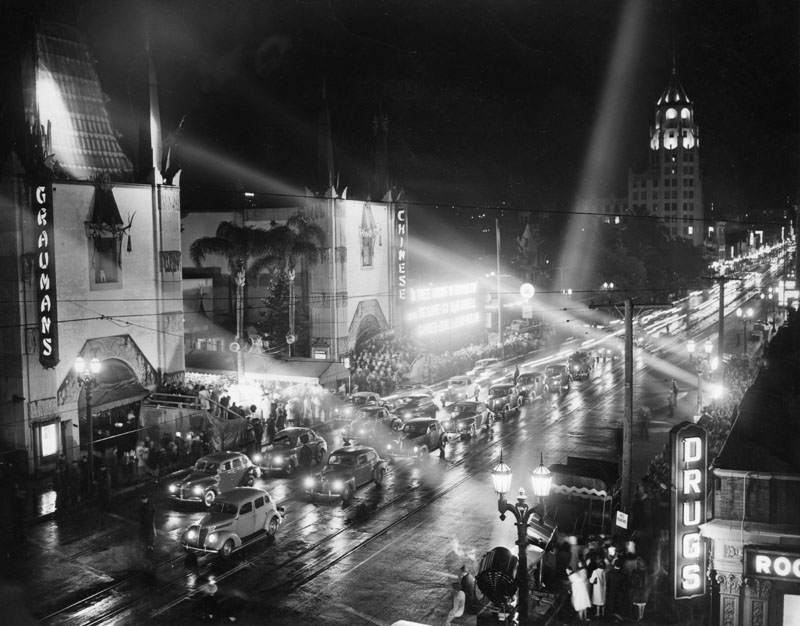 |
|
| (1944)* – View of the Grauman's Chinese Theatre just prior to the 16th Annual Academy Awards of Merit ceremony, Thursday, March 2, 1944. |
Historical Notes Originally handed out at a formal banquet at either the Ambassador Hotel in the Cocoanut Grove or Fiesta Room, or at the Biltmore Hotel downtown, in the Sala D'Oro or Biltmore Bowl, the enormity of interest in the Oscars outgrew the formal banquet idea. When it came time to hold the ceremony in a regular theatre environment, Grauman's Chinese was the obvious choice. Widely considered Hollywood's "town hall," for the first ceremony held there on Thursday, March 2, 1944, the theatre was donated for the event by Charles Skouras, president of National Theatres, whose Fox West Coast Theatres division operated the Chinese, with Sid Grauman as the theatre's Managing Director. ++## |
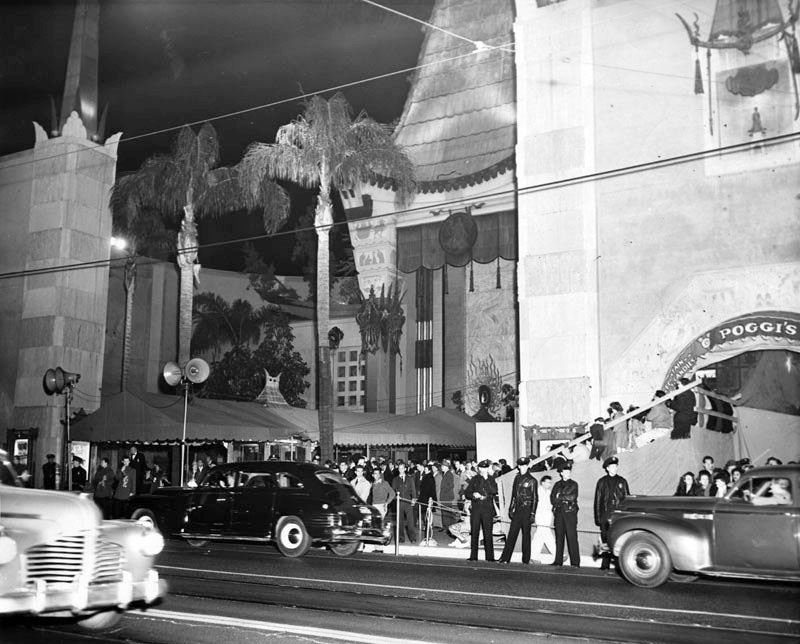 |
|
| (1946)* - Stars arrive at Grauman's Chinese Theater for the Academy Awards presentation on March 8, 1946. |
Historical Notes This was the year that “Lost Weekend” won Best Picture, Best Director, Best Actor in a Leading Role, and Best Screenplay. If these people were hoping to see Joan Crawford, they were disappointed. She was so freaked out at the thought of losing that she pretended to be ill—and then won the Oscar for “Mildred Pierce.” #**# |
.jpg) |
|
| (1946)* – Thousands of movie fans crowded the front of Grauman's Chinese Theater in which the Academy Awards presentation was held. This is a section of the huge crowd as they watched the parade of stars arriving at the theater on March 8, 1946. |
Historical Notes National Theatres continued to make the Chinese Theatre available to the Academy for their Awards of Merit program at no cost, in 1944, 1945 and 1946. In short time the ceremony had outgrown even Sid's Hollywood masterwork, so it moved to the 6,000 plus-seat Shrine Auditorium near downtown for 1947 and 1948. ++## |
 |
|
| (ca. 1960)* - Name of the star-crossed beauty is emblazoned on the sidewalk of Hollywood Boulevard. |
Historical Notes The Hollywood Walk of Fame comprises more than 2,500 five-pointed terrazzo and brass stars embedded in the sidewalks along 15 blocks of Hollywood Boulevard and three blocks of Vine Street. Locations of individual stars are not necessarily random or arbitrary. Stars of most legendary and world-famous celebrities—the so-called "show business royalty"—are found in front of TCL (formerly Grauman's) Chinese Theatre. Oscar winners' stars are usually placed near the Dolby Theatre, site of the annual Academy Awards presentations. Location decisions are made by the Hollywood Chamber of Commerce.*^ |
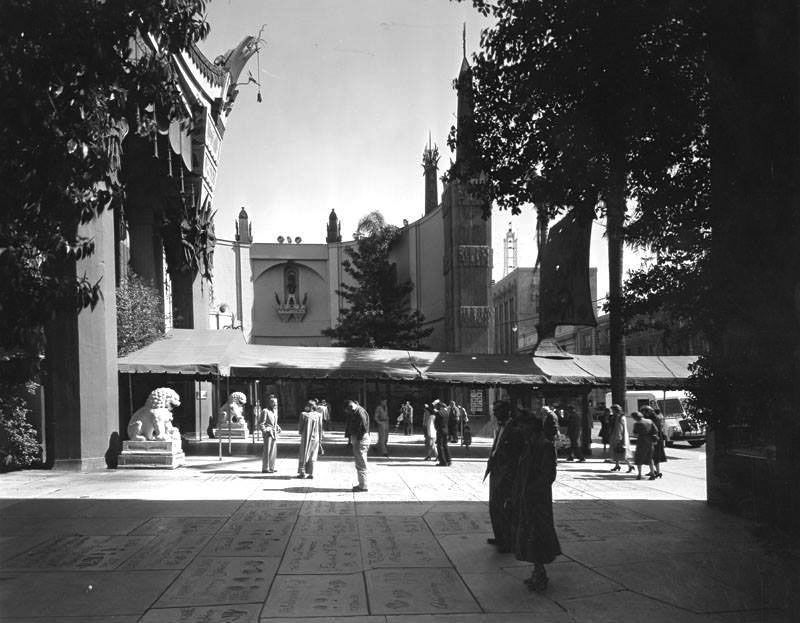 |
|
| (1950s)#**# – View showing the forecourt of Grauman’s Chinese Theatre where visitors are trying to find the footprints of their favorite star and marvel at how small their handprints were. |
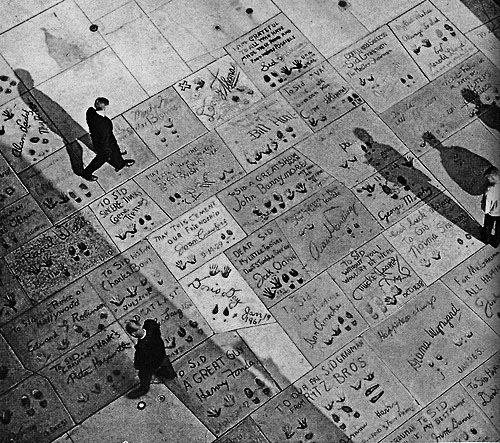 |
|
| (1962)#**# – Aerial view looking down at the foot and hand prints outside the Grauman’s Chinese Theatre. |
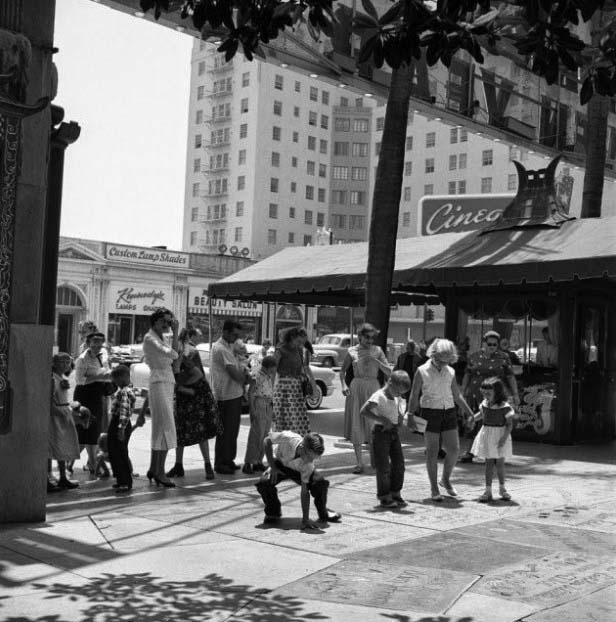 |
|
| (ca. 1960)^##* – View showing tourists standing in the forecourt of the Grauman’s Chinese Theatre. A boy is seen comparing his hand to the handprint of a Hollywood star. |
Roosevelt Hotel
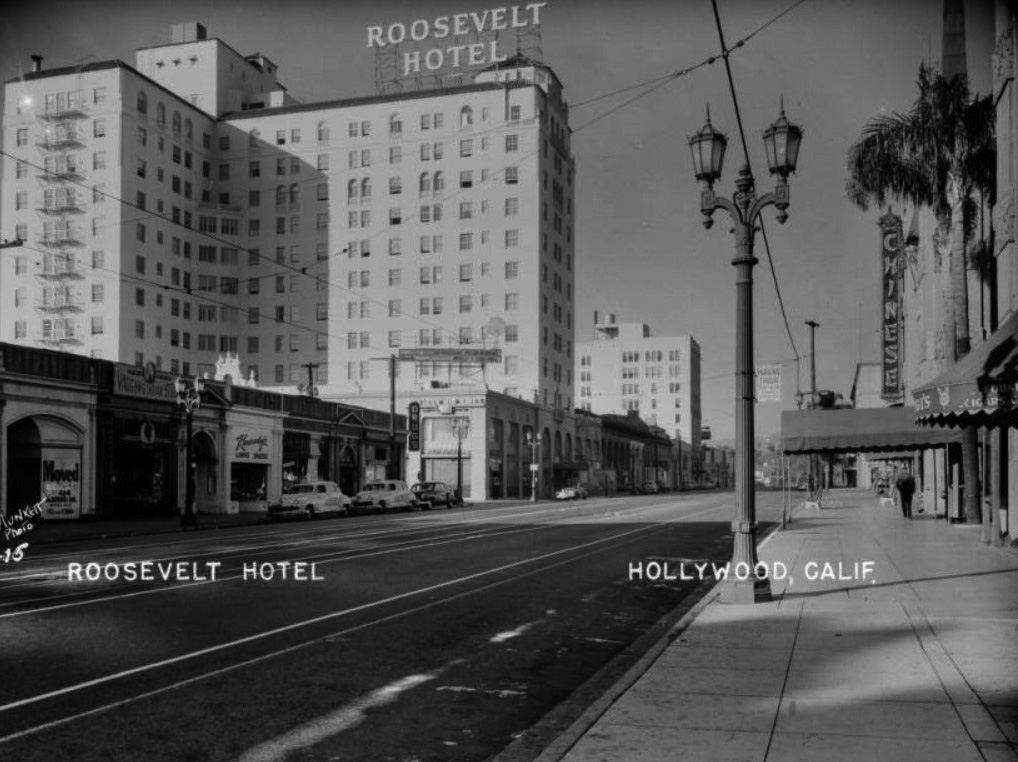 |
|
| (1947)^** – Early morning postcard view of Hollywood Boulevard with no traffic showing the Roosevelt Hotel. Signs along the street read "Moved to Rodeo Dr., Beverly Hills" "Vaughn's Indian Store" "Kennedy's Lamps Shades" "Roosevelt Drug Co." "Drugs" "Western Airlines" "Outstanding Entertainment Cinegrill" and "Chinese" (in front of Grauman's Chinese Theatre at right). |
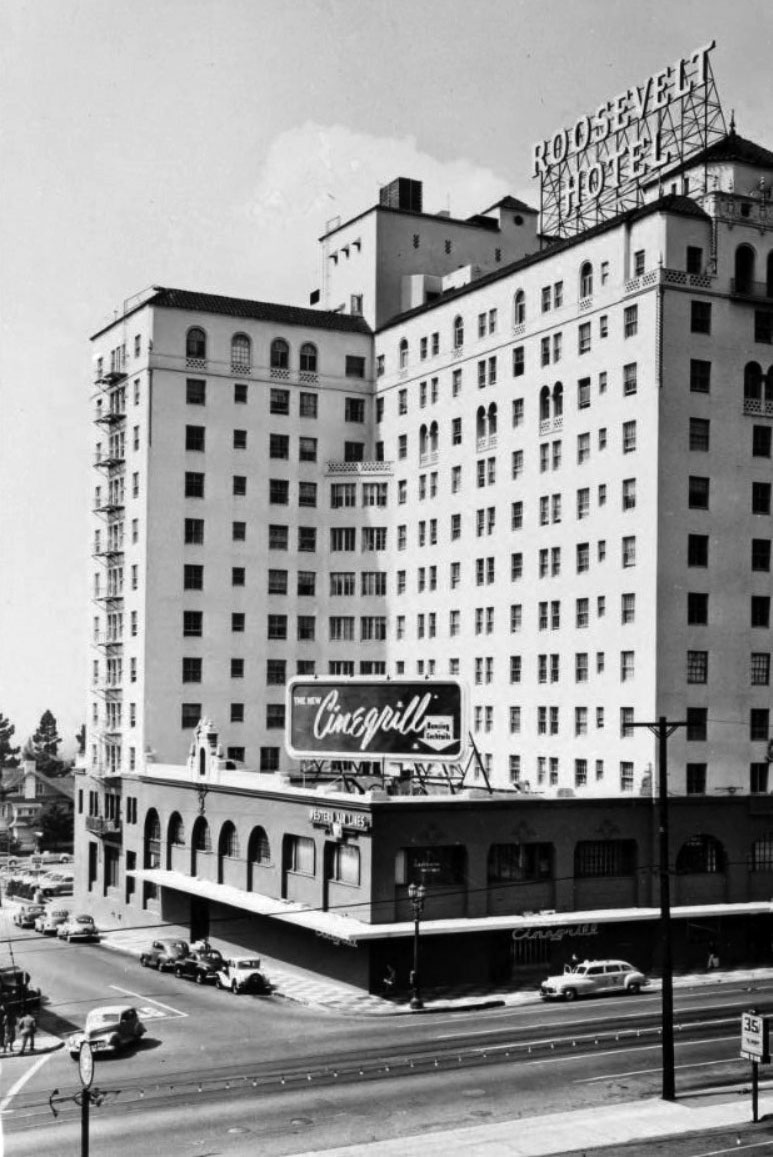 |
|
| (1949)*^#* – View of the Hollywood Roosevelt Hotel on the southwest corner of Orange Drive and Hollywood Boulevard, located across the street from and a short block away from Grauman's Chinese Theatre. |
Historical Notes Marilyn Monroe was a resident at the Hollywood Roosevelt for two years when her modeling career took off. Her first magazine shoot was taken in the Roosevelt. Clark Gable and Carole Lombard paid five dollars a night for their penthouse; it is now named the Gable & Lombard Penthouse. There is also a Marilyn Monroe Suite at the hotel.*^ |
 |
 |
|
| (1949)*^#* - Hollywood Roosevelt Hotel - Day View | (1949)^*^^ – Hollywood Roosevelt Hotel – Night View |
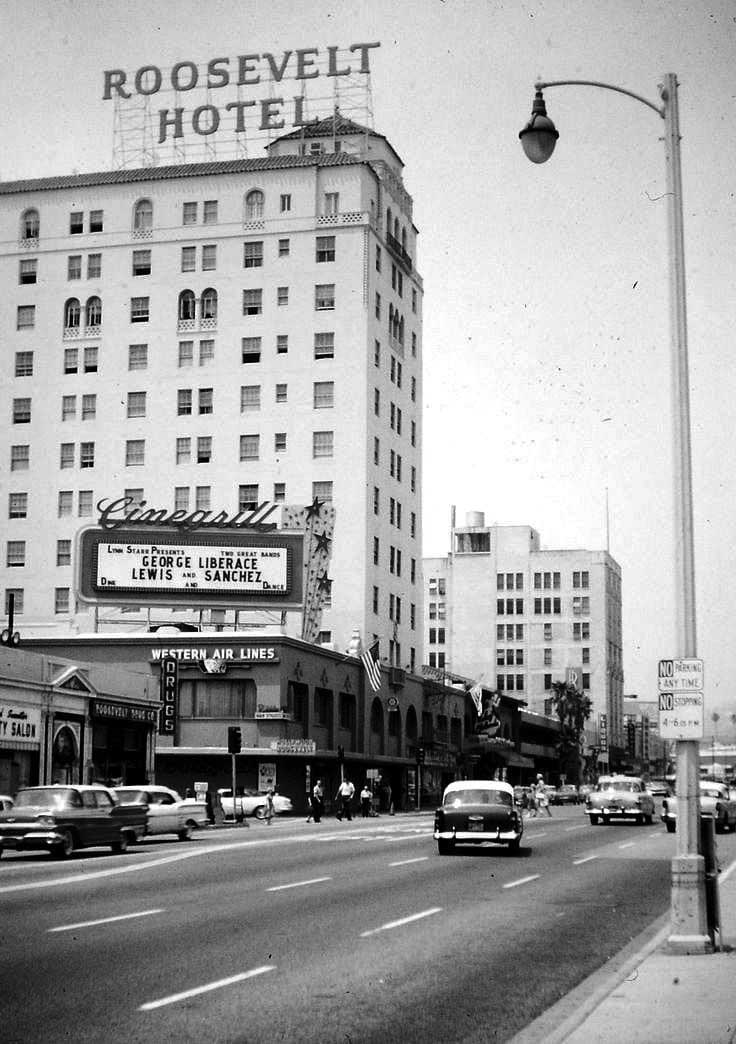 |
|
| (ca. 1958)* - The Roosevelt Hotel at 7000 Hollywood Boulevard. |
 |
|
| (1950s)#^* – “Fun Map of Playland – As you see it from the Roosevelt Hotel." |
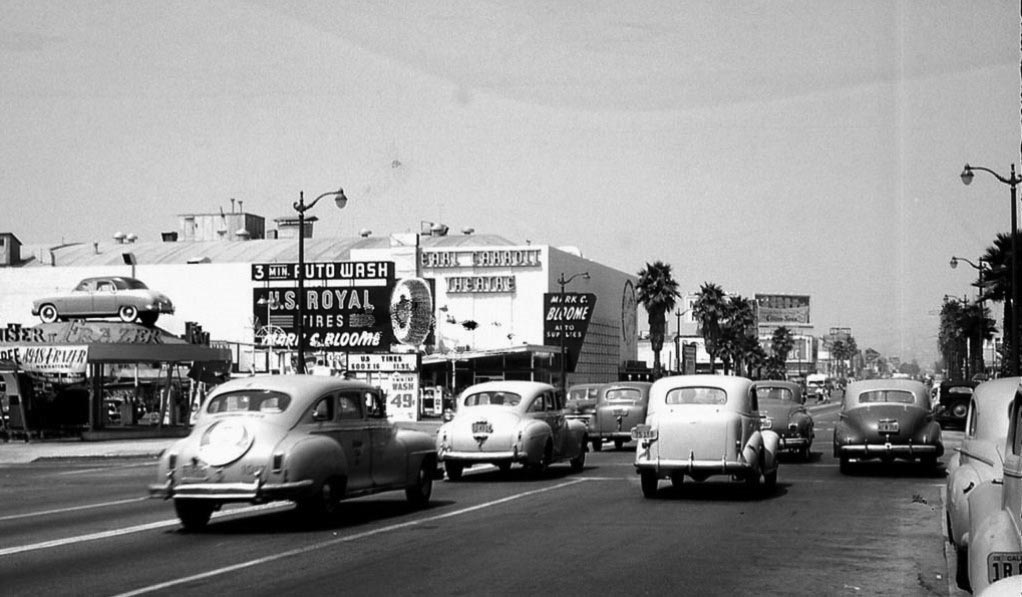 |
|
| (1948)^##* – View looking west on Sunset Boulevard at N. El Centro Ave. The Earl Carroll Theatre can be seen in the distance, with Mark C. Bloome Tires on the left. The Hollywood Palladium is just out of view to the right. |
CBS Columbia Square
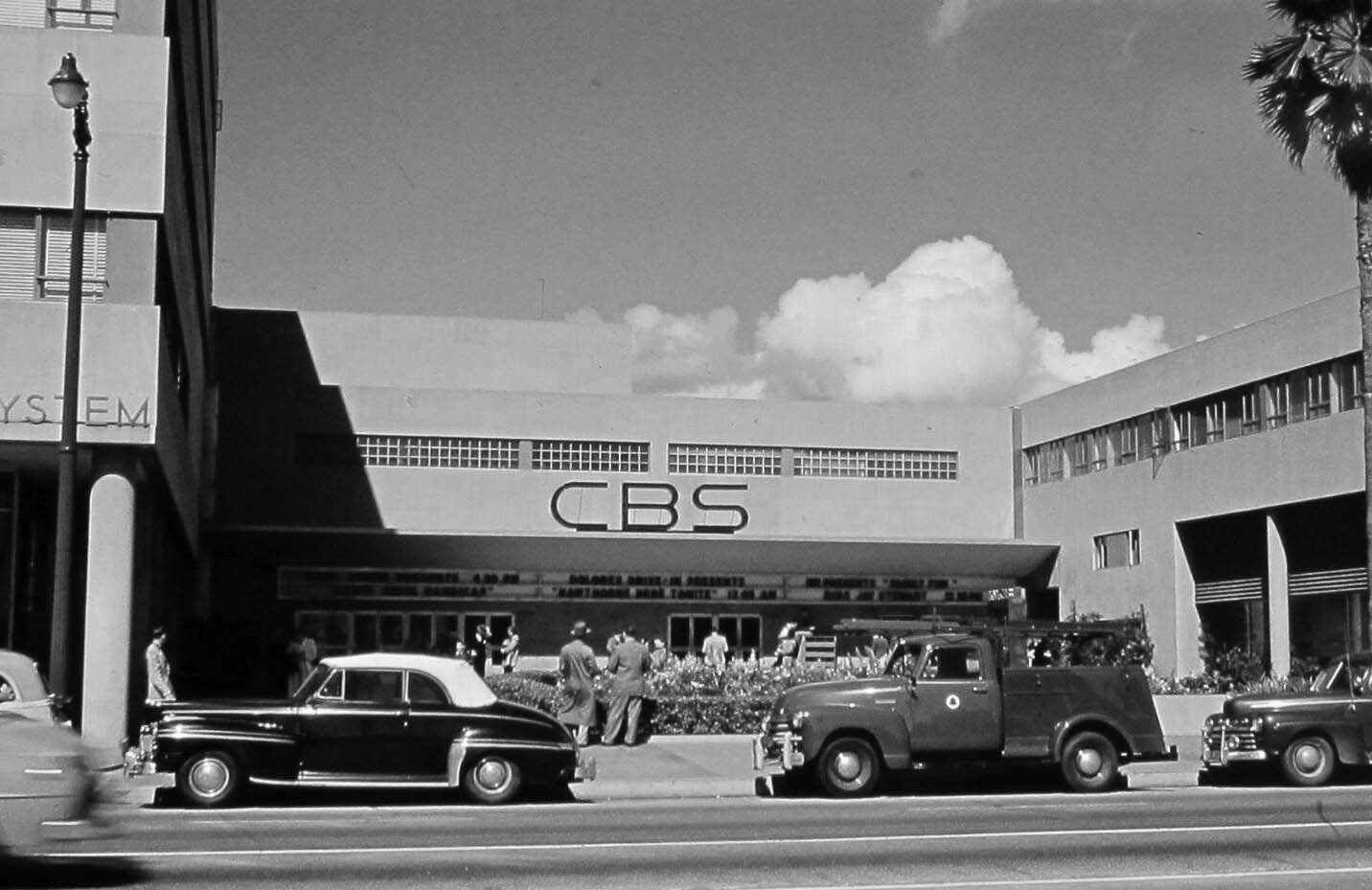 |
|
| (ca. 1948)##^* – Close-up view showing the entrance to CBS Columbia Square located at 6121 Sunset Boulevard. Note the early model phone company truck parked in front. |
Historical Notes From 1938 to 2007, Columbia Square was home of CBS's L.A./west coast radio/tv operations. It was also home to radio stations KNX 1070 and KCBS 83FM. The historic site is currently under redevelopment. |
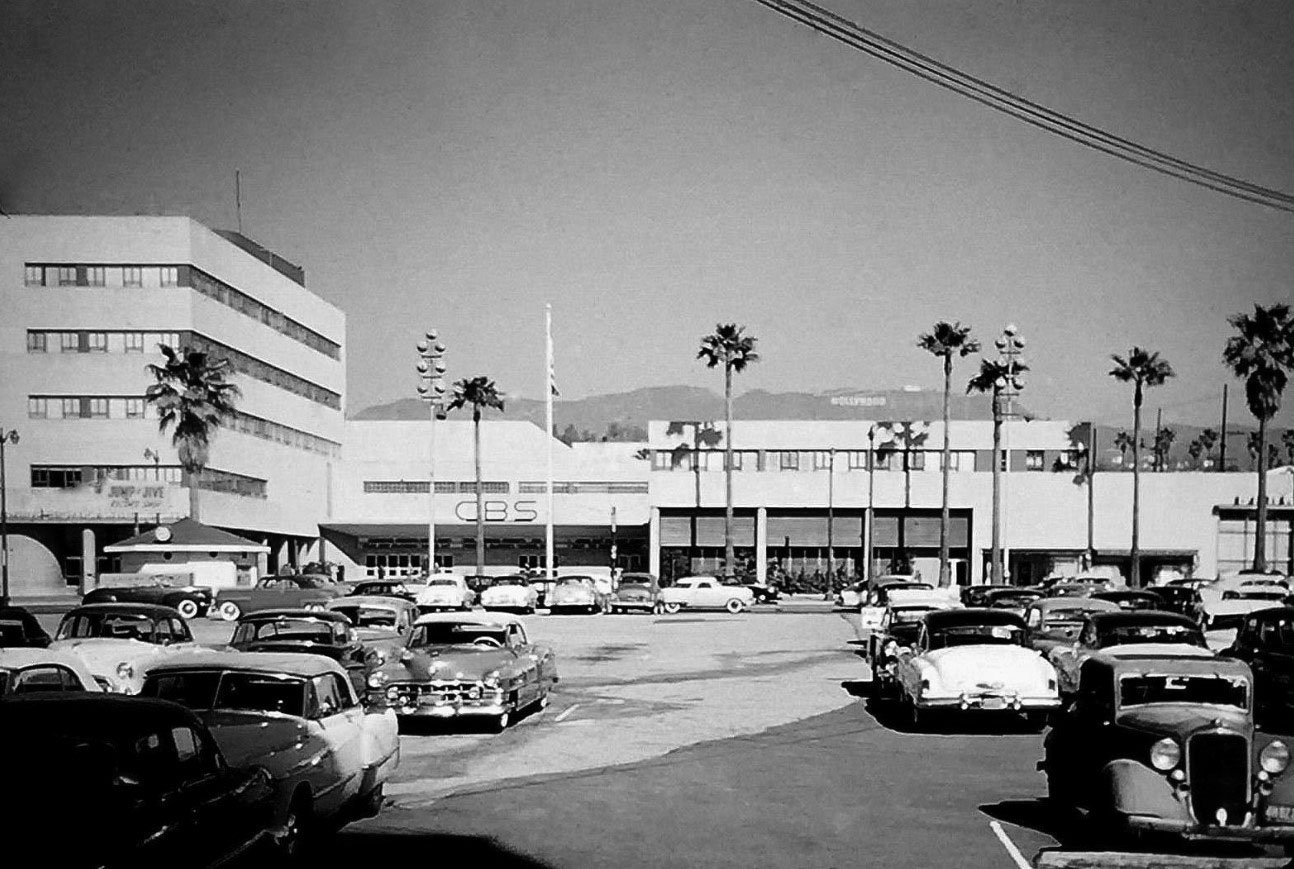 |
|
| (ca. 1951)*^^* – View of CBS Columbia Square looking north from the Gower Gulch shopping center, close to where Denny’s currently is at Sunset and Gower. The Hollywood Sign is seen in the distance. |
* * * * * |
Vista Theatre
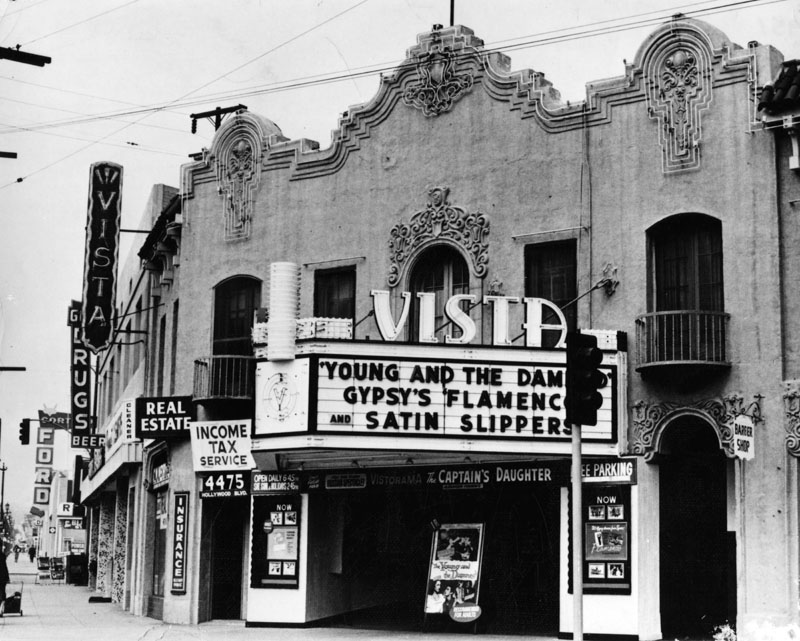 |
|
| (1951)* - View showing the Vista Theatre located at 4473 Sunset Drive, East Hollywood. Note the architectural design details (Spanish Colonial Revival Style) on the face of the building. Architect: Lewis A. Smith. |
Historical Notes Vista Theatre opened on October 16, 1923, as a single-screen theater. In addition to screening films, the theater also showed vaudeville acts on stage. Originally known as Lou Bard Playhouse on opening day in 1923, the cinema played the film Tips with Baby Peggy. It is one of the remaining historic structures from the 1920s, when Hollywood was first built up and began attracting residents to its new suburban homes from areas near downtown Los Angeles and East Los Angeles, at the time middle and wealthy class sections of Los Angeles.*^ |
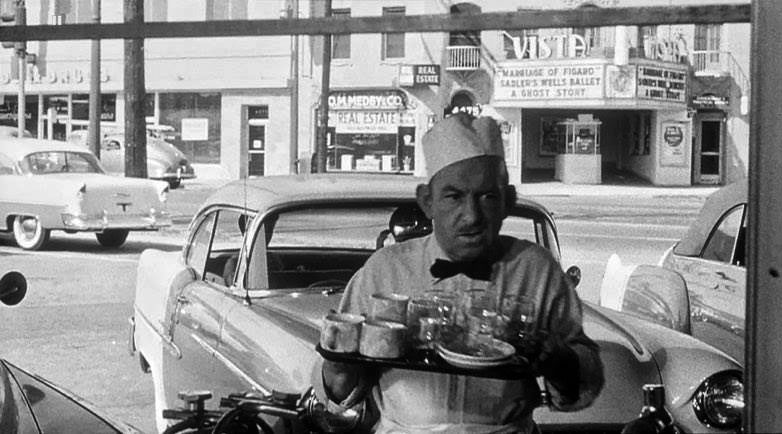 |
|
| (1955)^v^ - A shot of the Vista Theatre from inside Stan's Drive-in Restaurant seen in "The Crooked Web" (Columbia, 1955). Thanks to Jonathan Raines for the screenshot. |
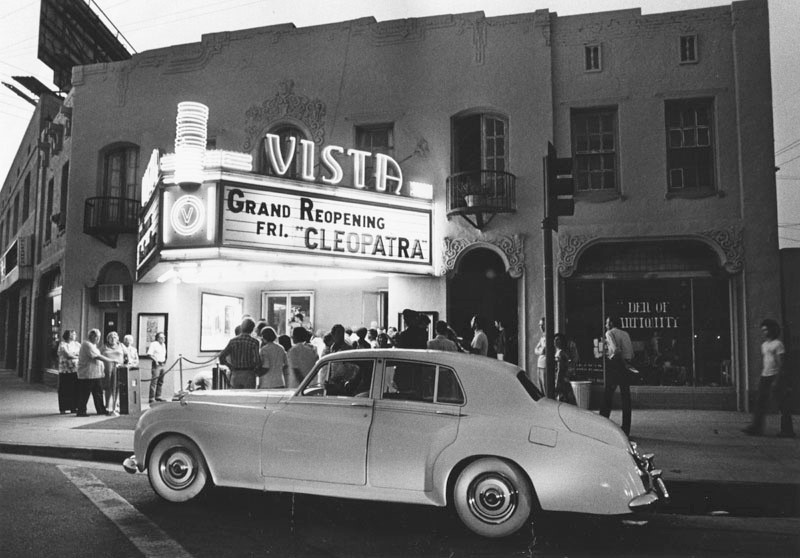 |
|
| (1980)* - A crowd of people stand at the entranceway awaiting the grand reopening of the Egyptian revival style Vista Theatre, featuring the 1934 version of "Cleopatra." Silent-film star Mary MacLaren (1896-1985) helped re-open the Vista. Baby Peggy came back: In 1923 she opened the theater. |
Historical Notes Standing at the "five corners" intersection of Hollywood Blvd, Sunset Blvd, Sunset Drive, Virgil Ave and Hillhurst Ave, the Vista is listed as being in Los Feliz, but some locals will tell you "even the Los Feliz Theatre isn't in Los Feliz!" They say its East Hollywood, and in fact, old pictures of the theatre show the words "VISTA, EAST HOLLYWOOD" in neon on the rooftop sign and on the marquee. In a manner reminiscent of Grauman's Chinese Theatre, the theater's forecourt features cement handprints and footprints of notable film figures. However, the handprints and footprints at the Vista Theatre tend to include more icons of independent and cult films such as Spike Jonze, John C. Reilly and Martin Landau, among many others.*^ |
* * * * * |
Hollywood Boulevard
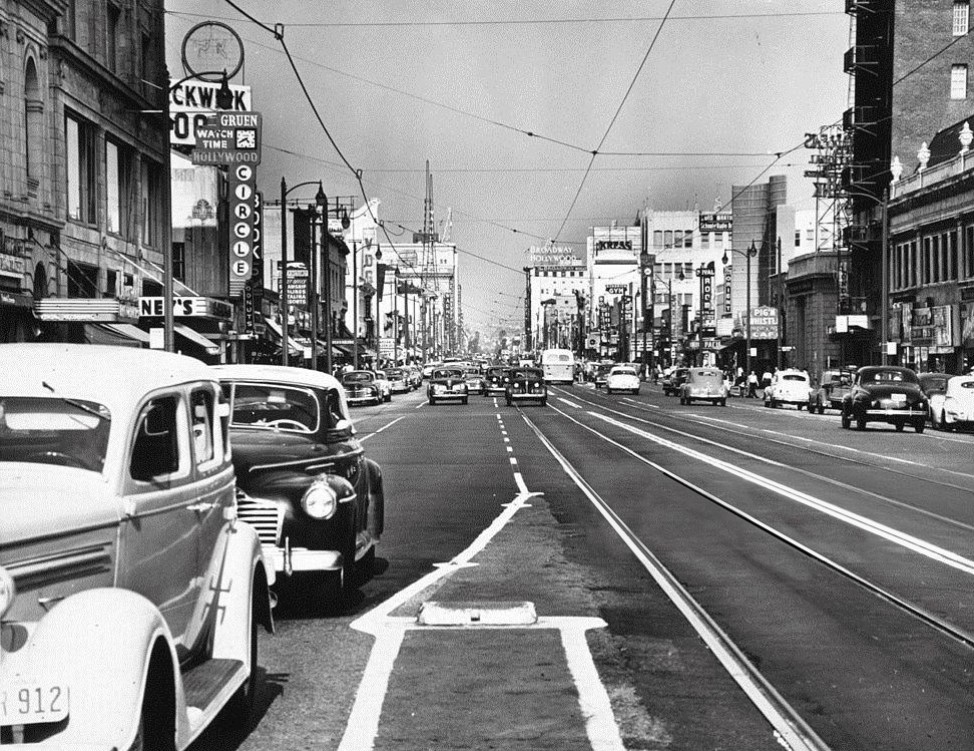 |
|
| (1950)* – View looking east on Hollywood Boulevard from N. McCadden Place. Some of the distinguishable signs include: Pickwick Book Store, Vogue Theatre, and The Broadway-Hollywood. Note the overhead streetcar wires running along the Boulevard. |
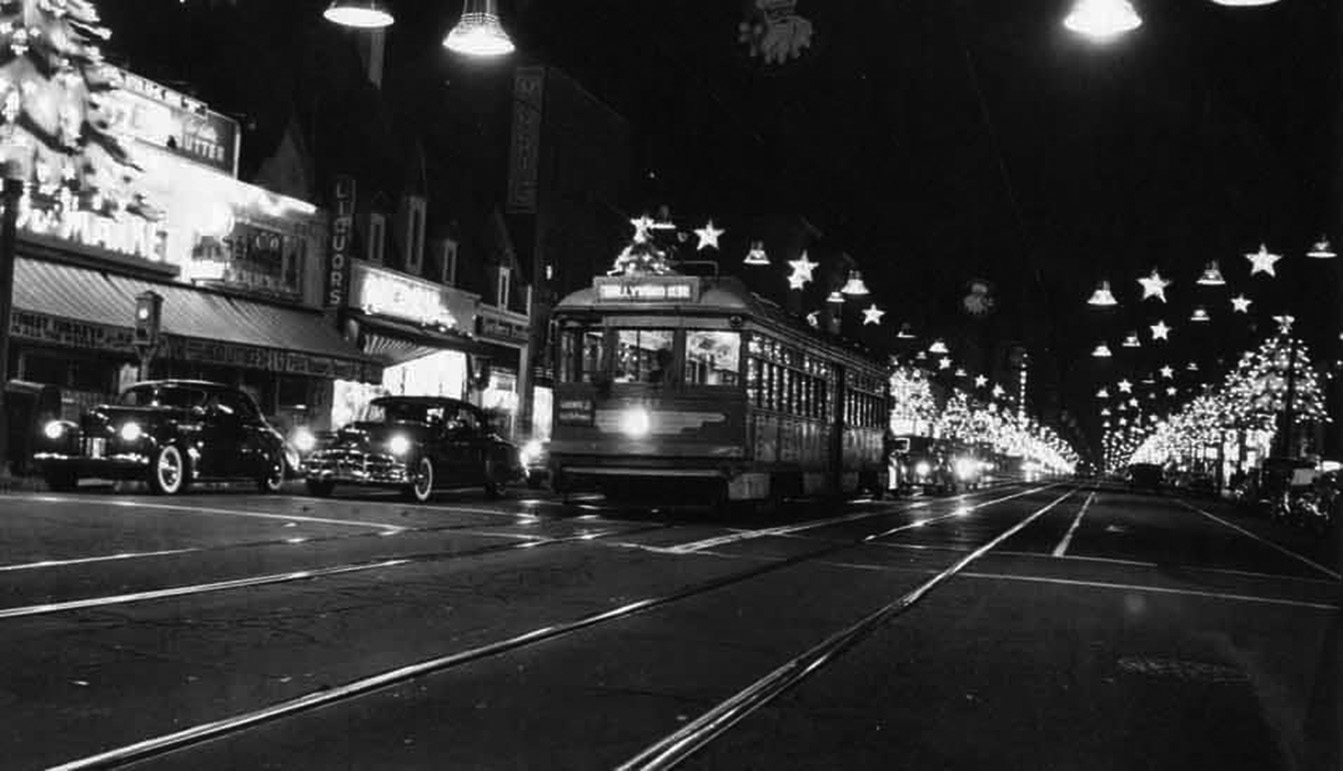 |
|
| (1950s)* - Streetcar down the center of Hollywood Boulevard during the holiday season. |
Historical Notes September 26, 1954 was the last day for streetcar service on Hollywood Boulevard. |
Hollywood and Highland
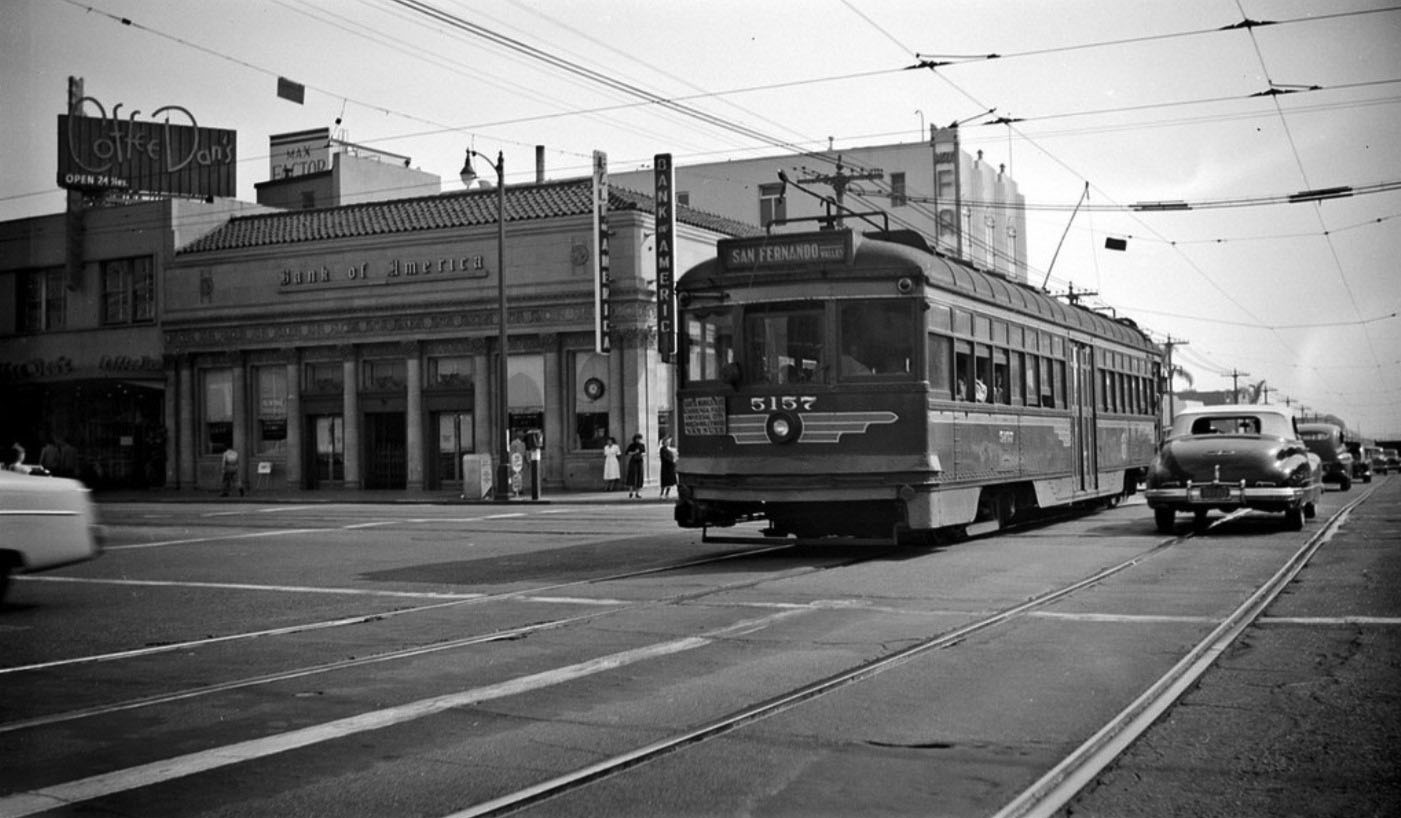 |
|
| (ca. 1950)*^* – View looking south on Highland Avenue at Hollywood Boulevard showing the Van Nuys Line Red Car heading north toward Cahuenga Pass and the San Fernando Valley. The Bank of America Building and Coffee Dan’s are on the left with the Max Factor Building seen behind the streetcar. |
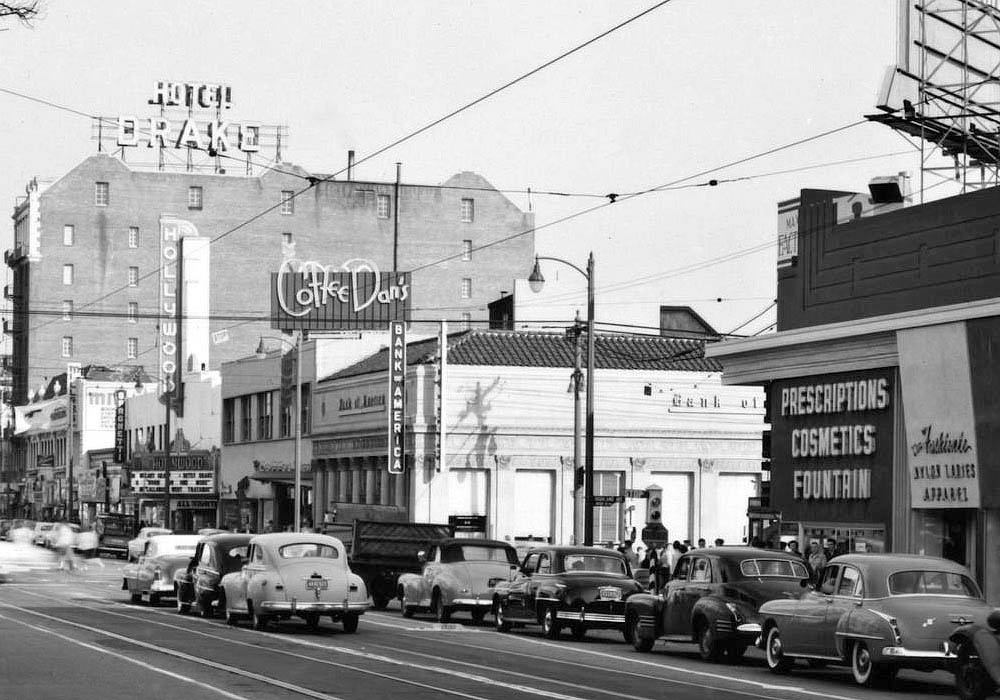 |
|
| (ca. 1950)*# – View looking southeast showing the intersection of Hollywood and Highland. Several businesses can be seen on the south side of Hollywood Boulevard including: Bank of America, Coffee Dan’s, Hollywood Theatre, the Hotel Drake (formerly the Hotel Christie). |
Historical Notes Today, Bank of America is a Ripley’s Believe it or Not, Coffee Dan’s is a McDonalds, the Hollywood Theater is the Guinness World Records Museum, and the Hotel Drake is a Scientology center. Click HERE for contemporary vi |
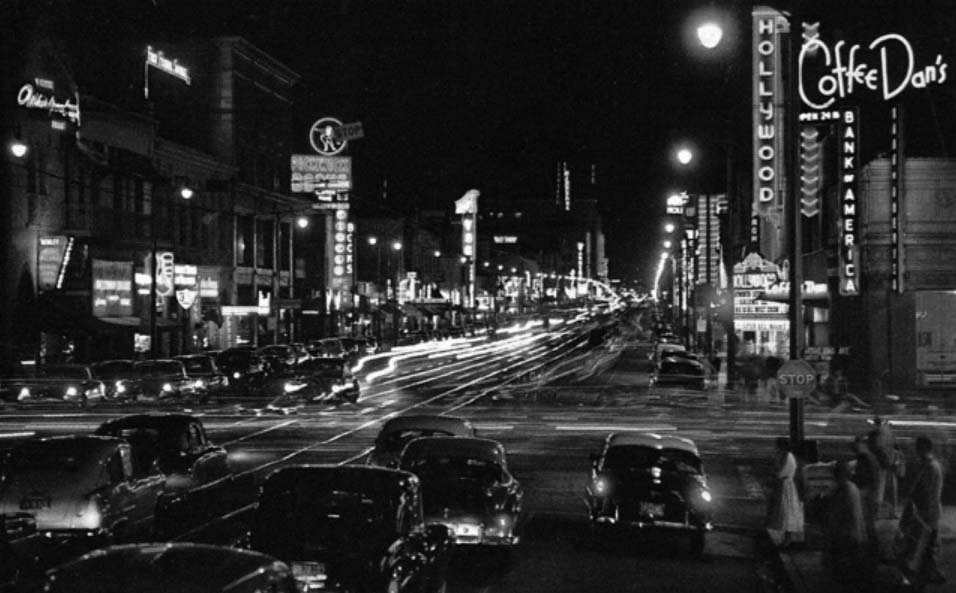 |
|
| (1950s)*^#^* - Postcard nighttime view looking east on Hollywood Boulevard at Highland Avenue showing Coffee Dan's between the Bank of America and the Hollywood Theatre. Note the Stop sign at lower right. |
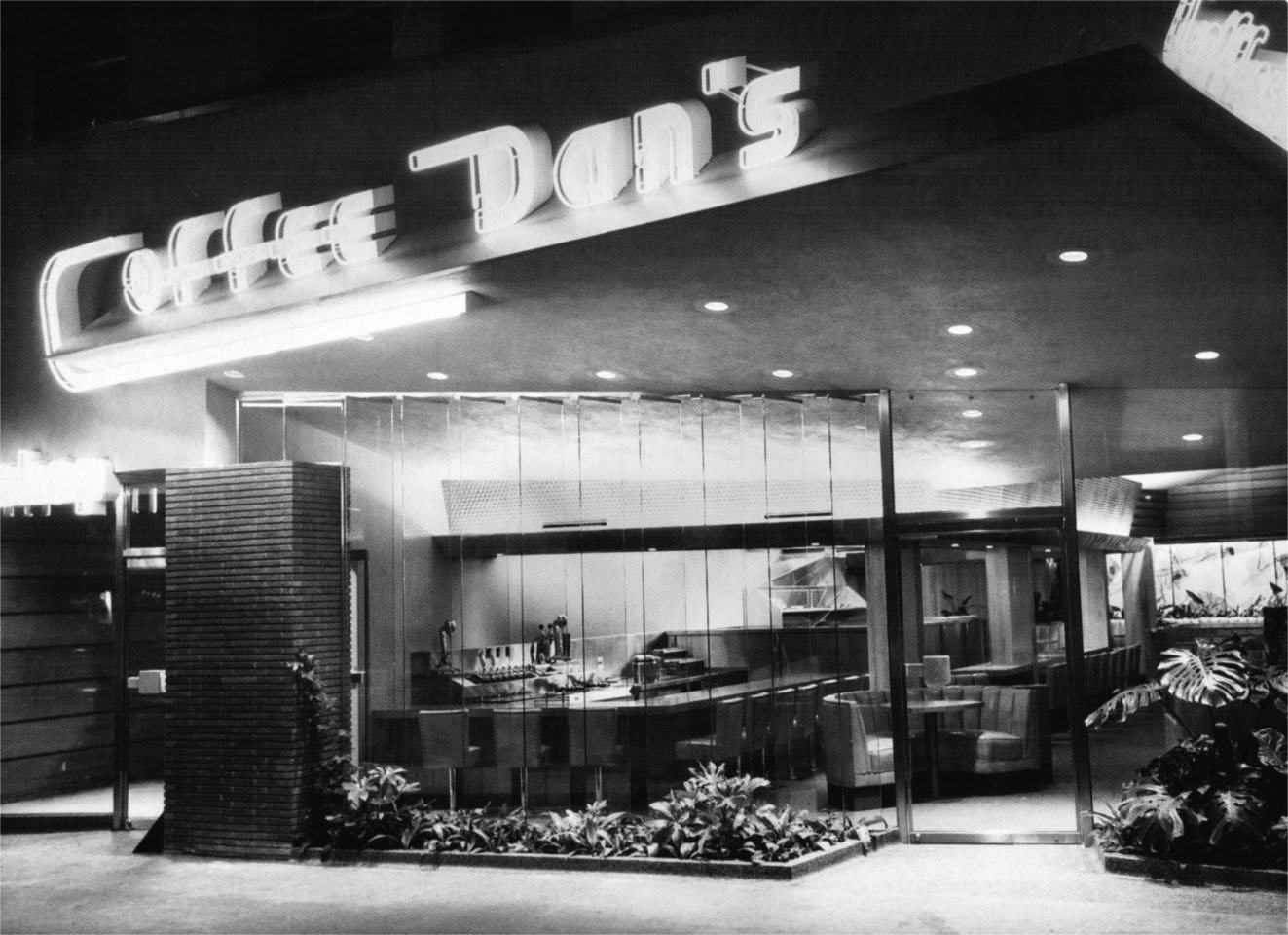 |
|
| (1950)*# – View showing the front entrance to Coffee Dan’s restaurant near the intersection of Hollywood Boulevard and Highland Avenue. |
Historical Notes Alan Hess, the author of Googie: Fifties Coffeeshop Architecture, traces Googie Architecture back to three Coffee Dan's restaurants designed by John Lautner in the early forties. "He selected the vaults and glass walls and trusses and angles of his buildings to fit the original, often unusual, concepts of space he favored," writes Hess. |
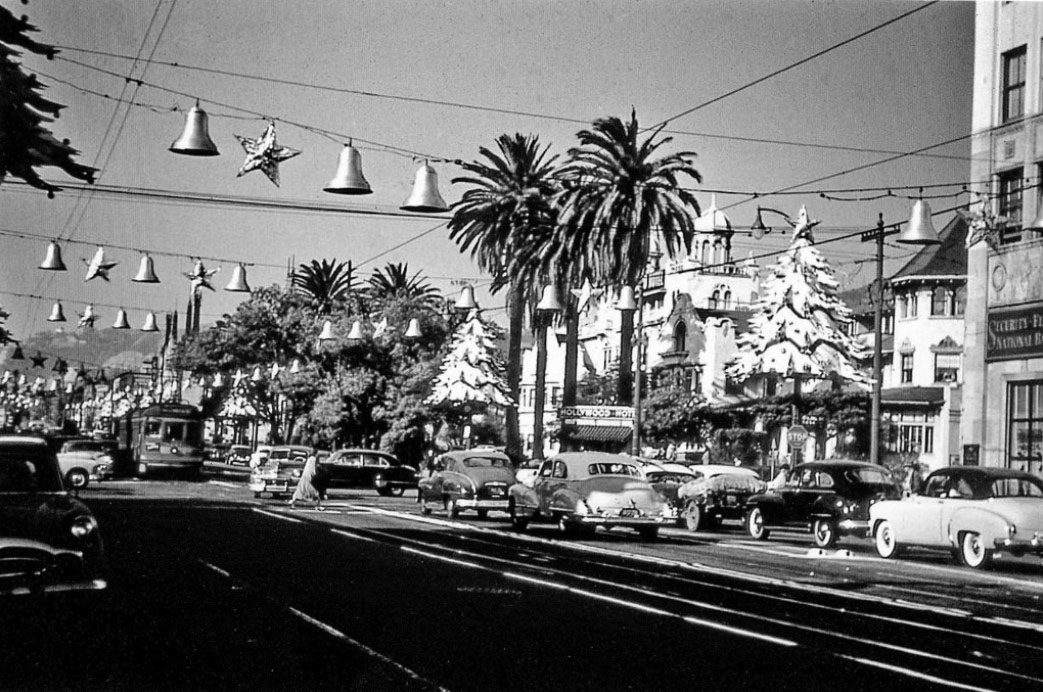 |
|
| (1953)^##* – View looking west on Hollywood Boulevard at Highland during the holidays with the Hollywood Hotel at right. Note the Stop sign on the corner. |
Then and Now
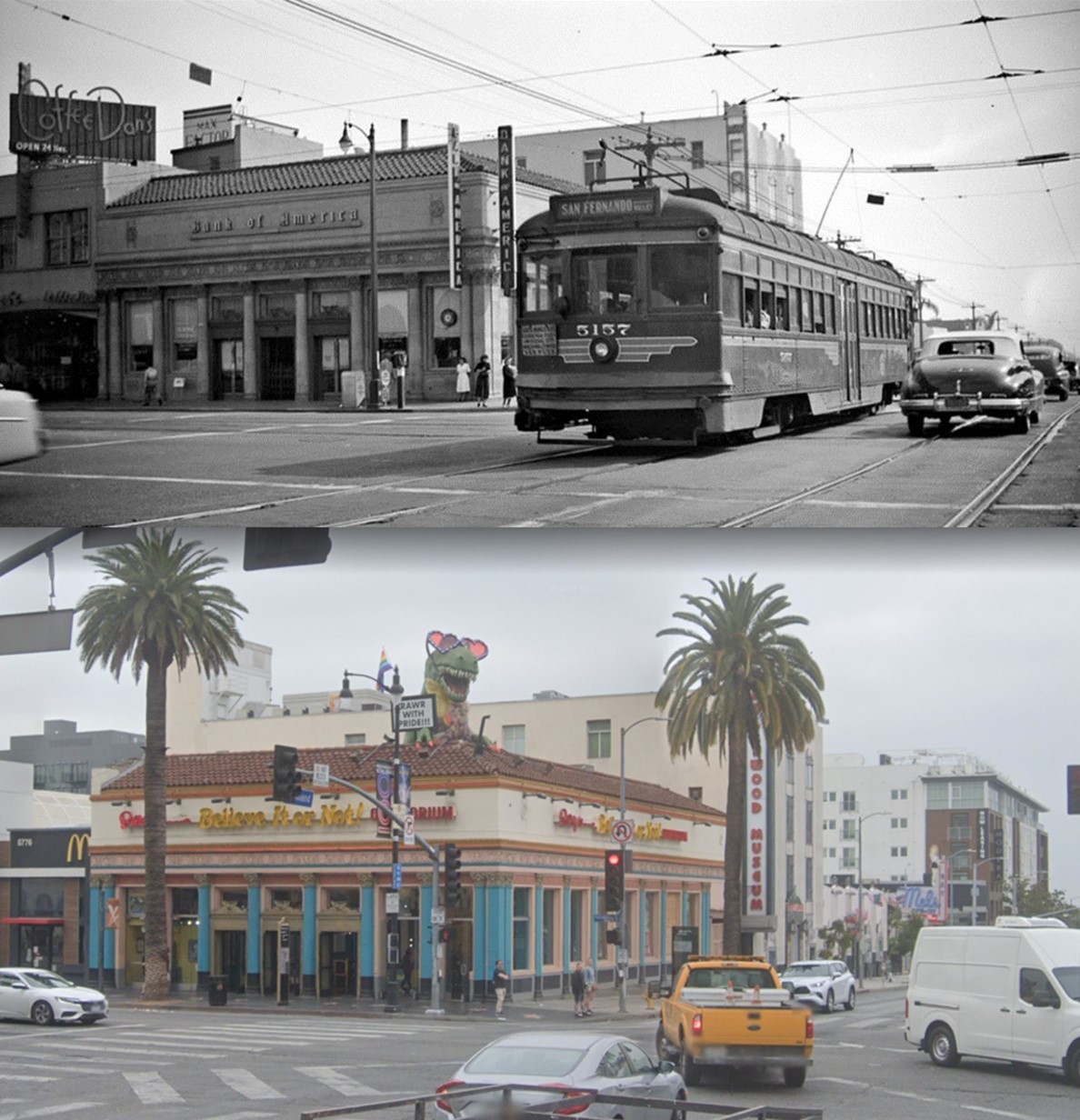 |
|
| (1950 vs 2022)* – Looking south on Highland Avenue at Hollywood Boulevard showing the Van Nuys Line Red Car heading north toward Cahuenga Pass and the San Fernando Valley. The Bank of America Building (now Ripley's Believe It or Not!) and Coffee Dan’s are on the left with the Max Factor Building seen behind the streetcar. |
Pacific Electric Red Cars
 |
|
| (1952)#**# - A Red Car makes its way south along Highland Avenue and pulls up at the corner of Hollywood Boulevard. To the left, we can see the eastern edge of the Hollywood Hotel. Pretty much the only building still standing today is the Hollywood United Methodist Church seen in the distance. |
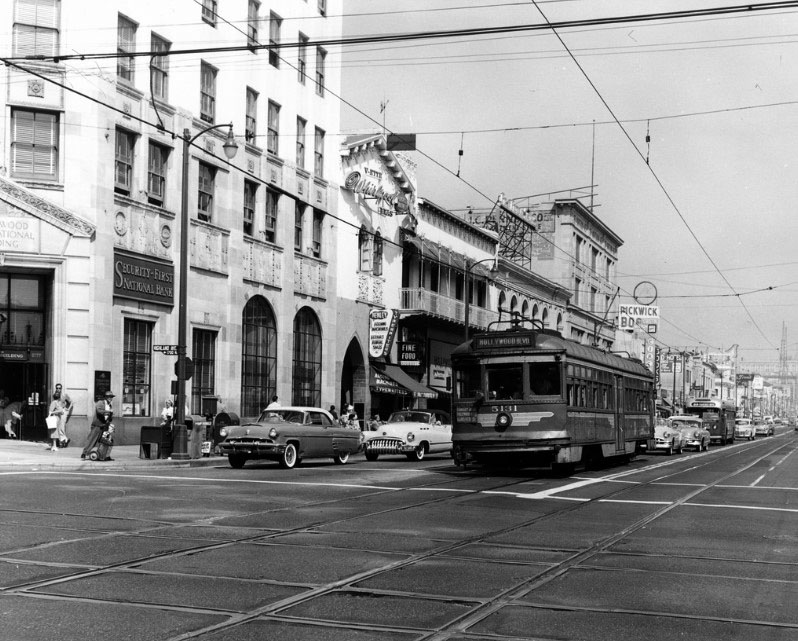 |
|
| (ca. 1954)*^* – View showing a Pacific Electric streetcar westbound on Hollywood Boulevard at Highland Avenue. Pickwick Book Store at 6743 Hollywood Boulevard can be seen at center-right. |
Historical Notes Russian immigrant Louis Epstein started Pickwick in 1938. The store, named after Charles Dickens' classic "The Pickwick Papers," soon became a favorite haunt of movie stars and bibliophiles. Click HERE to see more. |
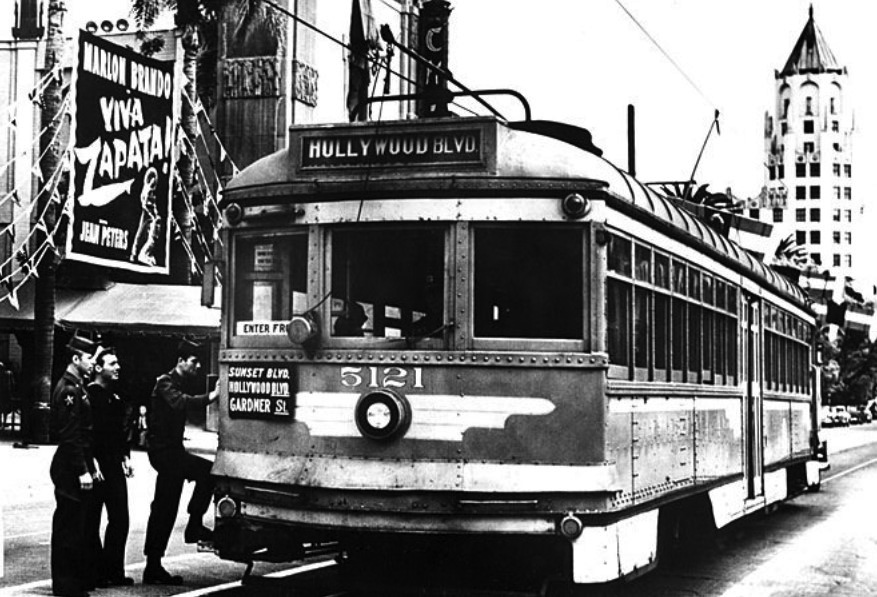 |
|
| (1952)^##* - Three uniformed soldiers board the westbound 5121 at Hollywood Boulevard and N. Orange Drive with Grauman's Chinese Theatre and First National Bank seen in the background. The Chinese Theatre is showing Viva Zapata! starring Marlon Brando. |
Historical Notes Viva Zapata! is a 1952 biographical film starring Marlon Brando and directed by Elia Kazan. The screenplay was written by John Steinbeck, using as a guide Edgcomb Pinchon's book, Zapata the Unconquerable. The cast includes Jean Peters and, in an Academy Award-winning performance, Anthony Quinn. The movie is a fictionalized account of the life of Mexican Revolutionary Emiliano Zapata from his peasant upbringing, through his rise to power in the early 1900s, to his death.*^ |
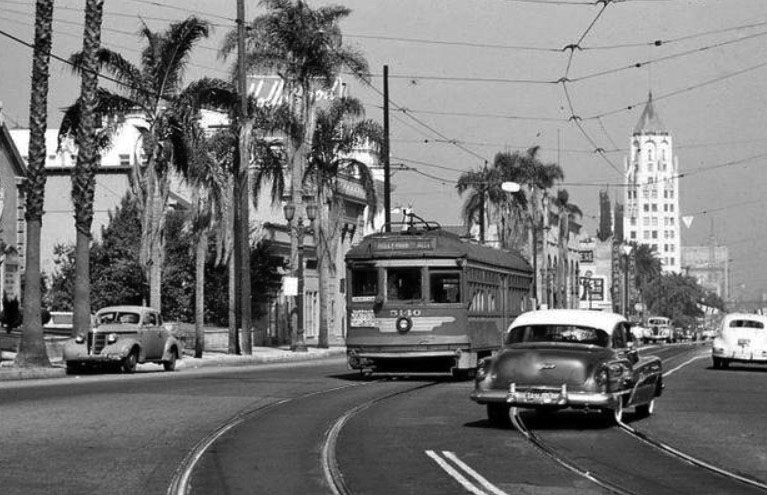 |
|
| (ca. 1953)#**# - View looking east on Hollywood Boulevard from the corner of La Brea Avenue. Both Grauman's Chinese Theatre and Hollywood First National Bank can be seen in the background. A Pacific Electric streetcar appears to be turning onto LA Brea but is actually turning into a private right-of-way heading toward Santa Monica and Fairfax. |
Historical Notes To get from Hollywood and La Brea to Santa Monica and Fairfax the PE ran on a private way diagonal to the street grid (see map below). |
 |
|
| (1953)^### – Map showing the routing of Pacific Electric streetcars from Hollywood and La Brea (upper-right) to Santa Monica and Fairfax (lower-left). Note that the tracks make a turn near Gardner Elementary School. |
Historical Notes The tracks ran southwest from La Brea crossing Sunset which was known as "Gardner Junction" and ending at Fairfax turning westbound onto Santa Monica Blvd. |
Gardner Junction
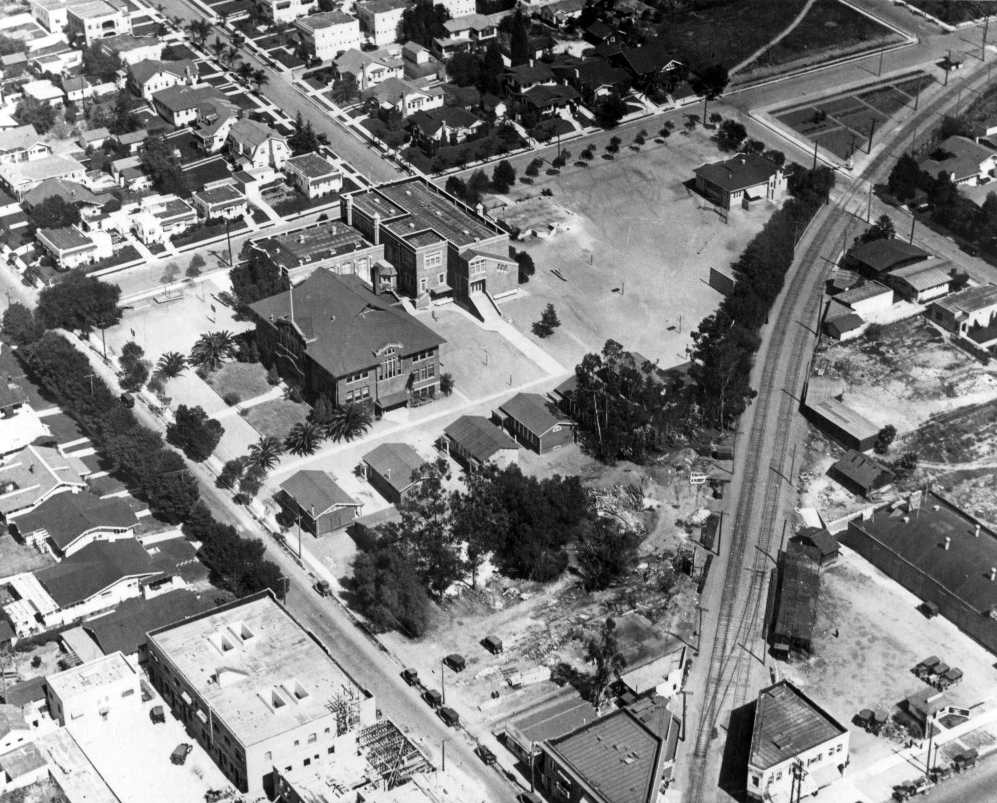 |
|
| (1924)** – Aerial view showing the Gardner Junction (lower-right). Gardner Street runs diagonally from lower-center to upper-left. Part of Sunset can be seen at lower-right corner. Gardner Street Elementary School is at top of photo fronting Hawthorne Street. It’s still at this location to this day. Photo courtesy of Ralph Cantos |
Historical Notes Gardner Junction was so named because of its location at Gardner Street and Sunset Boulevard. At this point, the LAUREL CANYON line diverged from the Hollywood/Beverly Hills main line and headed west along Sunset Boulevard on single track to Laurel Canyon Blvd. where the cars made a connection with the Laurel Canyon "Trackless Trolley", the first such trolley bus service in the USA. Until abandonment of this marginal line on March 10, 1924, Pacific Electric used this line for “short turn” rush hour service of some of the Hollywood Boulevard runs. The Laurel Canyon cars used the cross-over seen at the lower left of the beautiful 1924 photo. This crossover remained in place, although unused, until it was removed around 1947. There was a crossover on the southwest side of Sunset Boulevard that was the normal turn back for the cars at this location. Gardner Street Elementary School is at the top of the photo fronting Hawthorne Street. Its still at this location to this day.** |
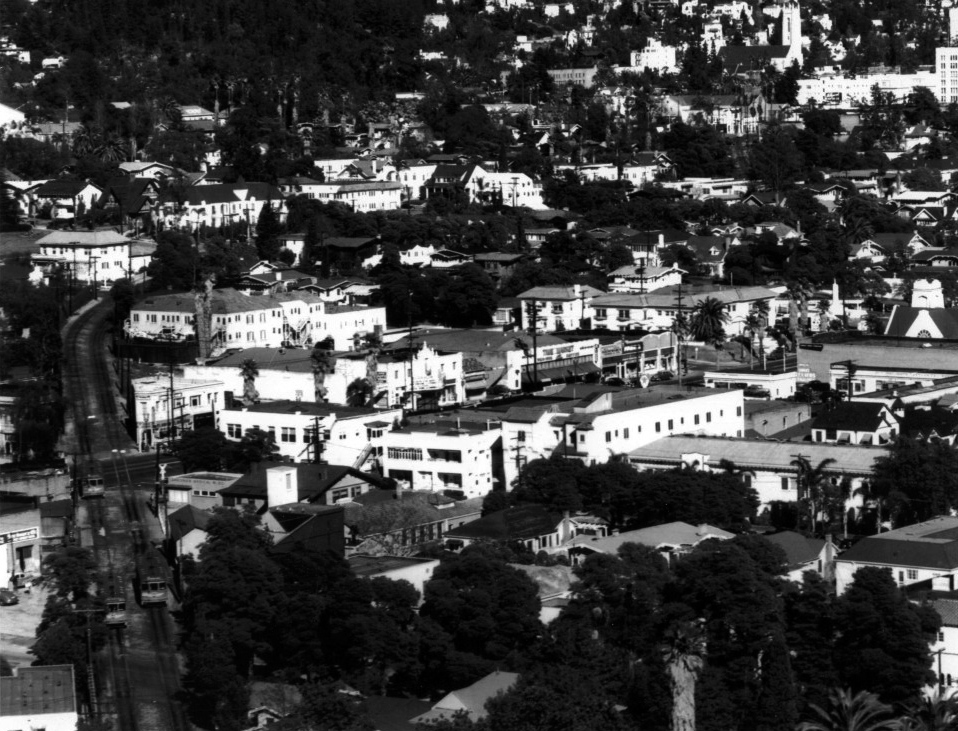 |
|
| (1954)** – Aerial view looking at the Gardner Junction. Three Hollywood streetcars can be seen at lower-left where the tracks cross Sunset Boulevard near Gardner Street. The Oriental Theater can be seen at center-left on Sunset Blvd. Photo courtesy of Ralph Cantos |
Historical Notes Pacific Electric management decided to discontinue two-car rush-hour train service on the Hollywood Boulevard/Beverly Hills line on June 1, 1953. Instead, 4-minute one-car service was provided to Gardner Junction. At this point, every other car turned back, with 7-minute rush hour service to Beverly Hills. This service continued until the line was torpedoed and sunk by Metropolitan Coach Lines on September 26, 1954. Over the next 60 years, the “back yard” private right-of-way (PRW) (from La Brea to Fairfax Avenues) would be sold off, piece by piece, for development of large apartment houses. The very last piece of PRW to be sold for development was done in 2012 and it was the segment of PRW from Vista Street to just short of Sunset Boulevard. This portion of abandoned PRW had sat, undisturbed, behind Gardner Street Elementary School for 58 years. Then in 2012, an enterprising developer removed the fences at each end of this historic piece of PE land, graded the property, and “shoe horned” a row of mobile home-sized “town houses” into the former PRW.** |
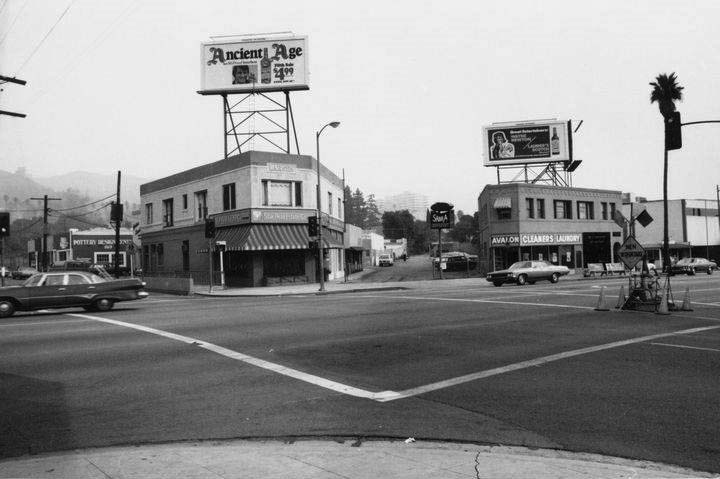 |
|
| (ca. 1972)* – View looking northeast from the corner of Sunset Boulevard and Gardner Street showing the old PE right-of-way now a parking lot. Click HERE to see contemporary view. |
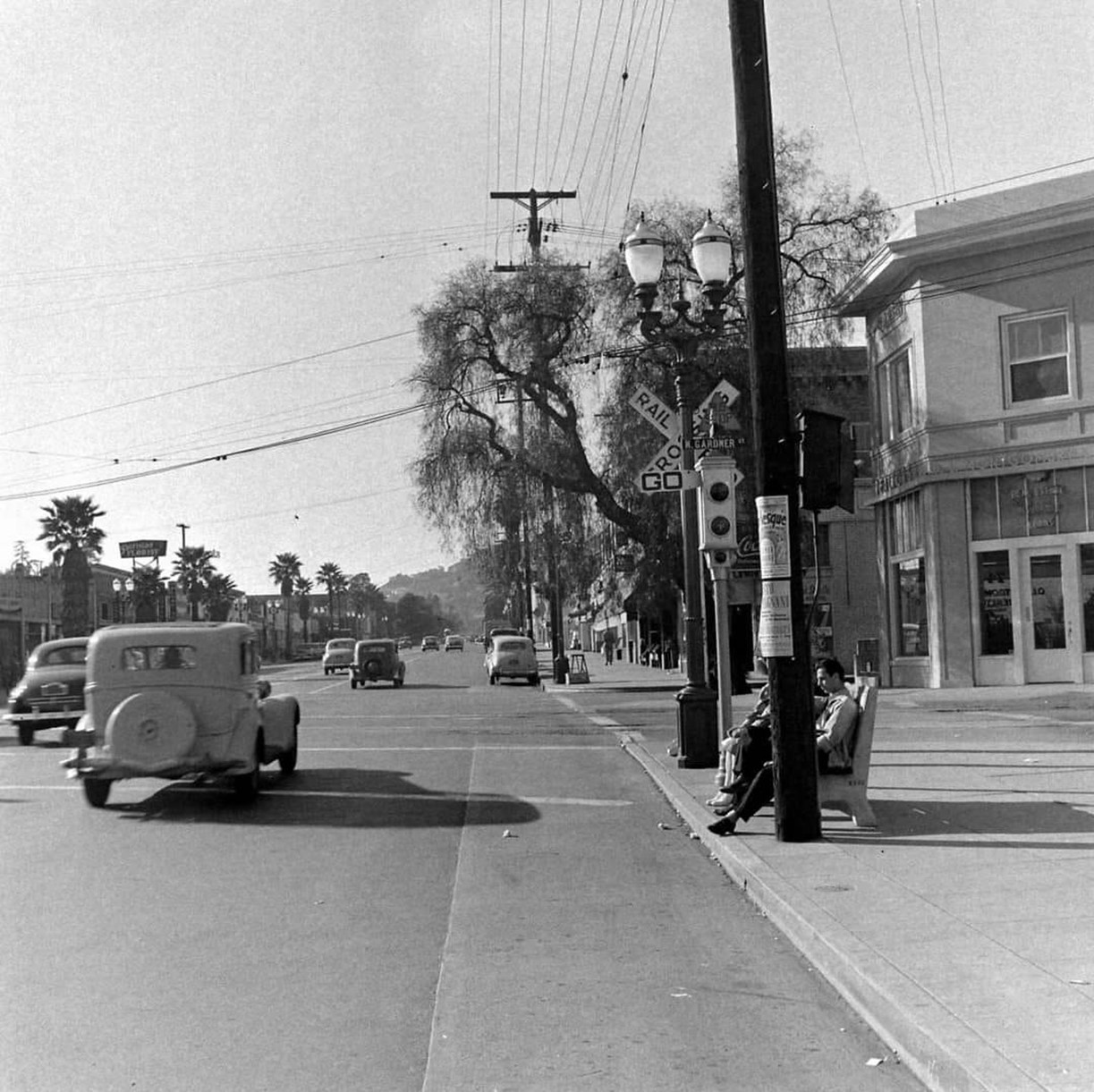 |
|
| (1948)* - Sunset Boulevard looking west at the Gardner Junction. Photo by J.R. Eyerman, LIFE Magazine |
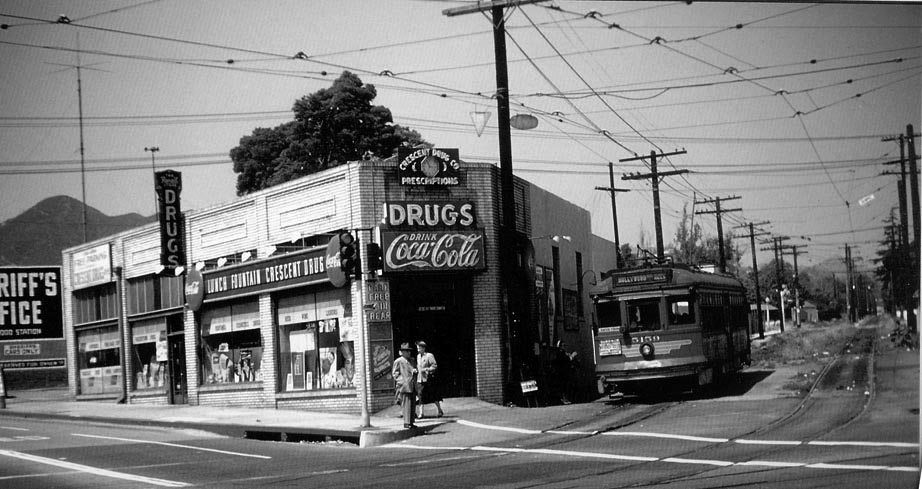 |
|
| (ca. 1953)^### – View looking northeast down a Pacific Electric right-of-way showing an outbound Hollywood Boulevard streetcar as it reaches Fairfax Avenue. At this point the Hollywood Boulevard line curves into Santa Monica Boulevard, joining the tracks of the Santa Monica Boulevard streetcar line, which come in from the right in this photo. |
Historical Notes PE obtained the Hollywood Boulevard Line in 1911 and operated it until it sold all its passenger business to Metropolitan Coach Lines on October 1, 1953. Metro continued the operation of this line until September 26, 1954, when the line was converted to motor coach operation. #*## |
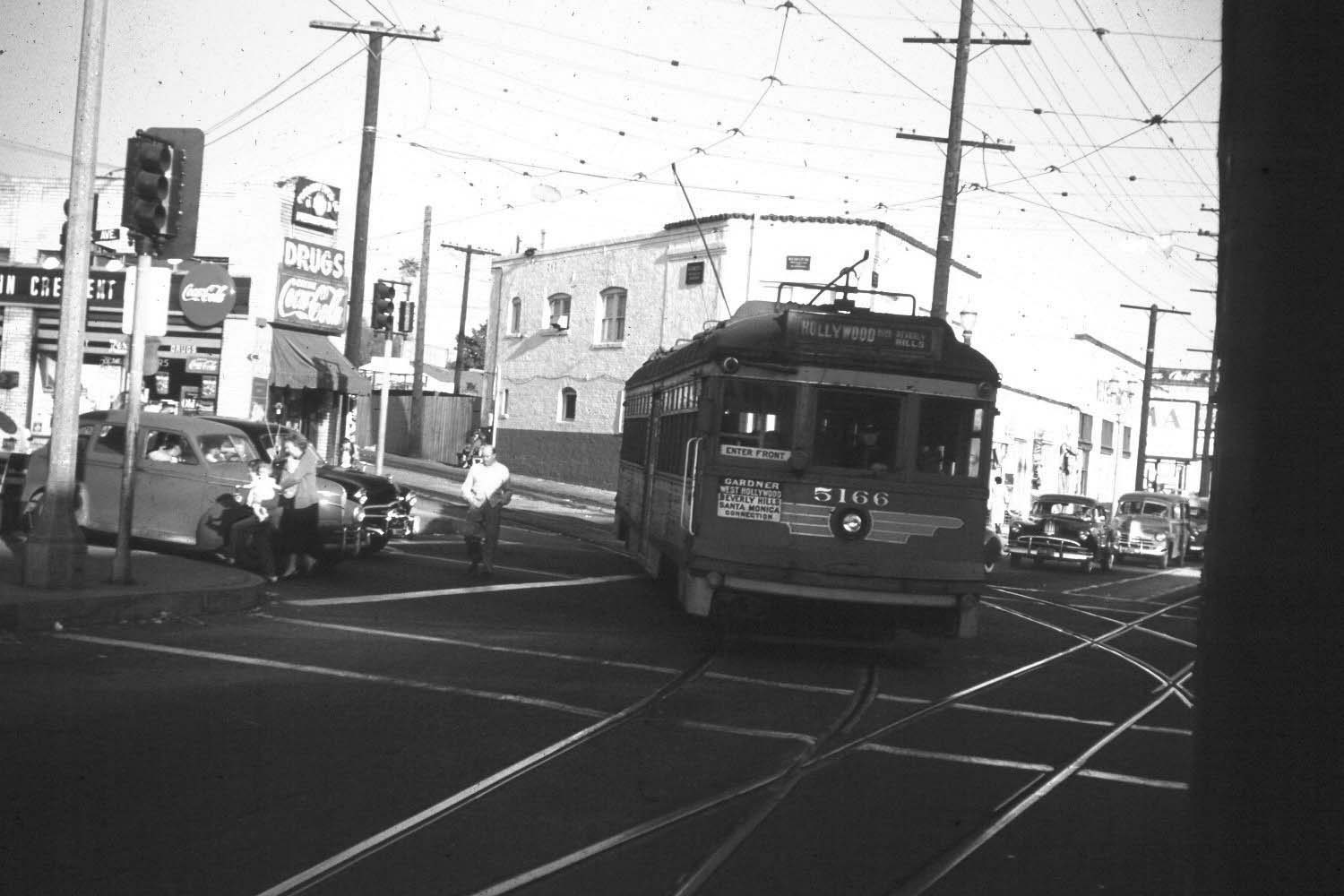 |
|
| (ca. 1952)*# – View showing a Pacific Electric streetcar making turn from right-of-way onto Santa Monica Boulevard heading west at Fairfax Avenue. |
* * * * * |
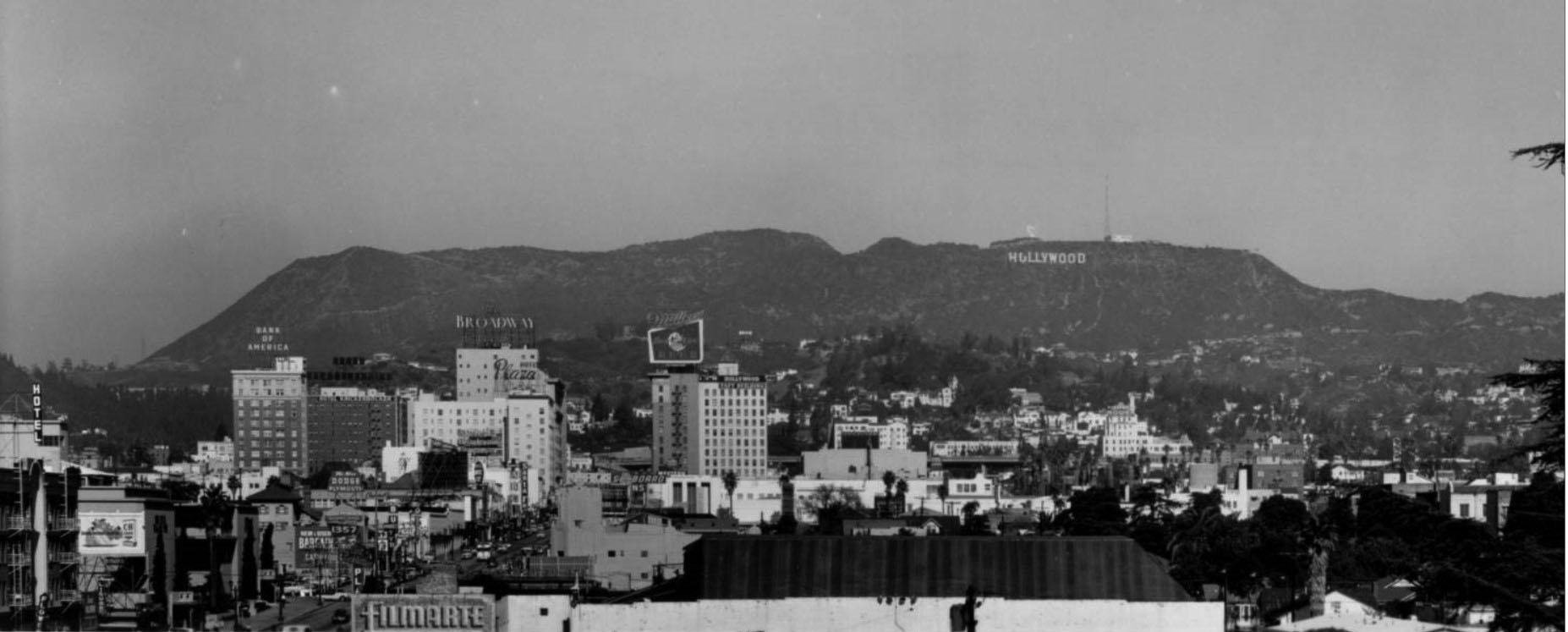 |
|
| (1950s)^^ – Panoramic roofline view looking north toward the Hollywood Hills as seen from Sunset Boulevard near Vine St. The intersection of Hollywood and Vine is at center left surrounded by a cluster of high-rise buildings. The ‘Hollywood Sign’ can be seen in the background. Photo by Dick Whittington |
Hollywood and Vine
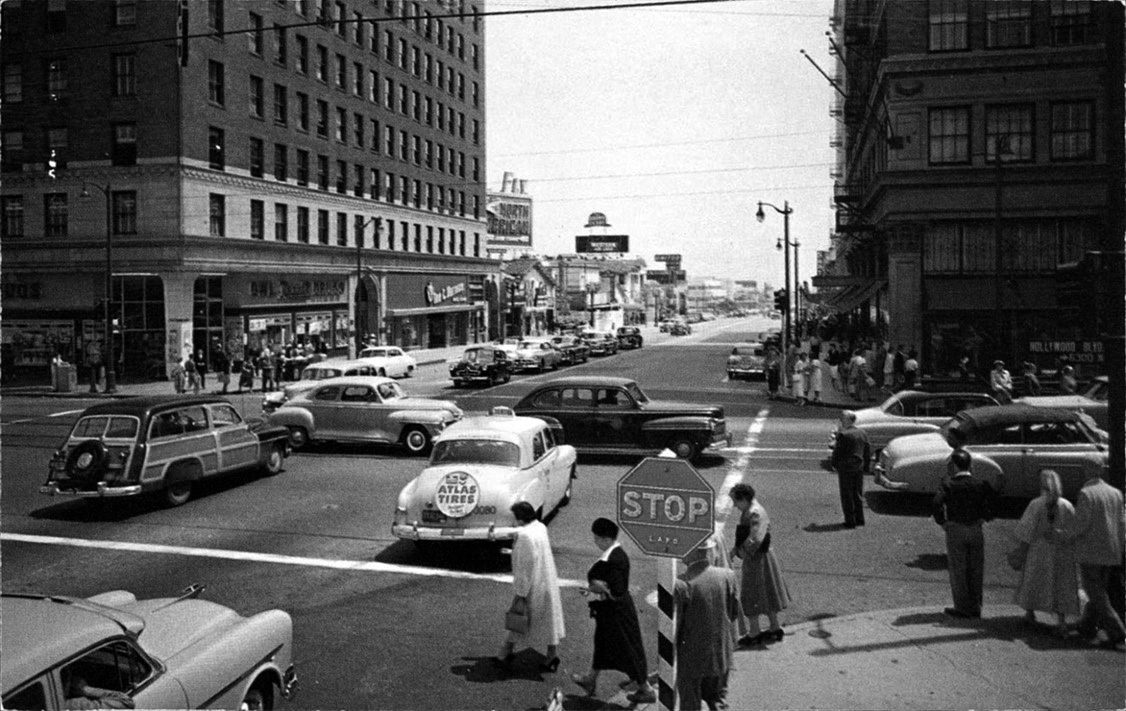 |
|
| (ca. 1952)* – Postcard view looking south showing a congested Hollywood and Vine intersection. Note the Stop Sign in the foreground (northwest corner). |
 |
|
| (ca. 1953)* – View looking west on Hollywood Boulevard at Vine Street showing passengers disembarking from a streetcar. Note the semaphore traffic signal above the stop sign. |
Historical Notes Pacific Electric Streetcars ran down the center of Hollywood Boulevard until 1954. Click HERE to see more. |
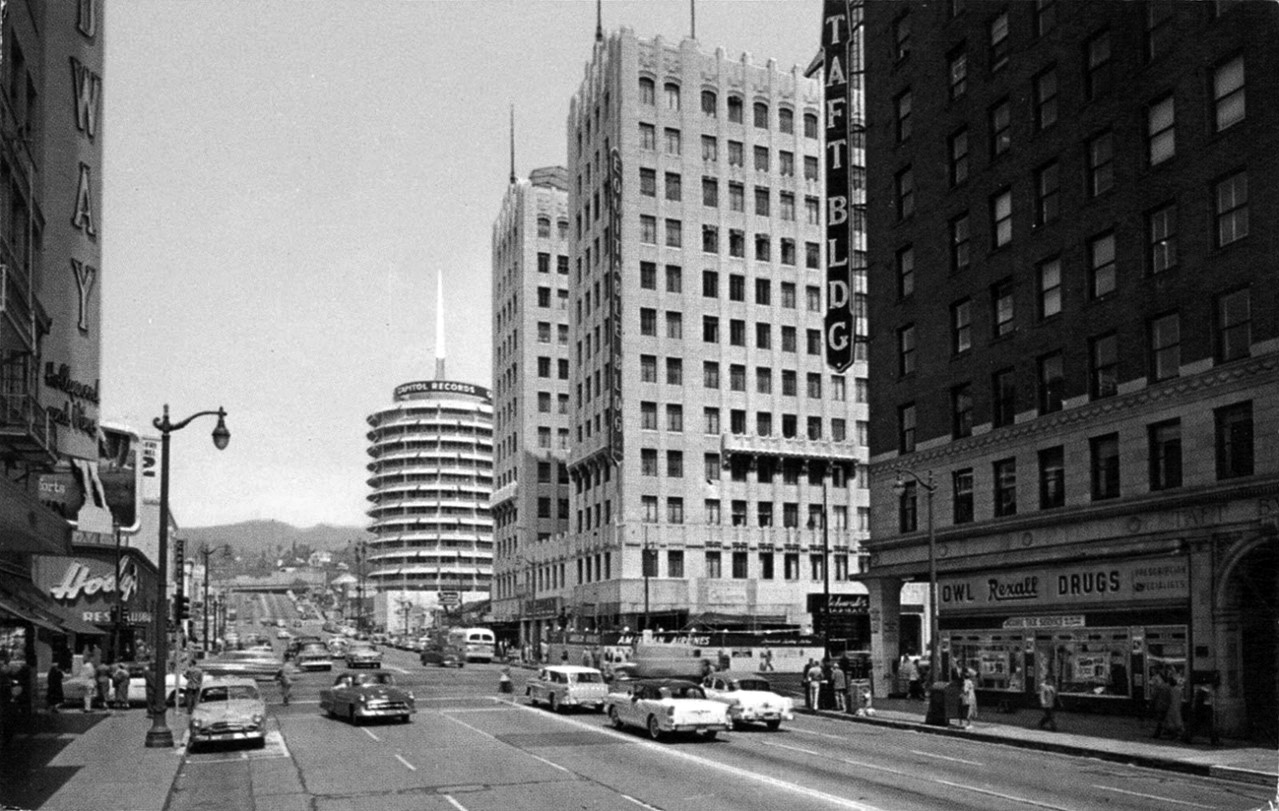 |
|
| (1956)* - View looking north toward the intersection of Hollywood and Vine. The four main buildings located on the corners of the intersection can be seen (L to R): The Broadway-Hollywood, Hody's Coffee Shop, Equitable Building, and the Taft Building. The iconic Capitol Records Building stands in the background. |
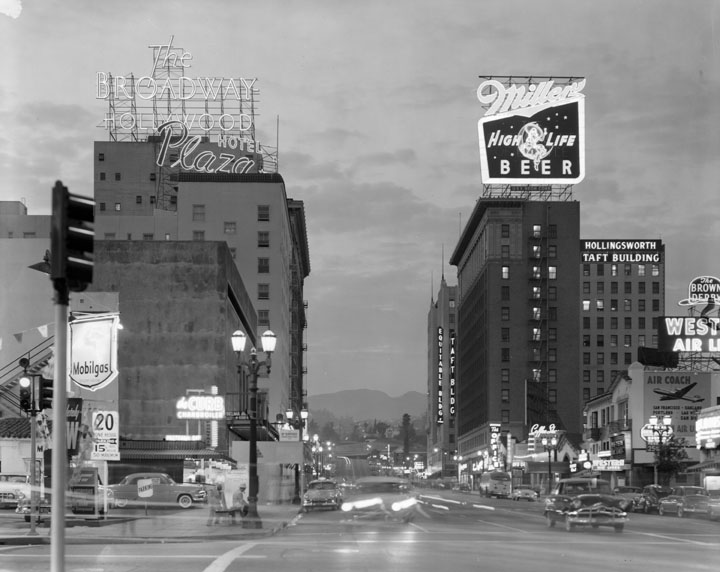 |
|
| (ca. 1950s)* - View at dusk, neon signs lit, looking northward on Vine Street from Selma Ave. On the left, The Broadway-Hollywood Building, Plaza Hotel, Mobilgas ; on the right, Equitable Building, Taft Building, The Brown Derby Coffee Shop |
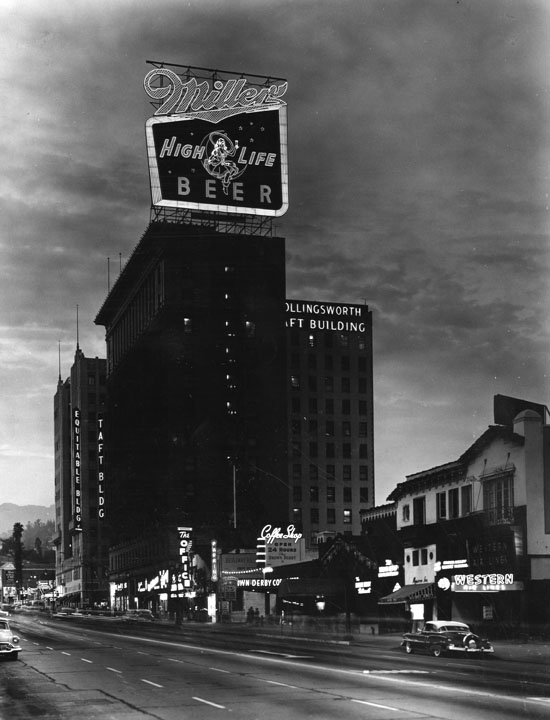 |
|
| (ca. 1950s)* - Vine Street looking northward from Selma Avenue. View of the Equitable Building, Taft Building, Brown Derby coffee shop, Western Air Lines. Atop the Taft building a very large neon sign for Miller high life beer. Architects of the Taft Building were Walker and Eisen. |
Historical Notes In 1999, the Taft Building and Neon Sign were designated Historic-Cultural Monument No. 666 (Click HERE to see complete listing). |
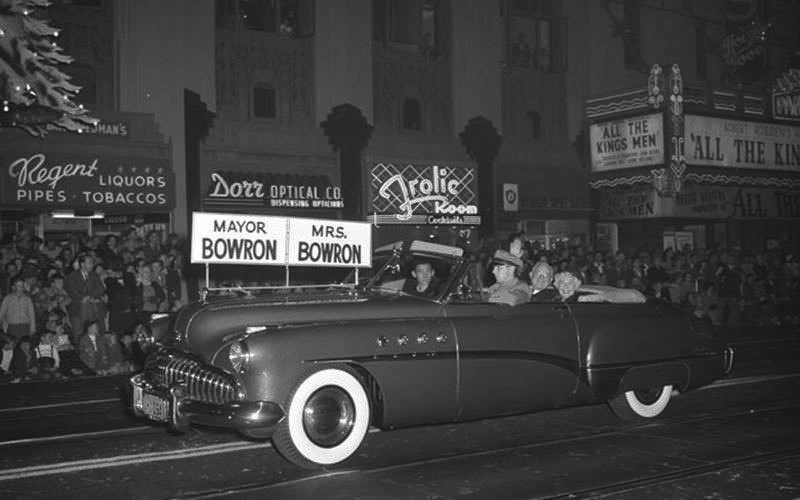 |
|
| (1948)* - Los Angeles Mayor Fletcher Bowron and his wife Irene smile at the crowds as they travel west past the Pantages Theatre in a 1949 Buick Roadmaster convertible during the Santa Claus Lane Parade, later the Hollywood Christmas Parade. The Frolic Room bar and other businesses are seen in the background on the 6200 block of Hollywood Boulevard. Click HERE to see contemporary view. |
Historical Notes Fletcher Bowron was the mayor of Los Angeles from 1938 to 1953. He was the longest-serving mayor to date in the city, and was the city's second longest serving mayor after Tom Bradley, presiding over the war boom and very heavy population growth, and building freeways to handle them.*^ |
Academy Awards - Pantages Theatre
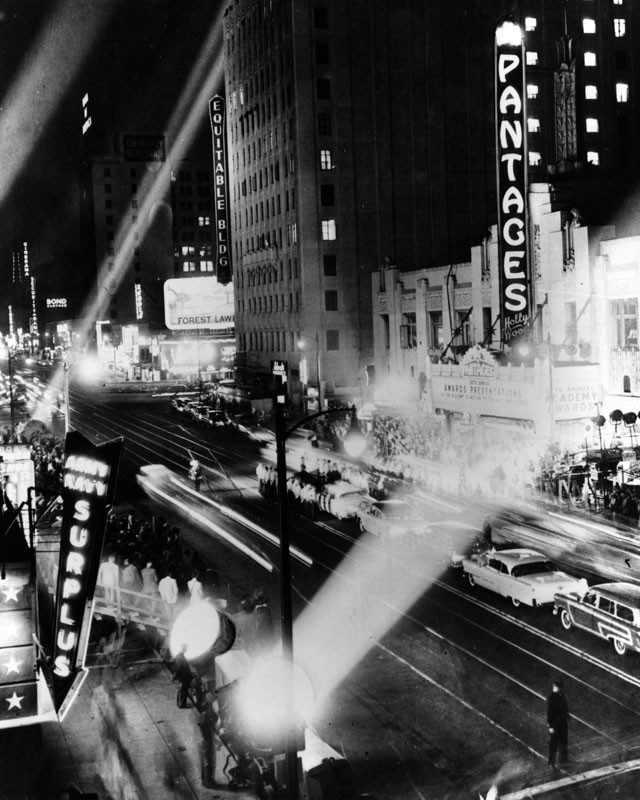 |
|
| (1950)* - Exterior view of the Pantages Theatre during the 20th Annual Academy Awards. Crowds of people are seated in bleachers directly outside the theater and on the south side of Hollywood Blvd. A line of cars is seen in the middle of the boulevard. Various signs identify neighboring buildings and businesses: Army Navy store, the Equitable Building, Bond Clothiers, Bank of America, Cinerama and the Guaranty Building. Street car tracks are visible on the street. |
Historical Notes From 1950 to 1960, the awards were presented at Hollywood's Pantages Theatre. The 22nd Academy Awards Ceremony awarded Oscars for the best in films in 1949. This was the last year for which all five Best Picture nominees were in black and white.*^ Best Picture: All the King's Men Best Actor: Broderick Crawford – All the King's Men Best Actress: Olivia de Havilland – The Heiress |
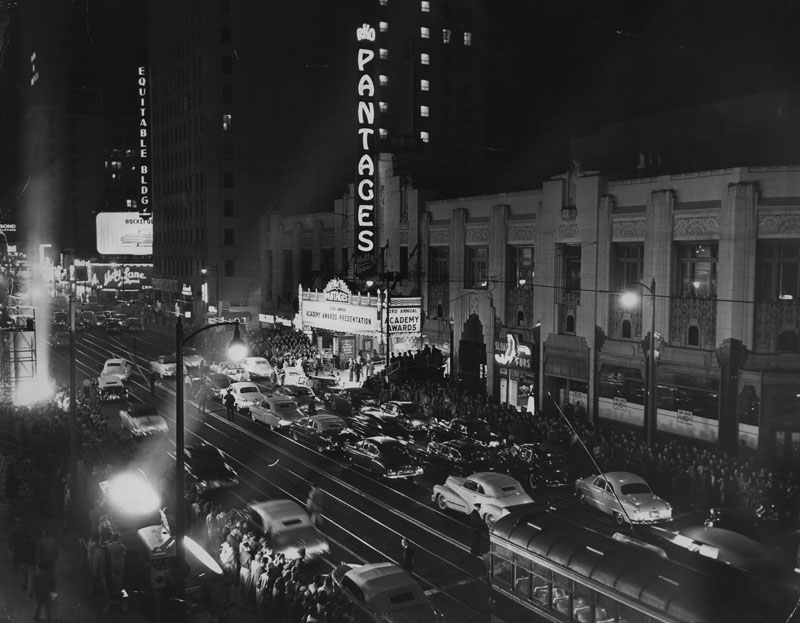 |
|
| (1951)* - The 23rd Annual Academy Awards at the Pantages Theatre in Hollywood. |
Historical Notes The 23rd Academy Awards Ceremony awarded Oscars for the best in films in 1950. The nominations were notable this year, as All About Eve was nominated for fourteen Oscars, beating the previous record of thirteen set by Gone with the Wind.*^ 23rd Annual Academy Awards (March 29, 1951): Best Picture: All About Eve Best Actor: José Ferrer – Cyrano de Bergerac Best Actress: Judy Holliday – Born Yesterday |
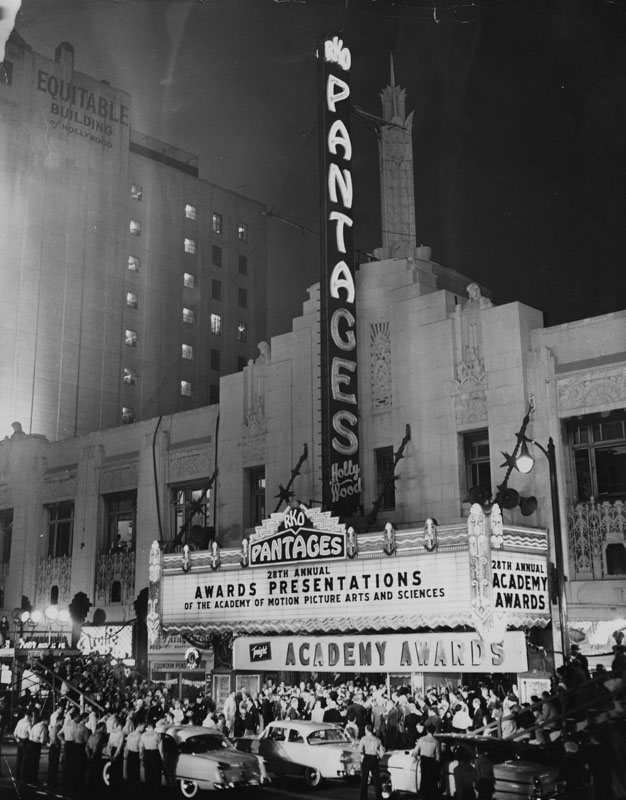 |
|
| (1956)* - View of the crowd gathered in front of the Pantages Theater in Hollywood to watch the stars come out for the Academy Awards. More than 10,000 gathered in front of the famed theater on March 21, 1956, to cheer their favorites. More than 90 regular and reserve policemen were needed to keep the crowd in order. |
Historical Notes The 28th Academy Awards, saw, Marty, a simple and low-budget film usually uncharacteristic of Best Picture awardees, became the shortest film (as well as the second Palme d'Or winner) to win the top honor.*^ 28rd Annual Academy Awards (March 21, 1956): Best Picture: Marty Best Actor: Ernest Borgnine – Marty Best Actress: Anna Magnani – The Rose Tattoo |
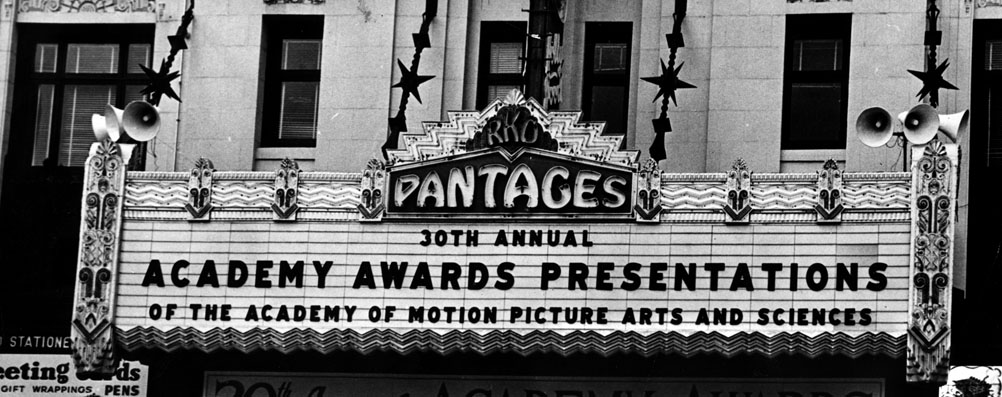 |
|
| (1958)* - 30th Annual Academy Awards at the Pantages Theatre. |
Historical Notes 1957's best films were honored at the 30th Academy Awards. The Oscar for Writing Based on Material From Another Medium was awarded to Pierre Boulle for The Bridge on the River Kwai, despite the fact that he did not know English. The actual writers, Carl Foreman and Michael Wilson were blacklisted at the time and did not receive screen credit for their work. Foreman and Wilson have since been acknowledged by the Academy for their contributions. Joanne Woodward's win for Best Actress for her triple role as Eve White, Eve Black and Jane in The Three Faces of Eve marked the film as the last film to win Best Actress without being nominated for other awards. This was broken 31 years later when Jodie Foster won Best Actress for her role in The Accused, the film's only nomination. Peyton Place tied the record for the most nominations without a single win (9) with The Little Foxes. It would not be broken until 1977 when The Turning Point received 11 nominations without a win, which has not been broken since, though The Color Purple subsequently tied the record. Peyton Place also set the record for most unsuccessful acting nominations with five; this record has been tied once, by Tom Jones at the 36th Academy Awards.*^ |
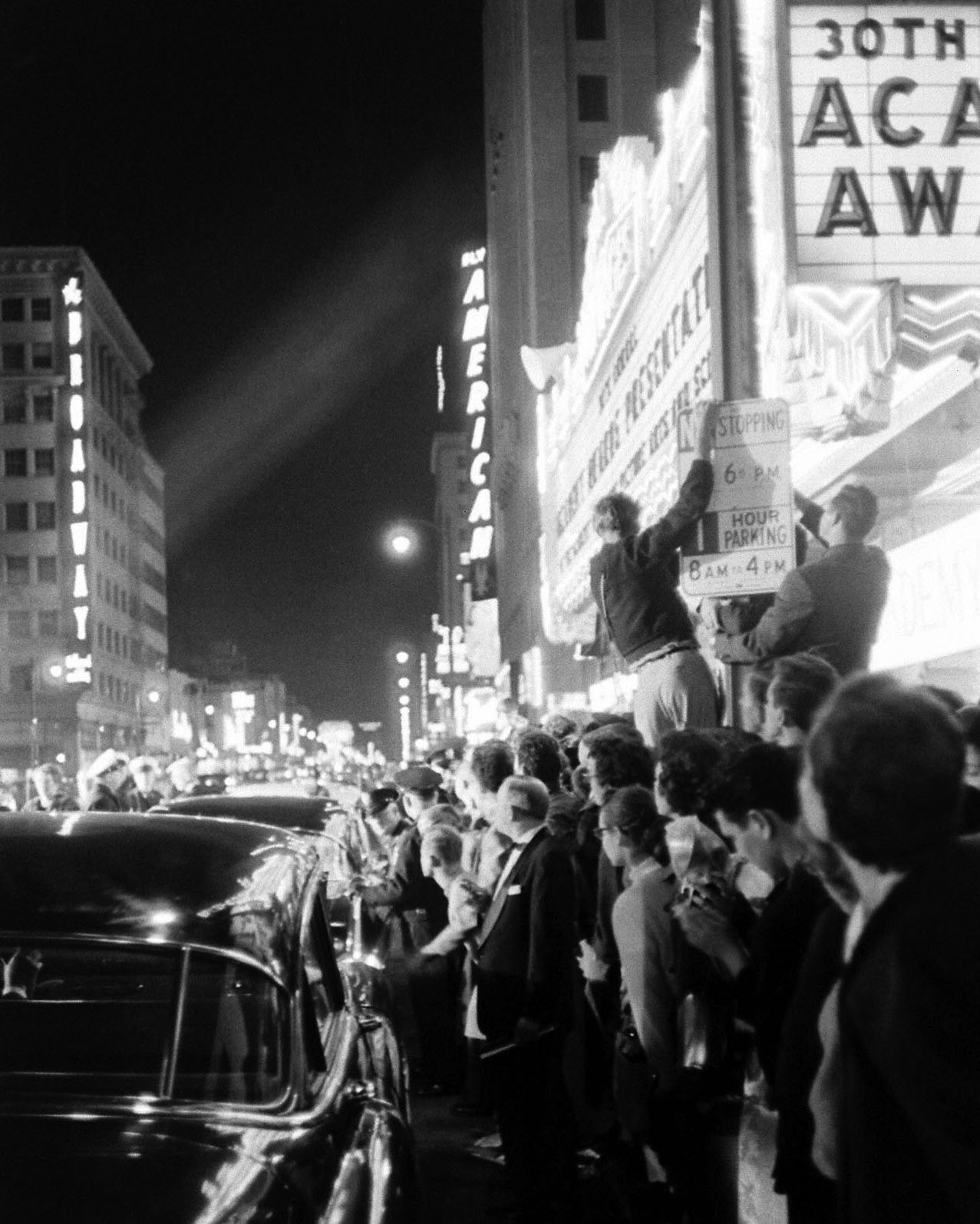 |
|
| (1958)* - Crowds gather outside of the Pantages, watching for their favorite celebrities as they arrive for the 30th Academy Awards ceremony on March 26, 1958. Photo by Ralph Crane / Life Magazine |
Historical Notes The 30th Academy Awards. It was the first time the ceremonies were broadcast live. 30th Academy Awards (March 26, 1958): Best Picture: The Bridge on the River Kwai Best Actor: Alec Guinness – The Bridge on the River Kwai Best Actress: Joanne Woodward – The Three Faces of Eve |
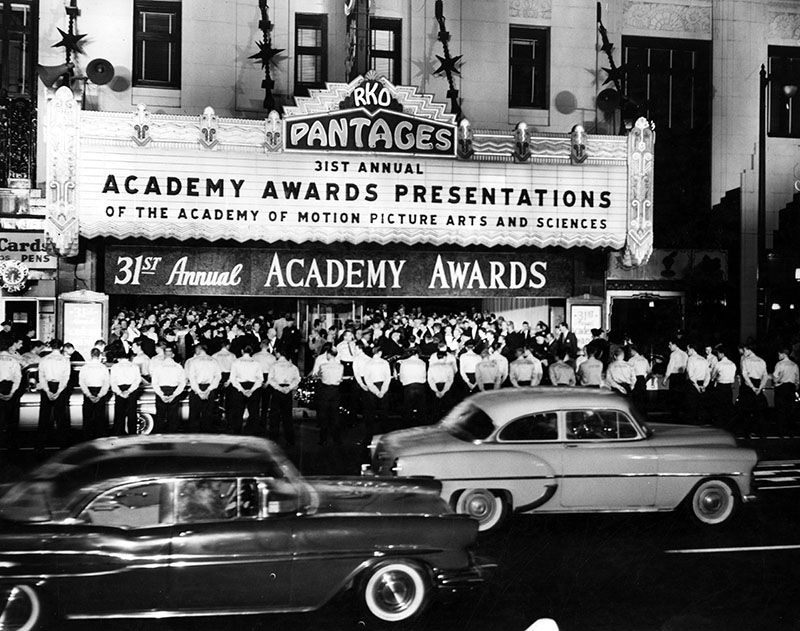 |
|
| (1959)* - Photograph caption dated April 7, 1959 reads, "Theater lobby packed - Here at the last moment, crowds of ticket holders make a rush for the Hollywood Pantages door in anticipation of the two-hour telecast of the Academy of Motion Picture Arts and Sciences' 31st annual awards presentation. More than 100 famed stars were on hand to regale the packed audience.". |
Historical Notes The 31st Academy Awards ceremony was held on April 6, 1959, to honor the best films of 1958. The show's producer, Jerry Wald, started cutting numbers from the show to make sure it ran on time. Unfortunately, he cut too much material and the ceremony ended 20 minutes early, leaving Jerry Lewis to attempt to fill in the time. Eventually, NBC cut to a re-run of a sports show. The film Gigi won nine Oscars, breaking the previous record of eight (set by Gone with the Wind and tied by From Here to Eternity and On the Waterfront). It would be shortlived, however, as Ben-Hur broke the record with eleven Oscars the following year.*^ 31st Annual Academy Awards (April 6, 1959): Best Picture:Gigi Best Actor: David Niven – Separate Tables Best Actress: Susan Hayward – I Want to Live! |
Click HERE to see more in Early Views of the Pantages Theater |
* * * * * |
Hollywood Savings and Loan
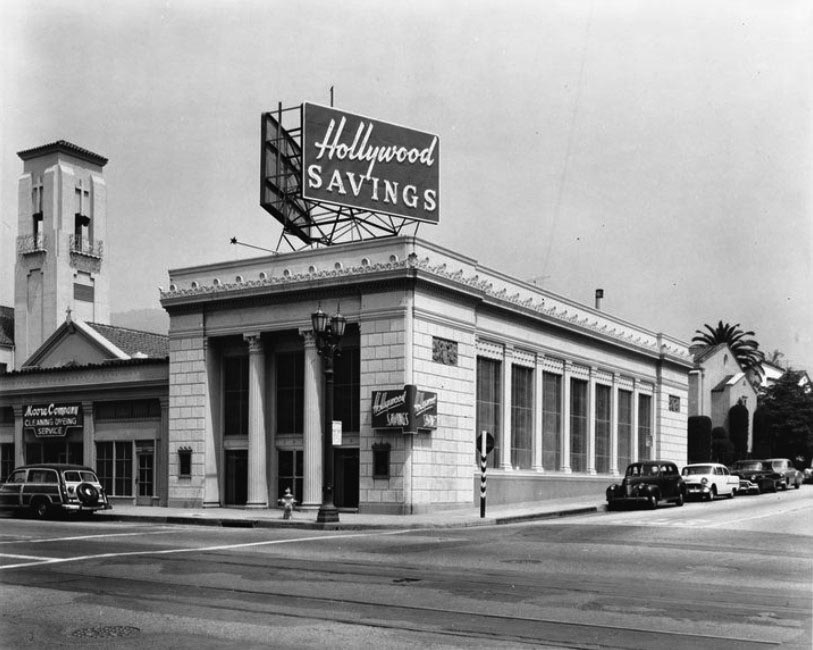 |
|
| (ca. 1956)^^ – View showing Hollywood Savings & Loan on the northwest corner of Hollywood Boulevard and Wilton Place (5701 Hollywood Blvd). Moore Company Cleaning & Dyeing Service is to the left. |
Historical Notes The Beaux Art building was designed by Morgan, Walls, and Clements. It was built in 1930 to house a branch of Security Pacific Bank, one of the first Los Angeles banks to open branches in the Hollywood suburbs. The sign on the building today reads Escrow Center. Click HERE for contemporary view. |
Hollywood Masonic Temple
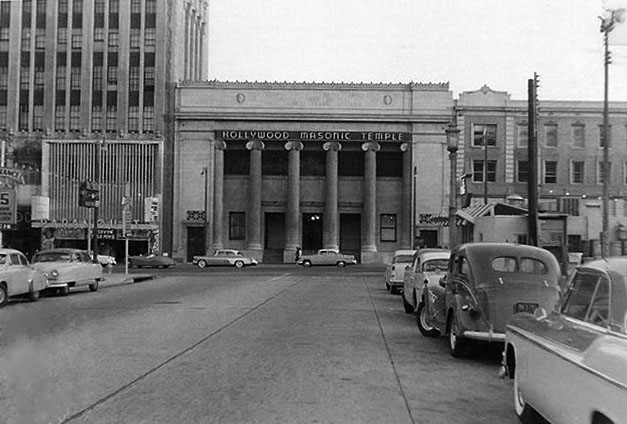 |
|
| (1955)*^^* – View looking south on Orchid Avenue toward Hollywood Boulevard. The Hollywood Masonic Temple is seen on the other side of Hollywood Boulevard at the T-intersection with the Paramount Theatre on the left. Toff's Coffee Shop can be seen on the northwest corner. |
Historical Notes In 1921, the Hollywood lodge of the Masons relocated from their existing lodge on the current site of the Kodak Theatre. The construction of the new three-story building was led by lodge master, Charles E. Toberman, who was responsible for the Hollywood Bowl, Grauman's Chinese Theatre, the Roosevelt Hotel and the Max Factor Building. When the new temple opened, it was one of the most substantial structures in Hollywood. It had a billiard room, pipe organ, ladies parlor, ballroom and lodge rooms. One writer described the building as "unsurpassed for beauty, attractiveness and richness of equipment. The architect, John C. Austin also worked on the Shrine Auditorium, Griffith Observatory and Los Angeles City Hall.*^ In 1984, the Hollywood Masonic Temple was dedicated LA HIstoric-Cultural Monument No. 277 (Click HERE to see complete listing). The building, now known as the El Capitan Entertainment Centre, was also listed in the National Register of Historic Places in 1985. |
 |
|
| (ca. 1976)##^* – Aerial view looking south showing the intersection of Hollywood Boulevard and Orchid Avenue (center-right). Both the Paramount Theatre and Masonic Temple can be seen on the south side of the Boulevard with Toff's Coffee Shop on the NW corner (lower-right). The Hollywood High School athletic field is seen at top of photo. |
Historical Notes The Hollywood Highland complex would be built in the 1990s where the parking lots and Orchid Ave are seen in the above photo (bottom of photo). |
Toff's Coffee Shop
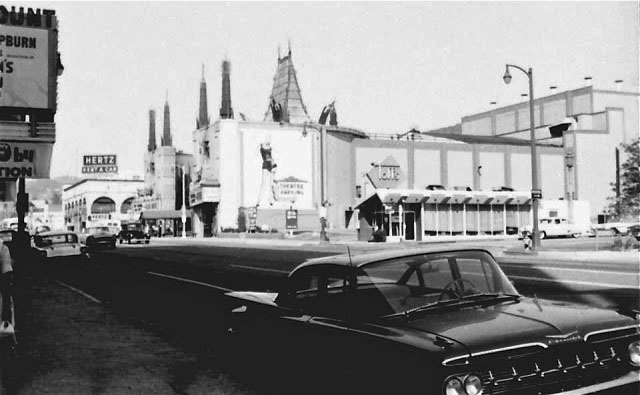 |
|
| (1959)^v^ – View looking northwest toward Grauman’s Chinese Theatre. Toff’s Coffee Shop, located on the northwest corner of Orchid Avenue and Hollywood Boulevard, is seen at center-right. A 1959 Chevrolet Impala is parked in front of the El Capitan/Paramount Theatre in the foreground. |
 |
|
| (ca. 1970)##^* – View of Toff’s Coffee Shop on the northwest corner of Hollywood Boulevard and Orchid Avenue, just east of the Chinese Theatre. |
Historical Notes Orchid Avenue at Hollywood Boulevard "disappeared" during the construction of the Hollywood Highland complex in the late 90s. The other half of the street still exists and can be accessed off of Franklin Ave, the next street north of Hollywood Blvd. |
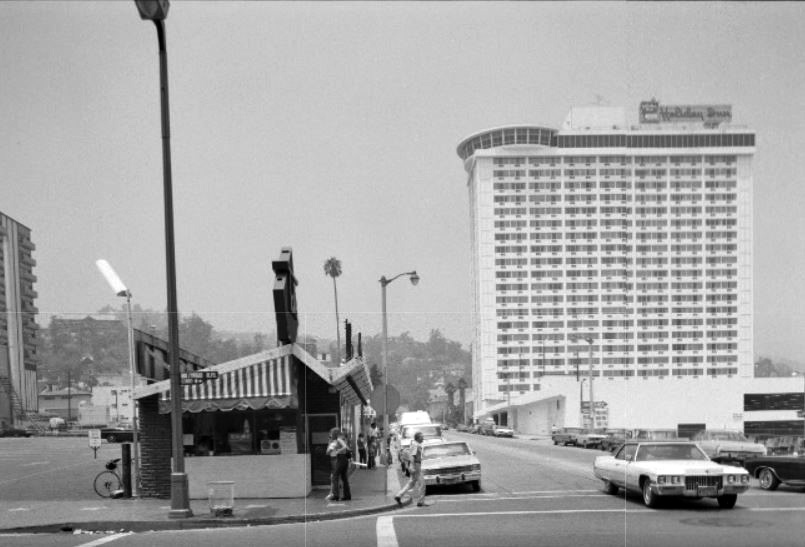 |
|
| (1970s)^.^ – View looking north on Orchid Avenue at Hollywood Boulevard showing Toff’s Coffee Shop on the NW corner. In the distance can be seen the 22-story Holiday Inn (today Loews Hollywood Hotel) |
Historical Notes Built in 1972 as the Holiday Inn, converted in 2001 to the Renaissance Hollywood following a $130 million renovation as part of the Hollywood & Highland complex. Converted to Loews in June 2012.* |
* * * * * |
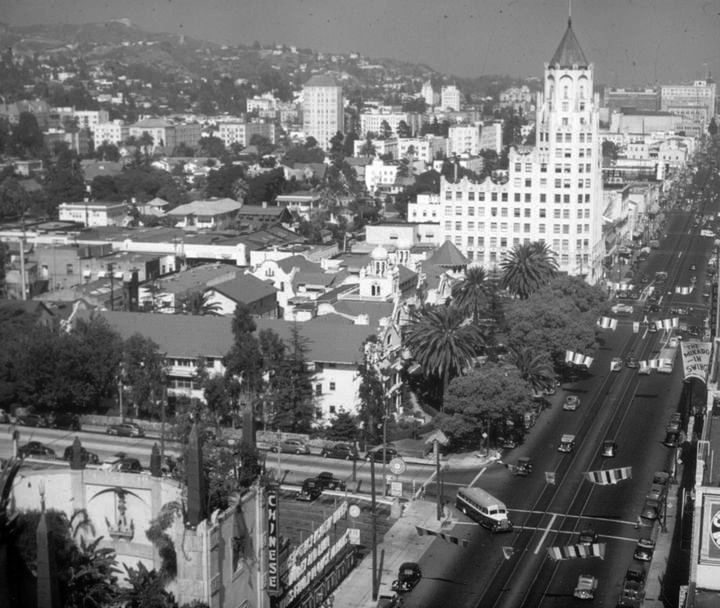 |
|
| (1939)*# - View showing a bus making a right turn onto Hollywood Boulevard from Orchid Avenue. The Hollywood Hotel is seen on the north side of Hollywood Blvd. between Orchid and Highland. |
Historical Notes Today, both this section of Orchid Avenue and the Hollywood Hotel are gone. In their place stands the Hollywood and Highland Entertainment Complex. |
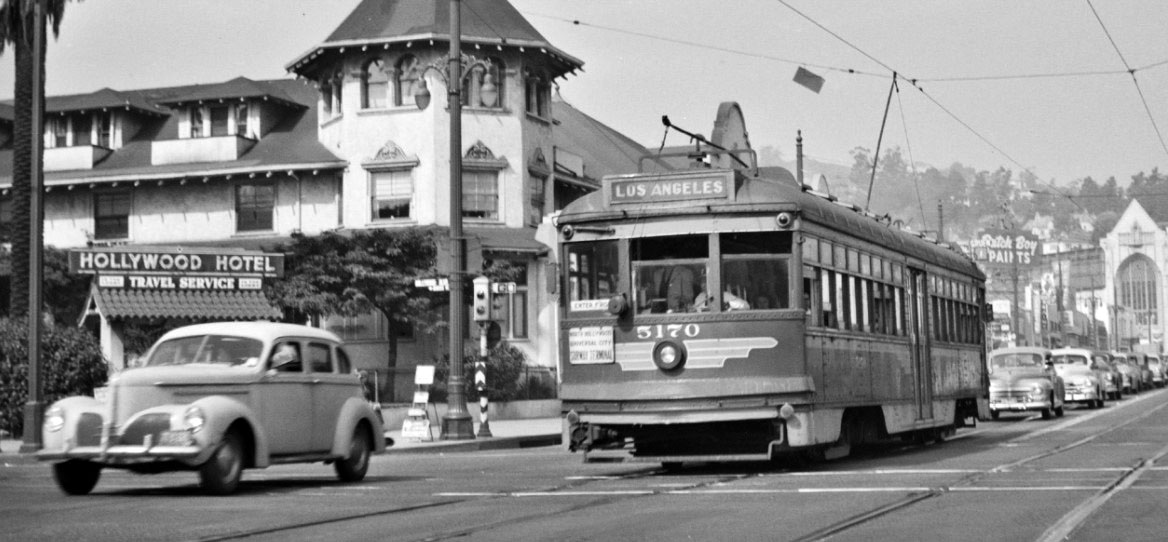 |
|
| (1940s)##** – View looking north on Highland Avenue at Hollywood Boulevard showing P.E. No. 5170 heading south. The Hollywood Hotel is seen on the northwest corner. Further down Highland at Franklin (on the right) stands the Hollywood United Methodist Church. |
 |
|
| (1940s)##^* – Passengers boarding the PE San Fernando Valley bound line at Highland and Hollywood with the Hollywood Hotel seen in the background. |
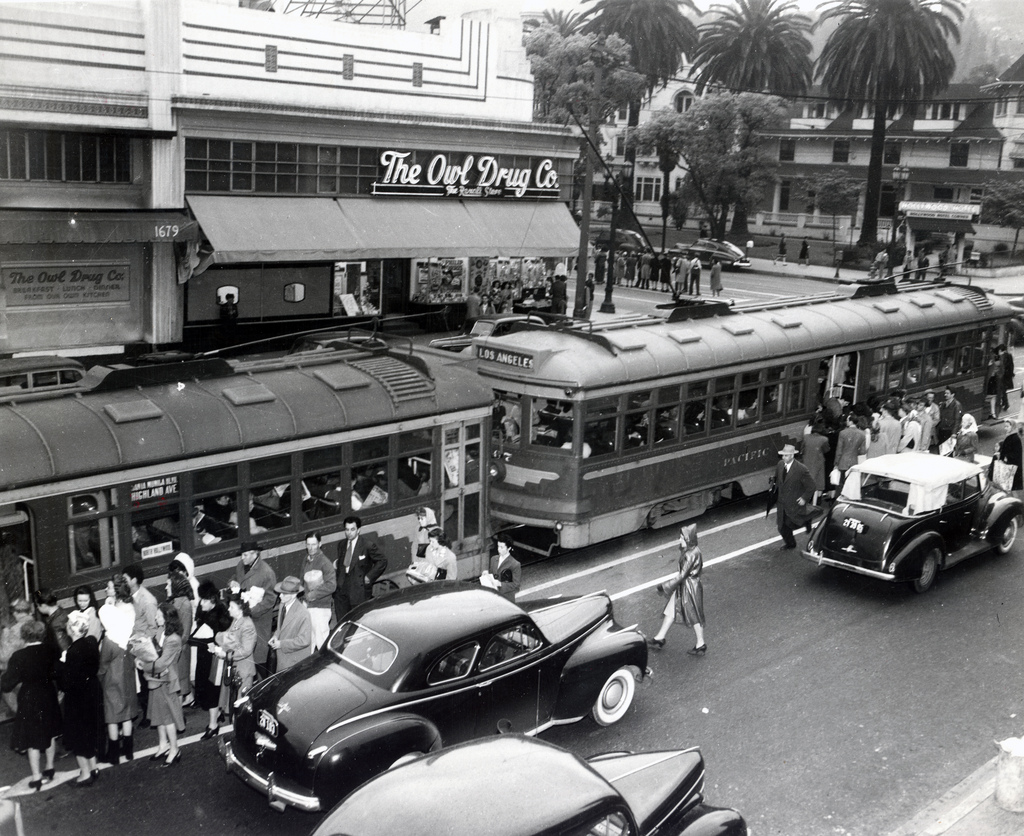 |
|
| (ca. 1945)*^* - View of the P.E. No. 707 (San Fernando Valley Line), north bound on Highland Avenue at Hollywood Boulevard. People are lined up as they get ready to board both electric cars. The Owl Drug Store is seen on the southwest corner. The Hollywood Hotel is directly across the street, northwest corner of Hollwood and Highland. |
.jpg) |
|
| (ca. 1950)*# – View looking north on Highland Avenue toward Hollywood Boulevard. The image is dominated by the Hollywood First National Bank Building on the N/E corner with the Hollywood United Methodist Church further back at Franklin. On the right is the Max Factor Building and, further north on the S/E corner, Bank of America. |
.jpg) |
|
| (1953)*^* - View looking east on Hollywood Boulevard toward Ivar Avenue. The Broadway-Hollywood Building can be seen on the right in the distance on the southwest corner of Hollywood and Vine. The Guaranty stands at left on the northeast corner of Hollywood and Ivar. Part of Schwabs can be seen in the far right. |
 |
|
| (ca. 1950s)* - Looking west on Hollywood Boulevard from Western Avenue. Cars dating from the early 1950's and earlier are seen sharing the road with a streetcar. |
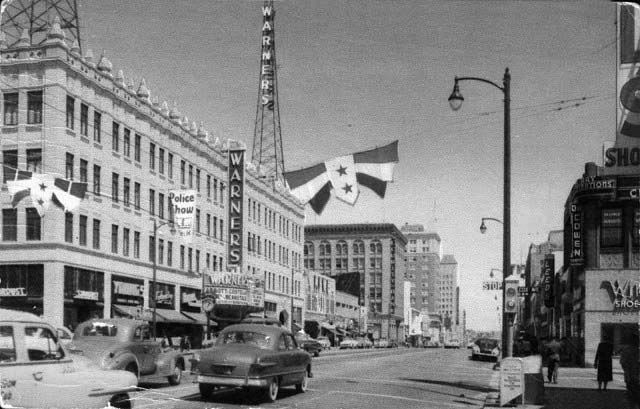 |
|
| (1950s)*^#^* - Postcard view looking east on Hollywood Boulevard at Wilcox Avenue. Warner Bros. Theatre is seen on the northeast corner. |
Historical Notes Warner Bros. Hollywood Theatre has also been known as Warner's, the Warner, Warner Cinerama, Warner Hollywood Cinerama, the Hollywood Pacific and the Hollywood Pacific 1-2-3. #*^# |
 |
|
| (1953)^^ – View looking west down the center of Hollywood Boulevard. The Warner Bros. Theatre on the northeast corner of Hollywood and Wilcox is on the right. Three large signs are seen on the left: Karl’s Shoes, Iris Theatre, and Coca Cola. The First National Bank Building tower can be seen in the distance. |
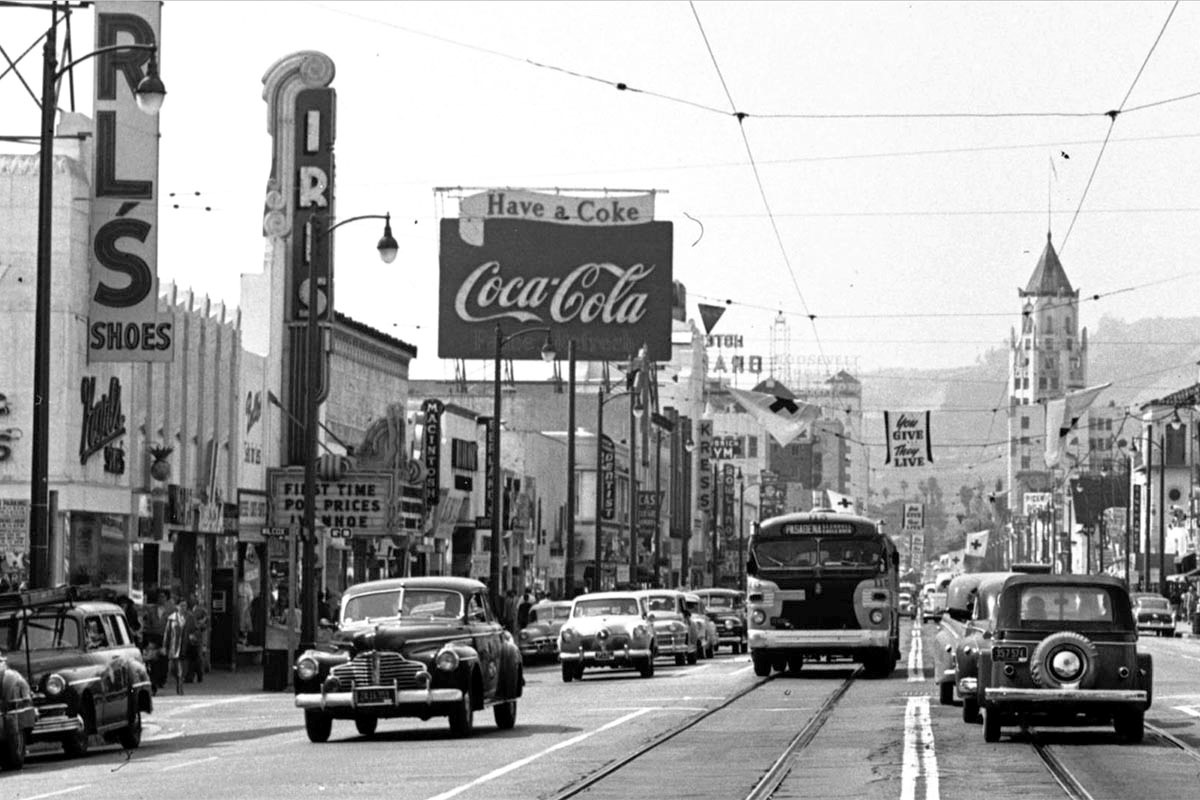 |
|
| (1953)^^ – View looking west on Hollywood Boulevard (detail view of previous photo). |
 |
|
| (ca. 1955)* - View of Hollywood Boulevard looking west from the corner of Las Palmas Avenue. Various businesses, restaurants, bookstores, theaters, and banks are found on the north and south sides on the boulevard, where traffic is flowing in both directions. On the left, a sign identifies the stage production of Oklahoma! taking place at the Egyptian Theatre. First National Bank of Hollywood, located at 6381 Hollywood Boulevard, is visible in the center of the image and the Chinese Theatre is present in the background. |
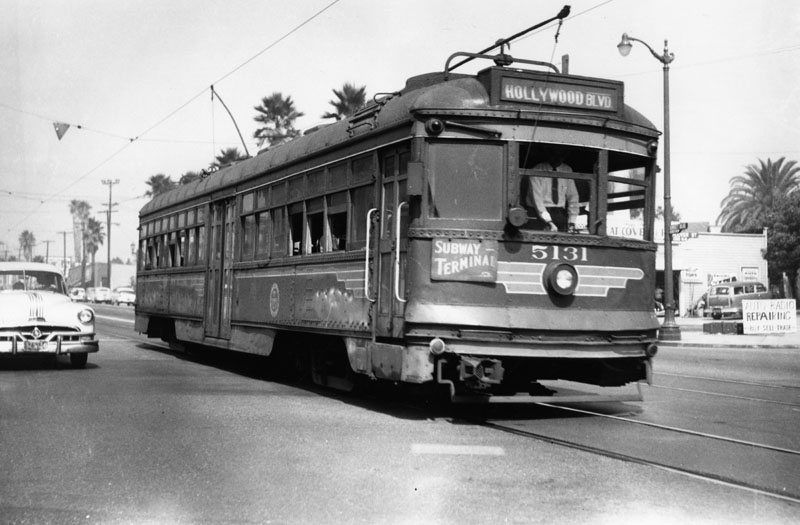 |
|
| (ca. 1954)* - A Hollywood Boulevard Pacific Electric Railway car that goes to Subway Terminal Building. The street sign says "Sunset Boulevard." |
Historical Notes On October 1, 1953, Pacific Electric sold all its passenger business to Metropolitan Coach Lines. Metro continued the operation of this line until September 26, 1954, when the line was converted to motor coach operation. #*## |
 |
|
| (1951)*# – View looking west on Hollywood Blvd at Highland with the Roosevelt Hotel in the distance on the left and the Hollywood Hotel to the right. The Dean Martin/Jerry Lewis film "At War with the Army" is playing at the Paramount Theatre on the left. The Chinese Theatre spires can be seen over the P.E. Red Car. |
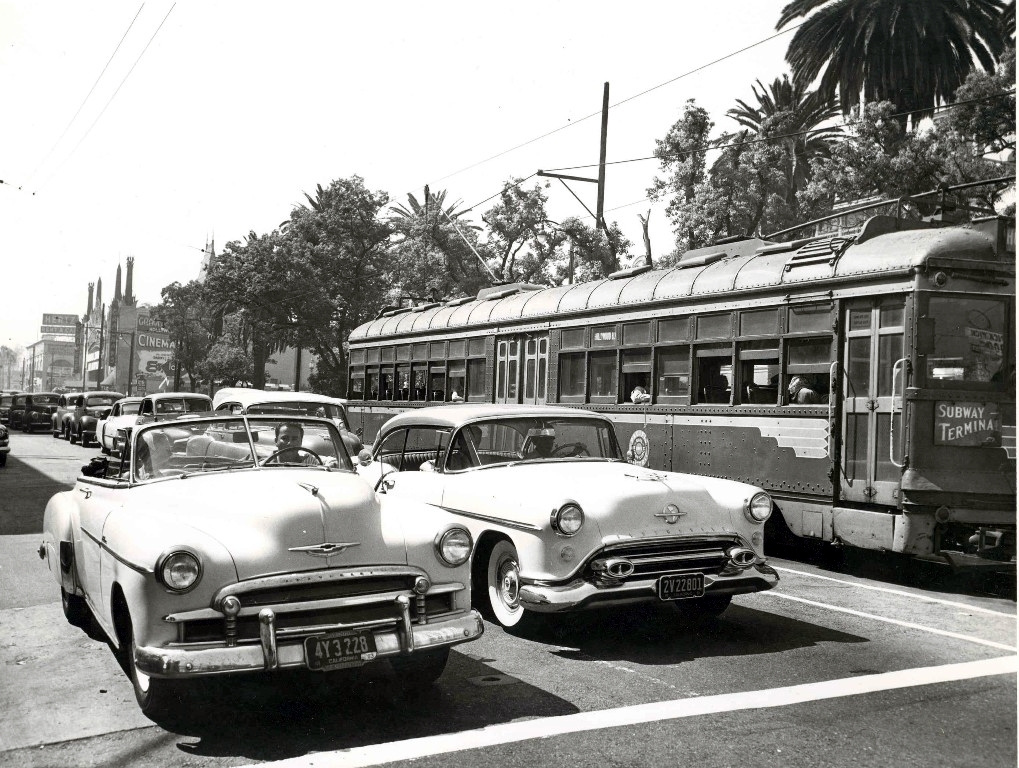 |
|
| (ca. 1954)*^* - Cruising Hollywood Boulevard heading east at Highland Ave. Grauman's Chinese Theatre can be seen in the background. The Hollywood Hotel is on the right behind the P.E. Red Car. |
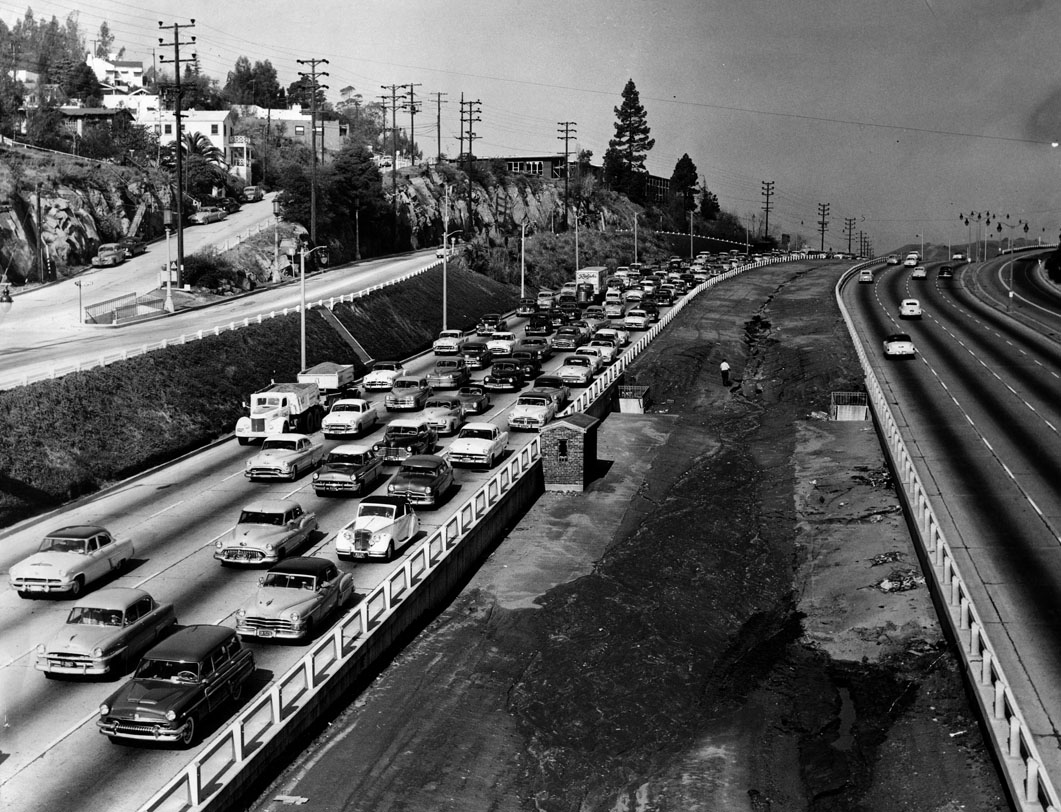 |
|
| (1955)* - Hollywood Freeway through Cahuenga Pass. View looking north from Mulholland Drive bridge shows traffic, backed up because of a car accident on the freeway. A sign of more things to come as the City continues to grow. Click HERE to see more Early Views of Cahuenga Pass. |
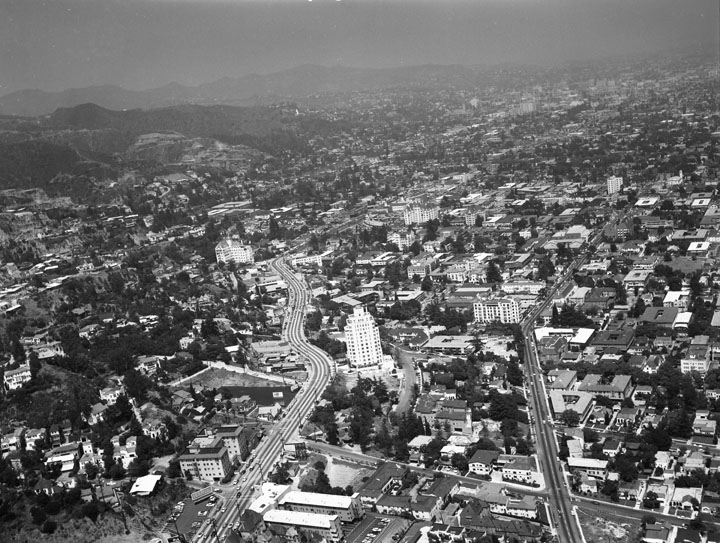 |
|
| (1956)* - Looking northeast over the Sunset Strip in what is now West Hollywood. Off of Sunset Boulevard (left of center running from the foreground to the middle), are several landmarks, including the Argyle Hotel, aka Sunset Tower (center), Ciro's, and the Chateau Marmont (left of center). Fountain Avenue, which runs parallel with Sunset Boulevard, is seen in the foreground, veering to the right as it continues on into the background. |
Historical Notes Designed by Leland A. Bryant, an architect known for luxurious structures, the Sunset Tower (Argyle Hotel) has been a popular destination since it opened. Over the years, it has served as the residence for many celebrities, including Frank Sinatra, Howard Hughes, Elizabeth Taylor, Zasu Pitts, Bugsy Siegel, Errol Flynn and Marilyn Monroe. The hotel has also appeared in a number of films and books.* |
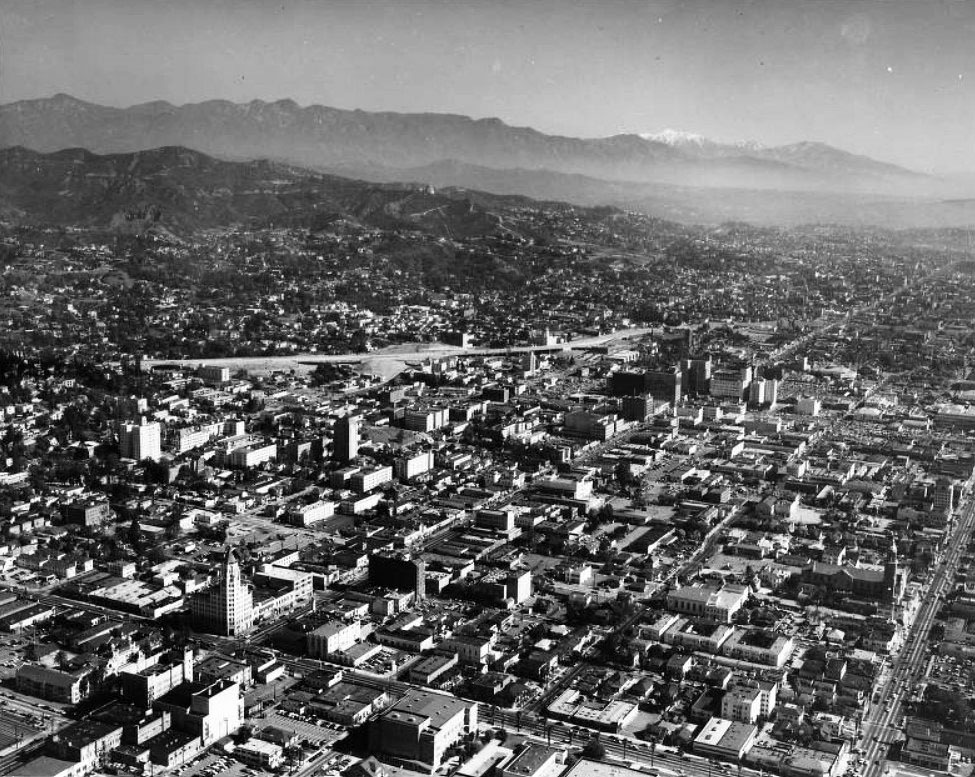 |
|
| (1954)^^ - Aerial view of Hollywood facing northeast with snow-capped San Gabriel Mountains in the far distance. Hollywood Boulevard runs diagonally from lower-left corner to upper-right. The Art Deco/Gothic style First National Bank Building is seen in the lower left on the northeast corner of Hollywood and Highland. The Hollywood Freeway is in the center-left. |
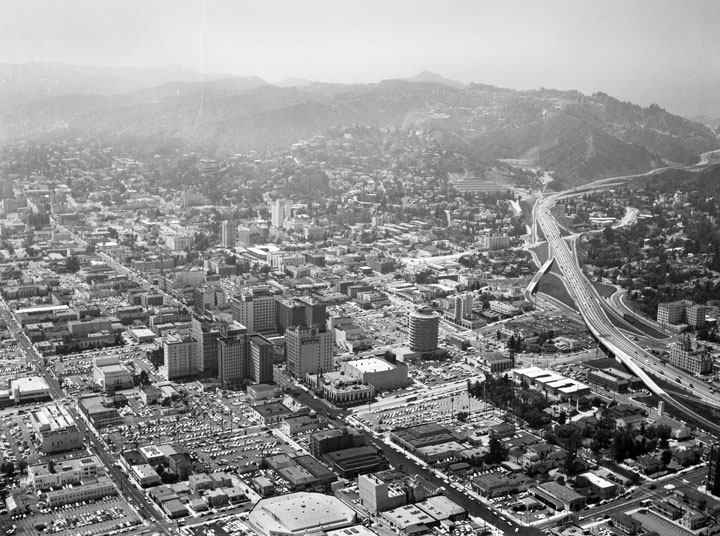 |
|
| (1956)* - Aerial view looking northwest showing the Hollywood business district, with the Capitol Records Building visible middle right. Other visible buildings include: Pantages Theatre, E.F. Hutton Building, Broadway-Hollywood, Hotel Knickerbocker, Guaranty Building, and the Taft Building. The streets are (diagonally, l to r): Selma Avenue, Hollywood Boulevard, and Yucca Street; and (bottom to top) Gower Street, Argyle Avenue, Vine Street, Ivar Avenue, and Cahuenga Boulevard, to name a few. The Hollywood (101) Freeway is visible along the right. |
Before the Hollywood Freeway
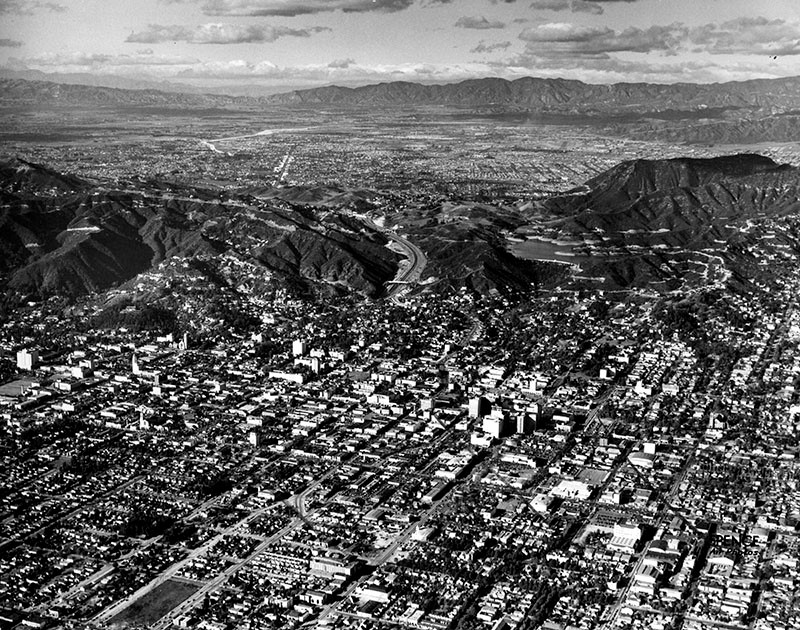 |
|
| (ca. 1950)* - Aerial view of Hollywood, north of Sunset between Highland and Gower before the second section of the Hollywood Freeway was built (1954). The Hollywood Reservoir (middle right) is in the hills above Hollywood. There is a clear view of San Fernando Valley in the background. |
Construction of the Hollywood Freeway through Hollywood
 |
|
| (1952)* - Looking NW over Hollywood Fwy (US-101) construction as it made its way to Cahuenga Pass. Sunset Blvd and Wilton Place intersect in foreground with Hollywood Blvd parallel to Sunset Blvd across center of photo. |
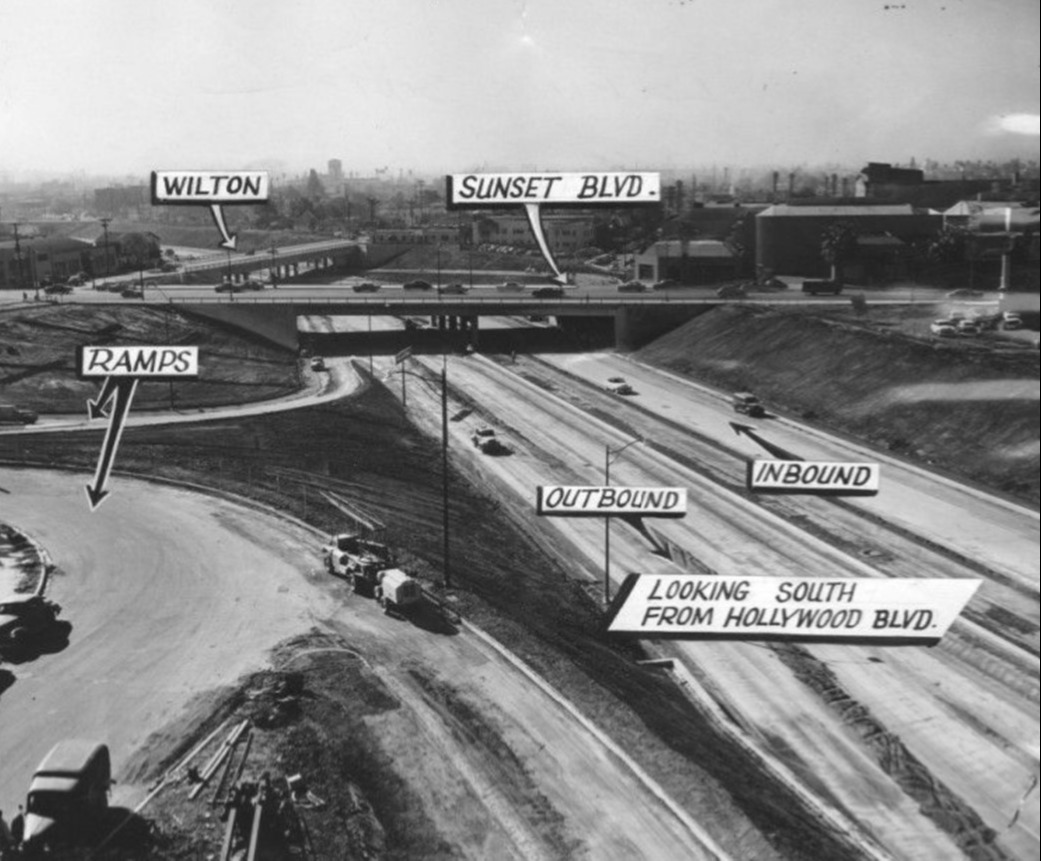 |
|
| (1953)* - Looking south during the construction of the Hollywood Freeway as seen from Hollywood Boulevard. |
Before and After
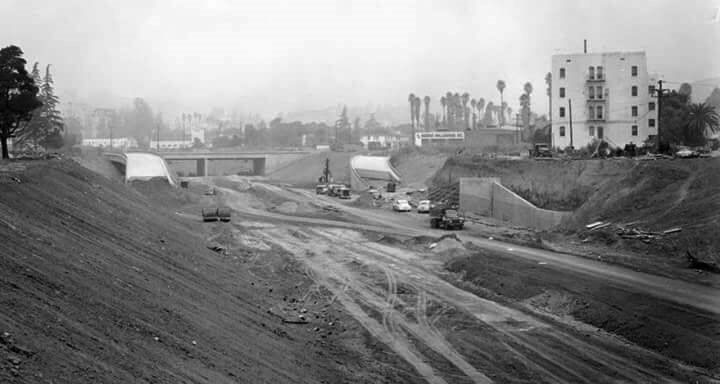 |
|
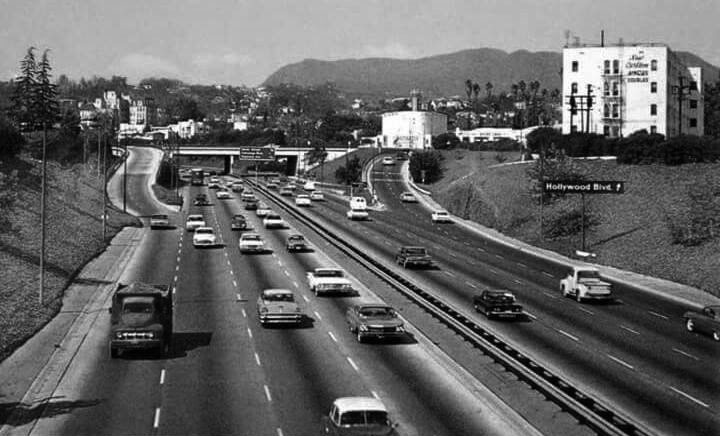 |
|
| (ca. 1952)* vs. (ca. 1970)* - View of the Hollywood Freeway at the Hollywood Boulevard Exit. |
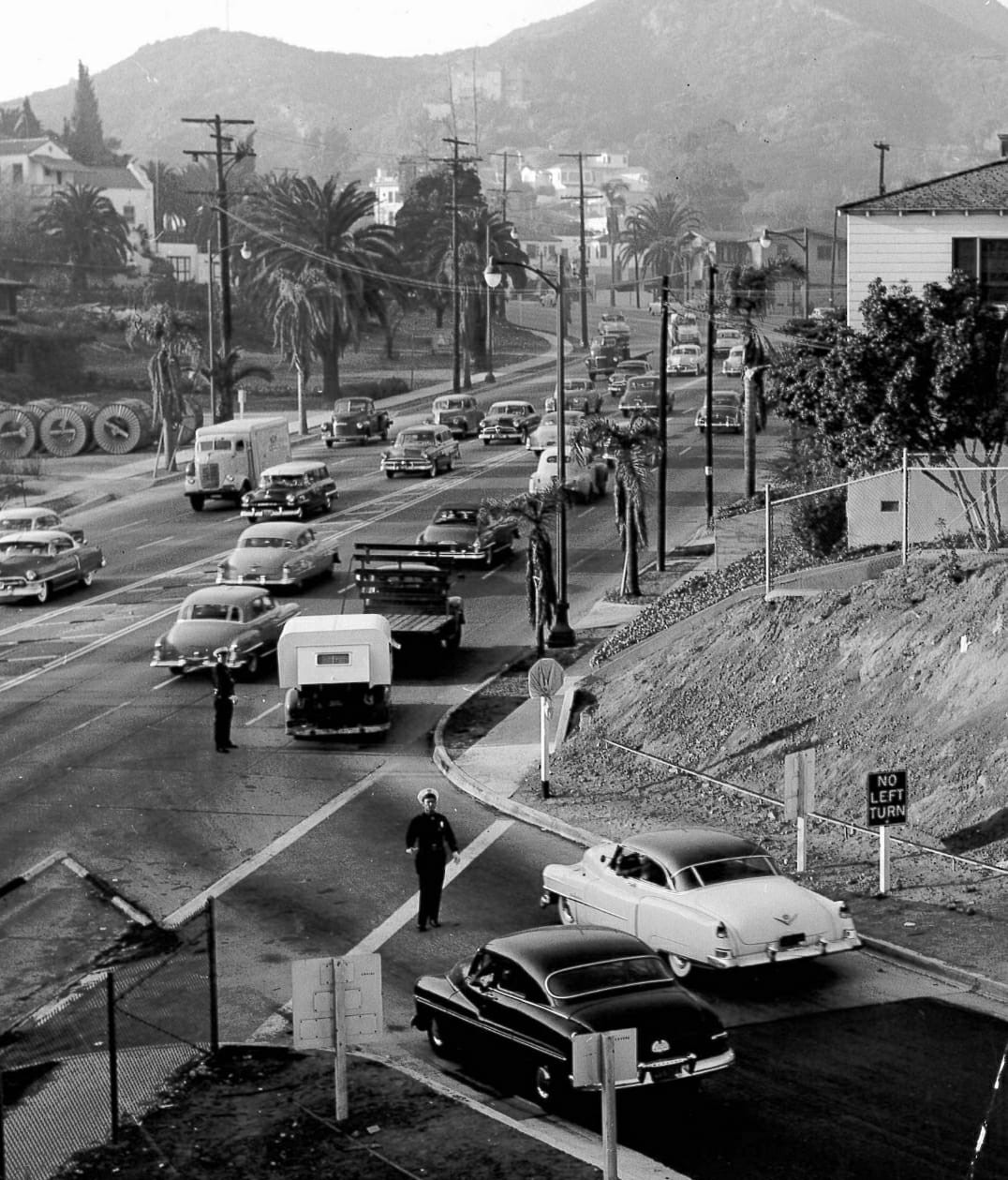 |
|
| (1953)* - Looking north over northbound Hollywood Fwy (US-101) off-ramp at Cahuenga Blvd. Traffic control officers direct traffic while stop sign remains shrouded. Photo date: 10-7-53 |
After Completion of the Hollywood Freeway
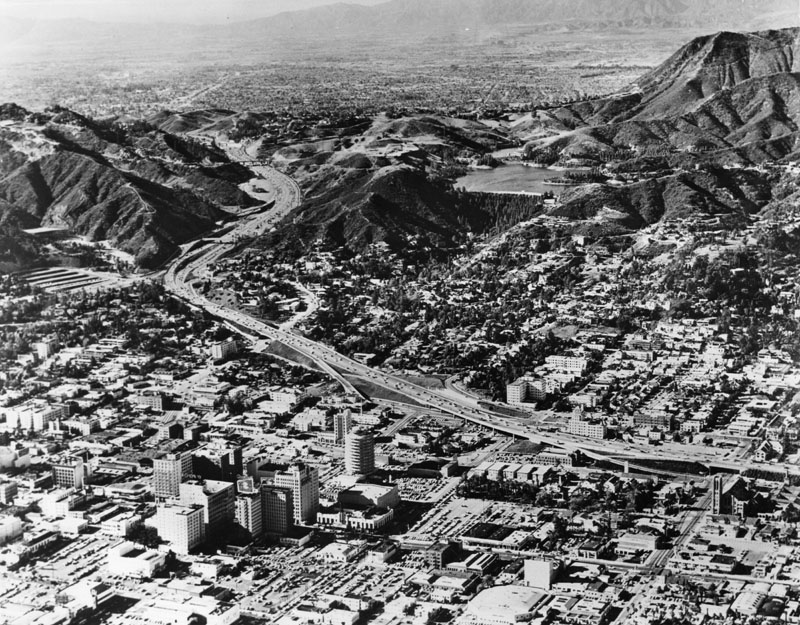 |
|
| (ca. 1960s)* - Aerial view of Hollywood and its surrounding areas after the second segment of the Hollywood Freeway was completed (1954). The Mulholland Dam and Hollywood Reservoir are seen in the hills above Hollywood (upper center-right). Capitol Records Building is in the middle foreground of this photo. |
 |
|
| (1957)^ – Aeiral view giving a closer look at the Hollywood Freeway, Mulholland Dam and Hollywood Reservoir. |
Click HERE to see more in Early Views of Mulholland Dam and Hollywood Reservoir |
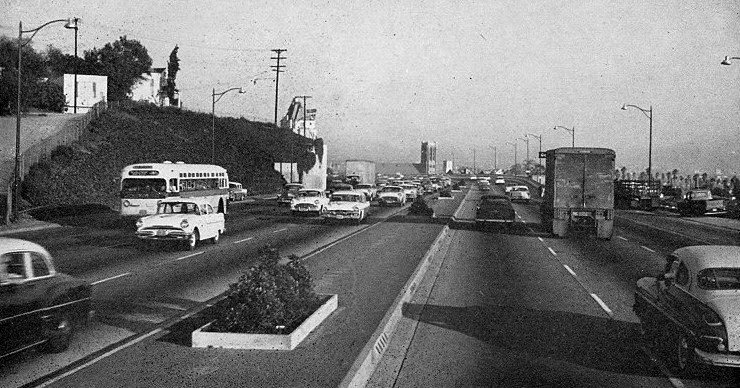 |
|
| (ca. 1955)* – Looking southeast on the Hollywood Freeway near Vine Street. The First Presbyterian Church of Hollywood can be seen in the distance (center of photo). Note the center median with planters. |
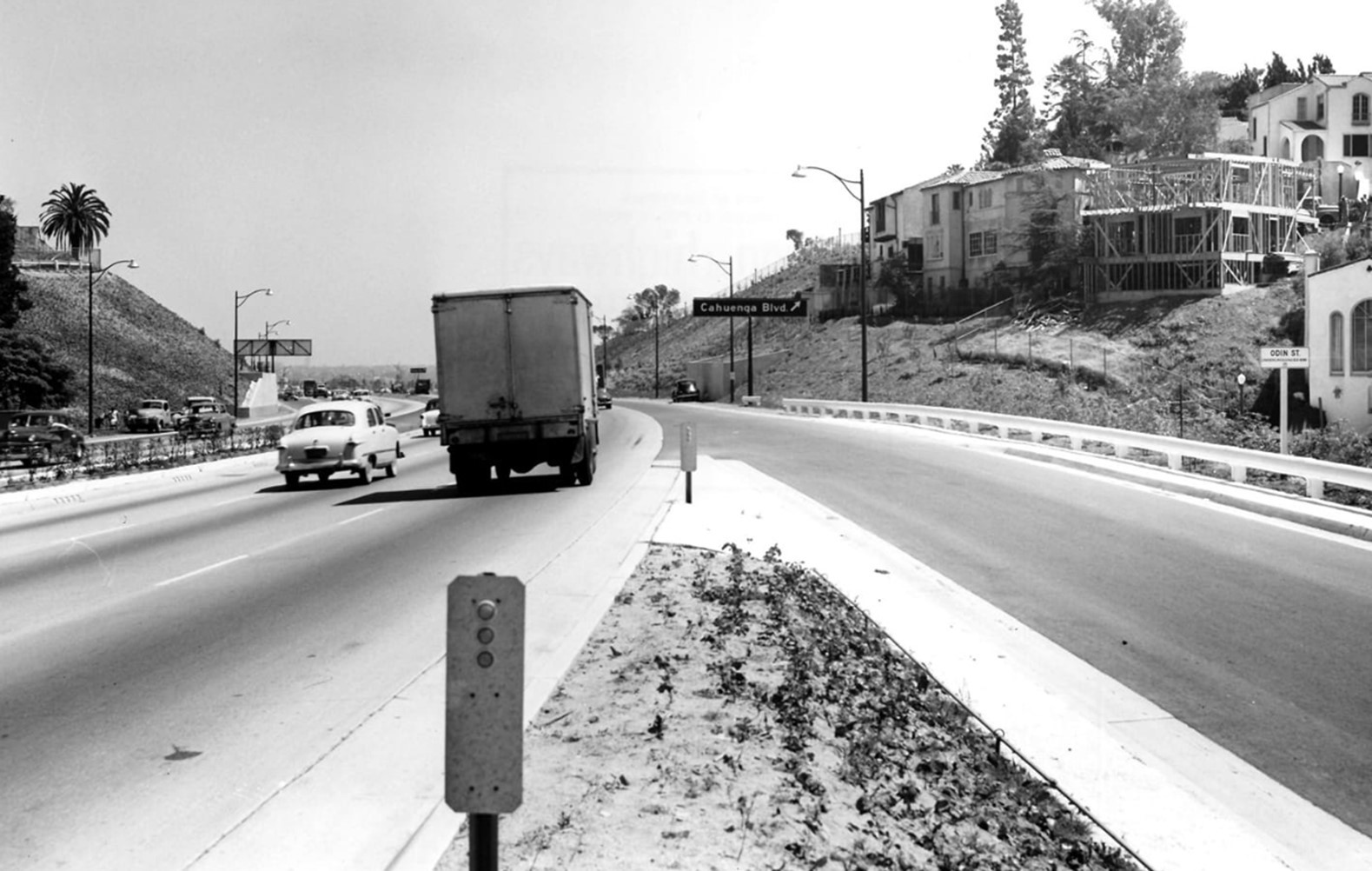 |
|
| (1955)* - Southbound Hollywood Fwy (US-101) at Highland Ave on-ramp in Whitley Heights, approaching Cahuenga Blvd exit. |
Then and Now
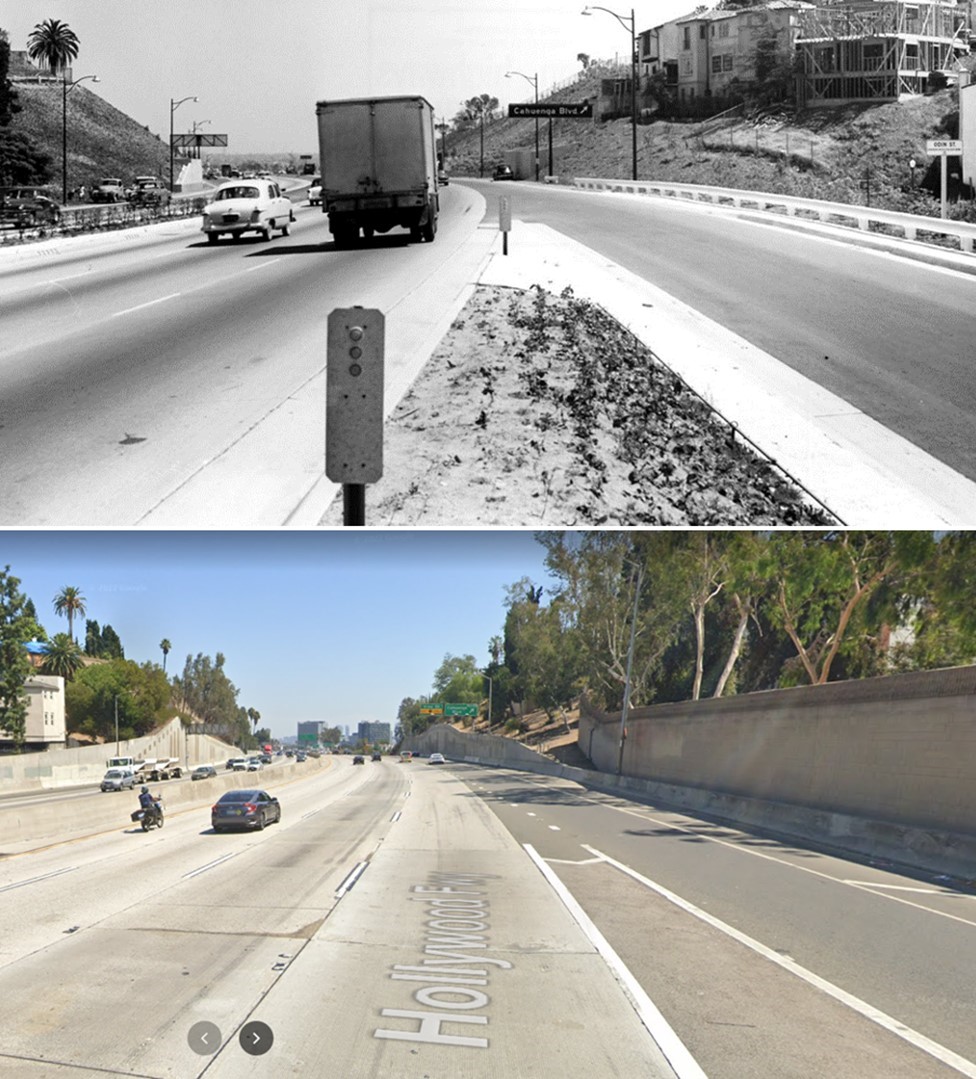 |
|
| (1955 vs 2022)* - Southbound Hollywood Fwy (US-101) at Highland Ave on-ramp in Whitley Heights. |
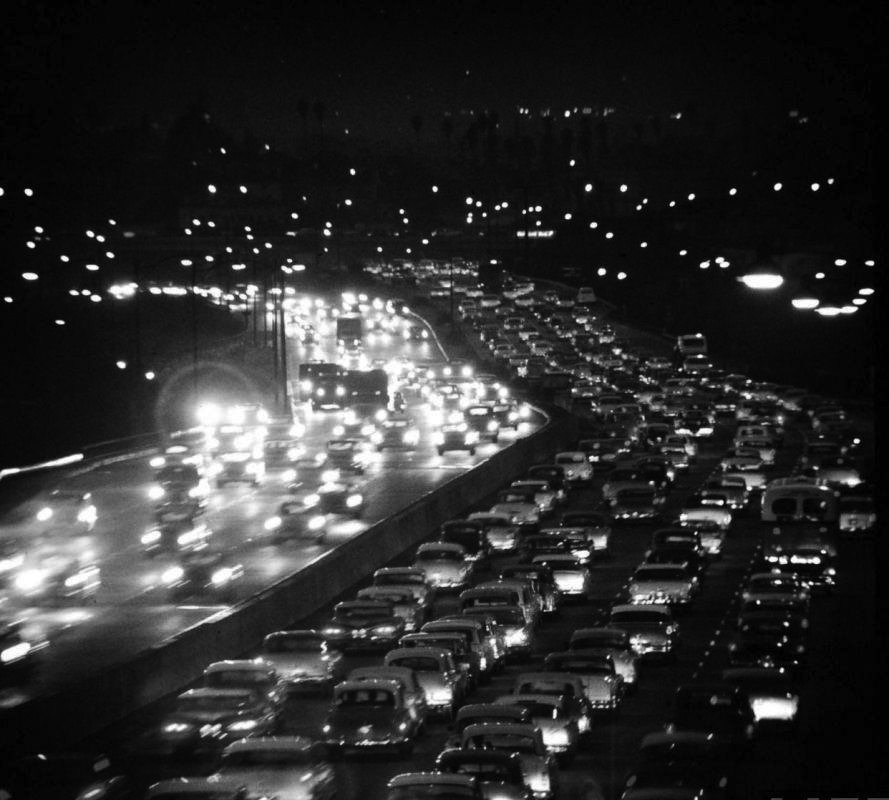 |
|
| (ca. 1959)* – Night view showing heavy traffic on the northbound side of the Hollywood Freeway. |
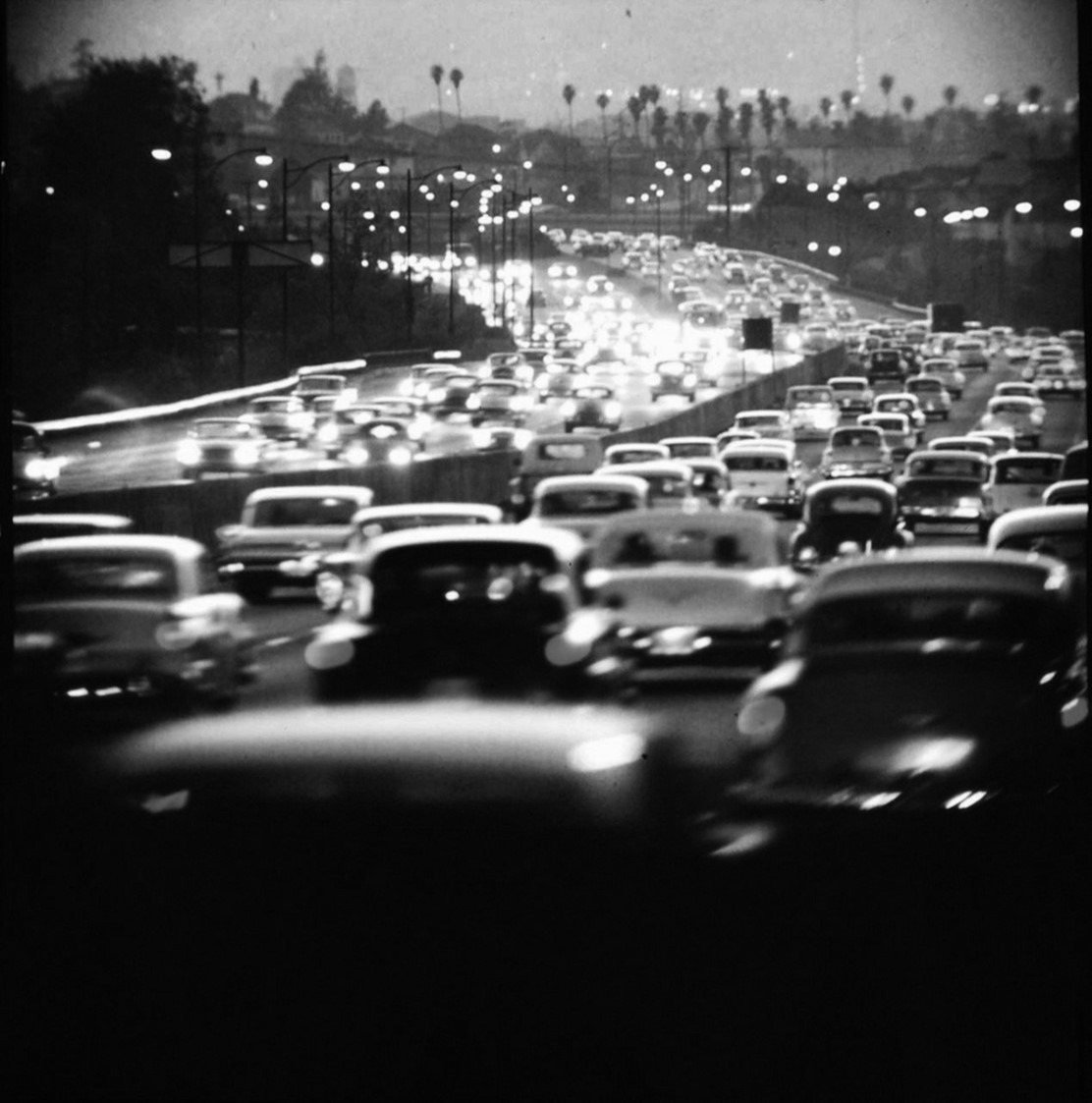 |
|
| (1959)* – Rush hour traffic on the Hollywood Freeway. |
 |
|
| (1960s)* - Hollywood Freeway on a rainy day. |
* * * * * |
Wallichs Music City (Sunset and Vine)
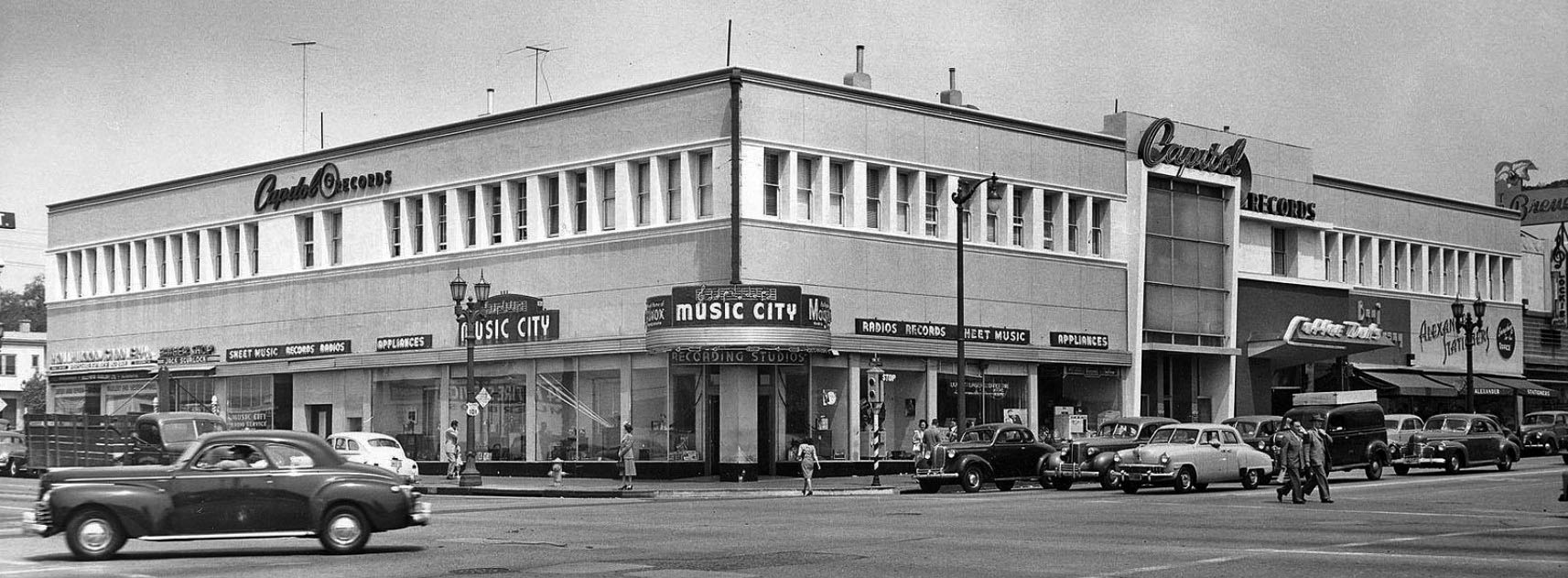 |
|
| (ca. 1946)* – Panoramic view looking northwest across the intersection of Sunset Boulevard and Vine Street showing Wallichs Music City on the corner. Capitol Records is on the 2nd floor. |
Historical Notes Before the Capitol Building opened in 1956 on Vine Street north of Hollywood Boulevard, Capitol Records had, as their corporate offices, the second floor of this building above Wallichs Music City. |
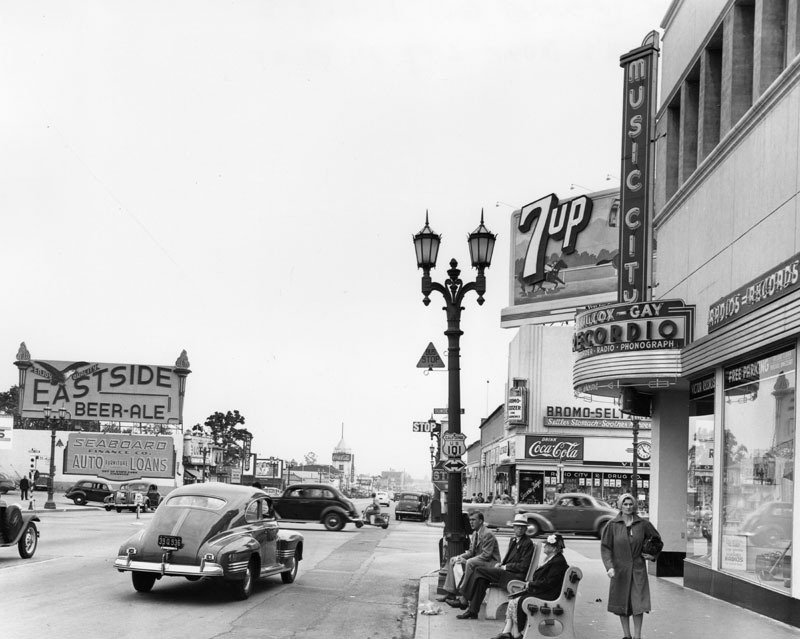 |
|
| (ca. 1945)* - View looking south on Vine Street at Sunset Blvd. Various businesses are seen, including the Wallichs Music City (right). Billboards and signs promote various types of products and beverages, such as locally brewed Eastside Beer. |
Historical Notes Wallichs Music City was located on the northwest corner of Sunset & Vine and operated from 1940 to 1978. Owner Glenn E. Wallichs had started Capitol Records, along with Tin Pan Alley songsmith Johnny Mercer and ex-Paramount movie producer Buddy De Sylva from a small office a little further south down Vine Street in 1942 and moved to larger offices above the store in 1946. After Capitol Records moved into The Capitol Tower in 1956 the offices become the home of Dot Records.^ |
.jpg) |
|
| (ca. 1952)* - View looking west on Sunset at Vine as seen from in front of NBC Radio City. Wallichs Music City is seen on the NW corner. |
Historical Notes Until Tower Records set up on the Sunset Strip 30 years later, Wallichs Music City was the place to go for concert tickets, sheet music, LPs, 45s, tapes, 8-tracks, cassettes, and musical instruments. |
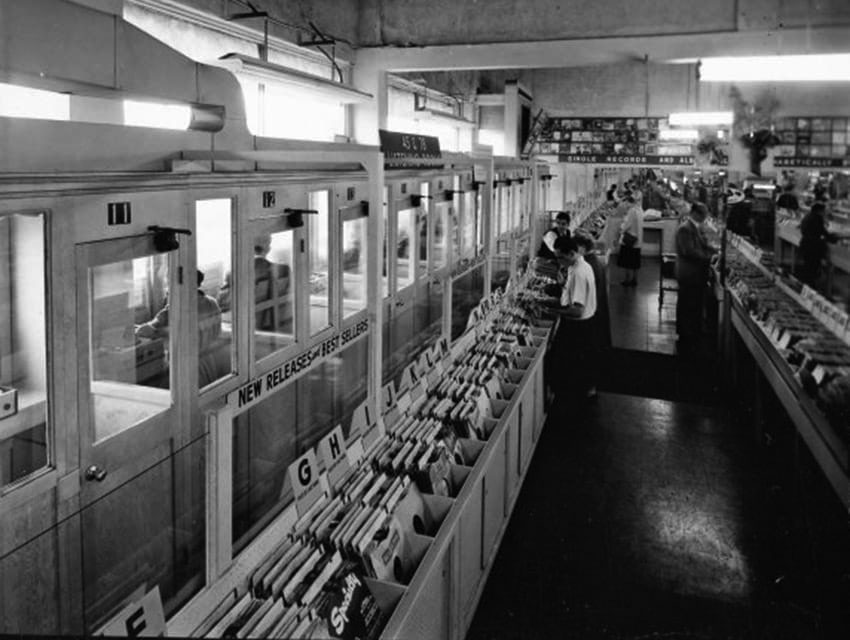 |
|
| (1950s)* - Listening booths inside Wallachs Music City. |
Historical Notes Wallichs Music City was one of the first-known music stores to seal record albums in cellophane and put them in display racks for customers to browse. The racks were tabletop height trapezoid-shaped browser boxes (designed by Capitol Records' Frederick Rice) that allowed the covers they contained to be viewed like a card index without damaging the sleeves. The store was also the first to have demonstration booths for listening to records.^ |
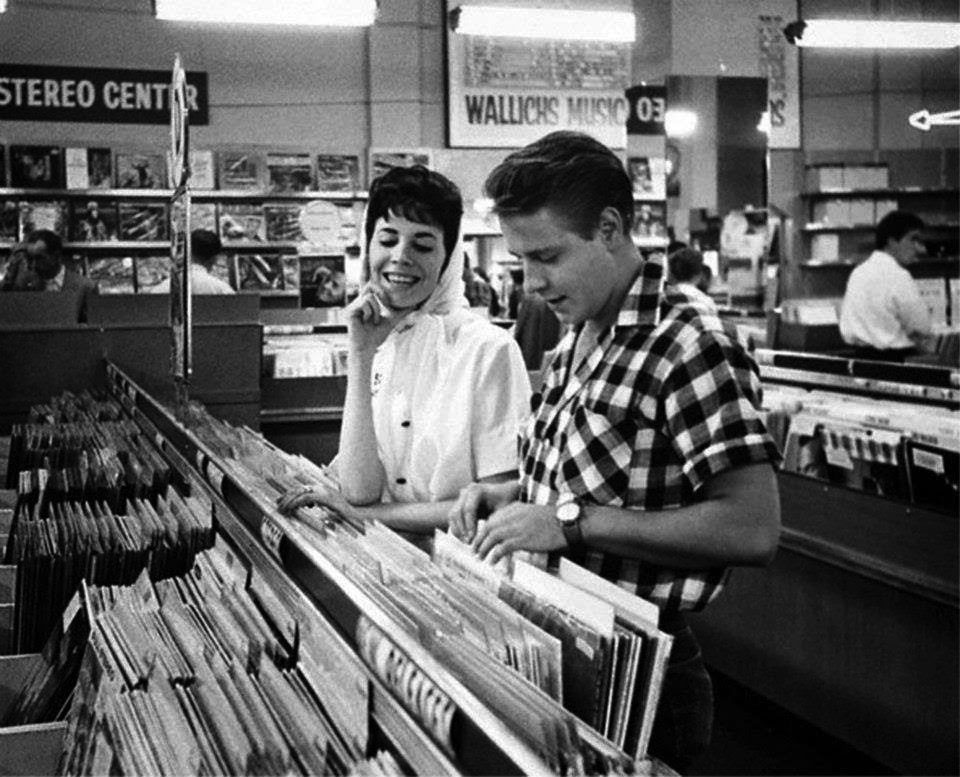 |
|
| (1950s)^ - View showing rock star Eddie Cochran shuffling through albums as one of his fans looks on, at the Wallichs Music City store. |
Historical Notes Edward Raymond 'Eddie' Cochran captured teenage frustration and desire in the late 1950s and early 1960s. Cochran's rockabilly songs included "C'mon Everybody", "Somethin' Else", and "Summertime Blues". He experimented with multitrack recording and overdubbing even on his earliest singles, and was also able to play piano, bass and drums. His image as a sharply dressed and good-looking young man with a rebellious attitude epitomized the stance of the 50s rocker, and in death he achieved an iconic status. Cochran died at the young age of 21 after a road accident, while travelling in a taxi in Chippenham, Wiltshire, during his British tour in April 1960, having just performed at Bristol's Hippodrome theatre. Though his best-known songs were released during his lifetime, more of his songs were released posthumously. In 1987, Cochran was inducted into the Rock and Roll Hall of Fame.^ |
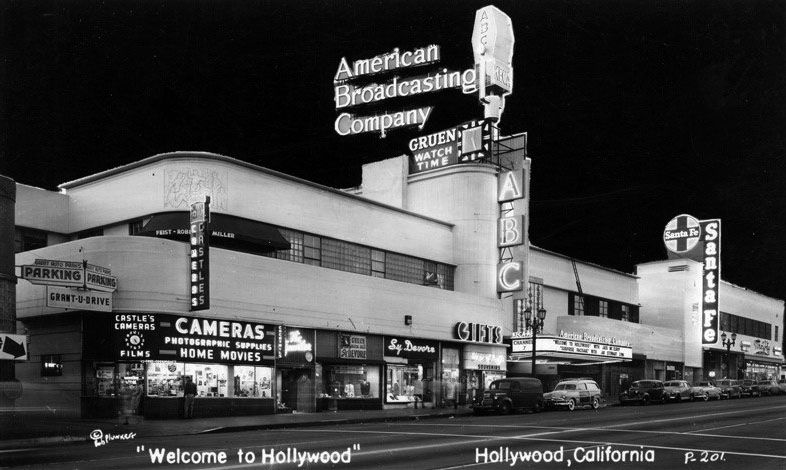 |
|
| (ca. 1949)^^^ - Postcard view of the American Broadcasting Company's Building on the west side of Vine Street north of Sunset Boulevard. This is the same building once occuppied by Tom Breneman's Restaurant. |
Historical Notes American Broadcasting Company broadcast its radio station, KECT from this building. The 790 AM station's callsign was named after Los Angeles broadcasting pioneer Earle C. Anthony, whose initials were also present on then-sister TV Channel 7, KECA-TV (now KABC-TV).*^ In the forties four big national networks dominated the radio industry. The network affiliations were KECA (790 AM, ABC), KFI (640 AM, NBC), KNX (1070 AM, CBS) and KHJ (930 AM, Mutual-Don Lee). |
 |
|
| (ca. 1950)##^* – Close-up view showing the storefronts and signs of the American Broadcasting Company Building located at 1541 N. Vine Street. |
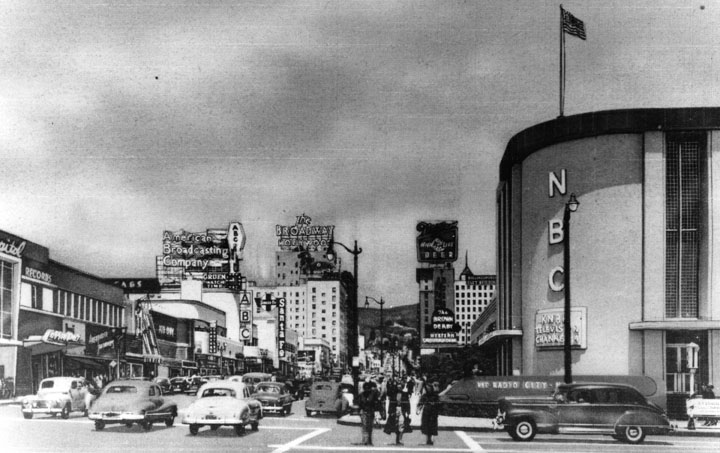 |
|
| (ca. 1950)* - Looking north on Vine Street from Sunset Boulevard. Lots of automobile and pedestrian traffic. Signage on various buildings include American Broadcasting Company, The Broadway-Hollywood, The Brown Derby, and NBC Radio City. |
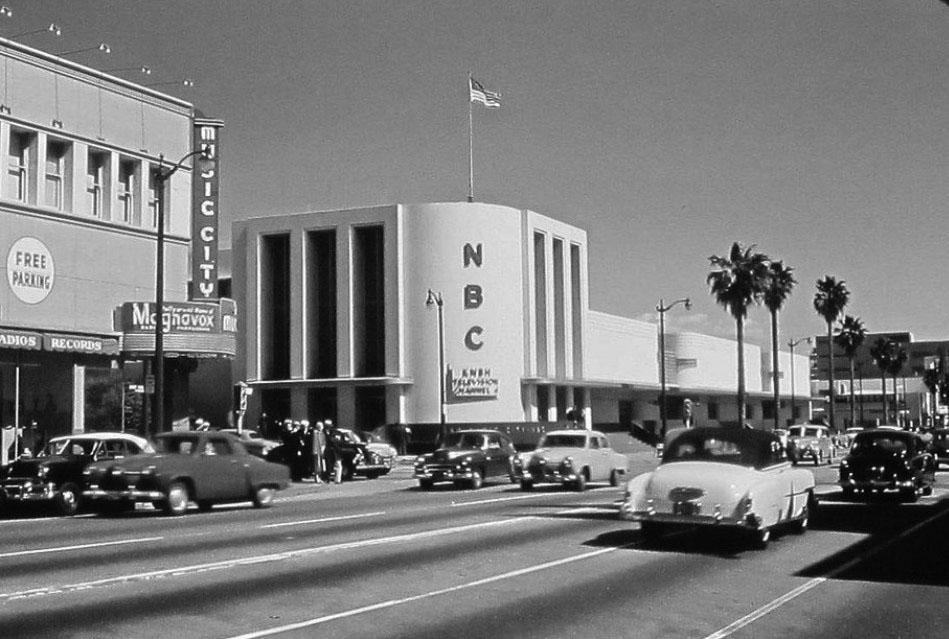 |
|
| (ca. 1950)^##* – View Looking northeast across the intersection of Sunset Boulevard and Vine Street with Wallichs Music City on the NW corner and NBC Radio City on the NE corner. Three Studebakers can also be seen in this shot. |
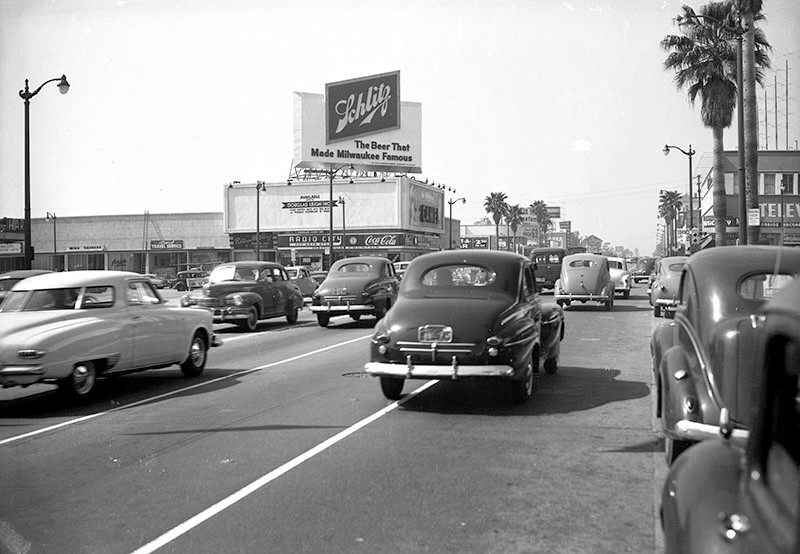 |
|
| (1950)* - Looking southwest across the intersection of Sunset Boulevard and Vine Street. Seen are various businesses (left) and a Foster and Kleiser billboard for Schlitz beer. |
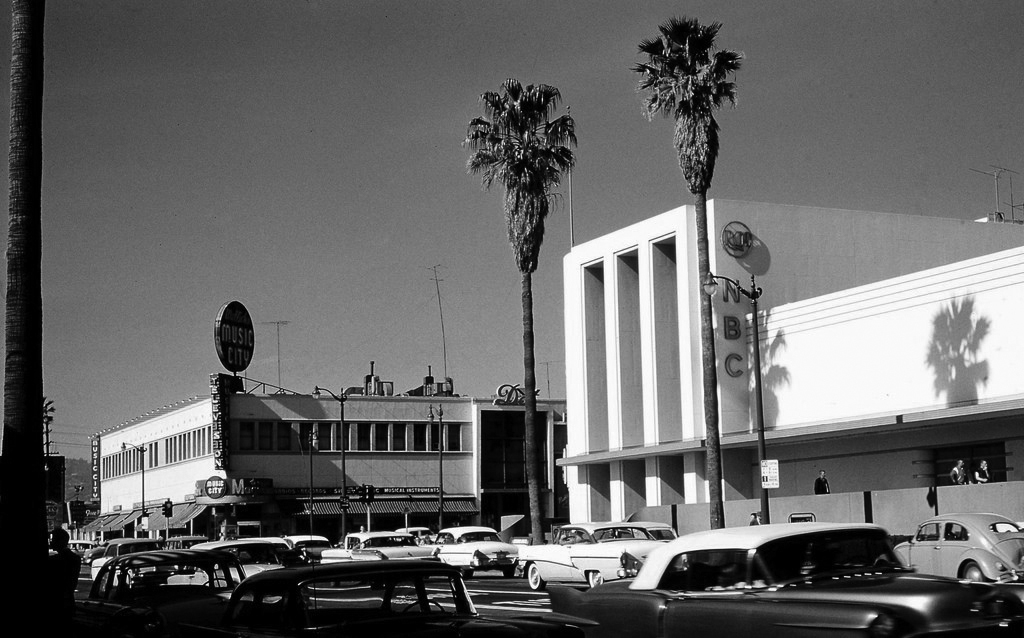 |
|
| (1960)*# – View looking northwest toward the intersection of Sunset and Vine showing Wallichs Music City (NW corner) and NBC Radio City (NE corner). |
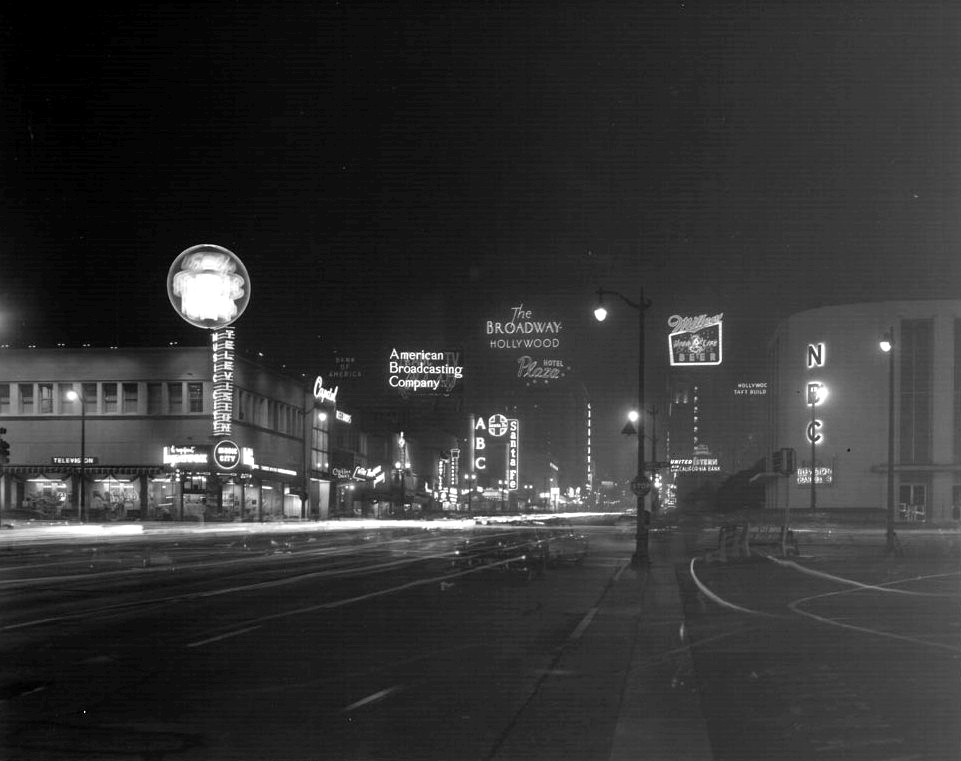 |
|
| (ca. 1950s)^^ - Looking north on Vine Street toward Sunset and Vine showing the neon signs on display. |
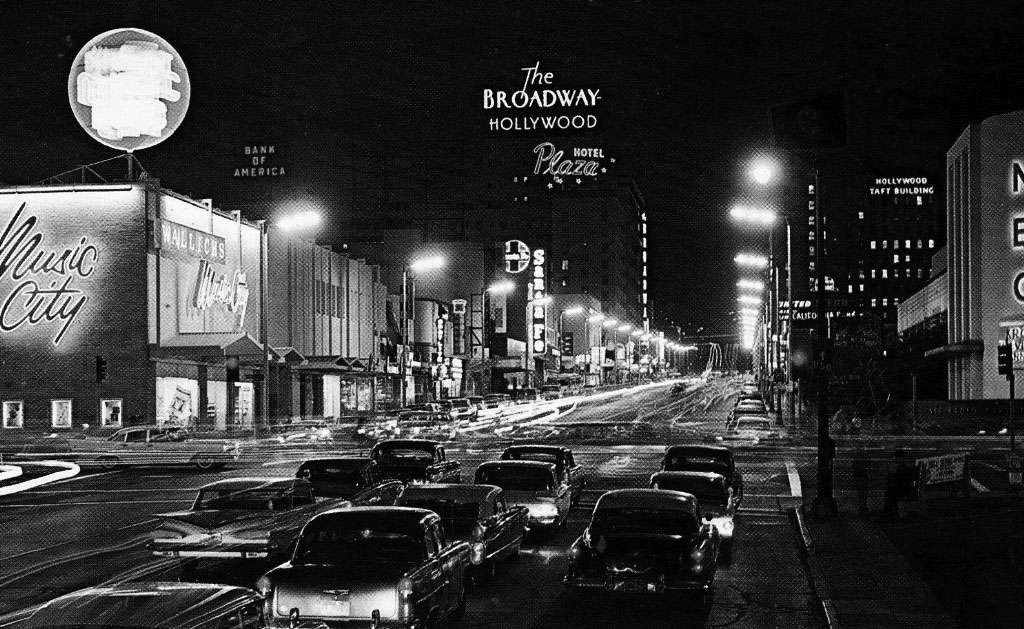 |
|
| (ca. 1960)^##* – Night view looking north on Vine Street at Sunset Boulevard. |
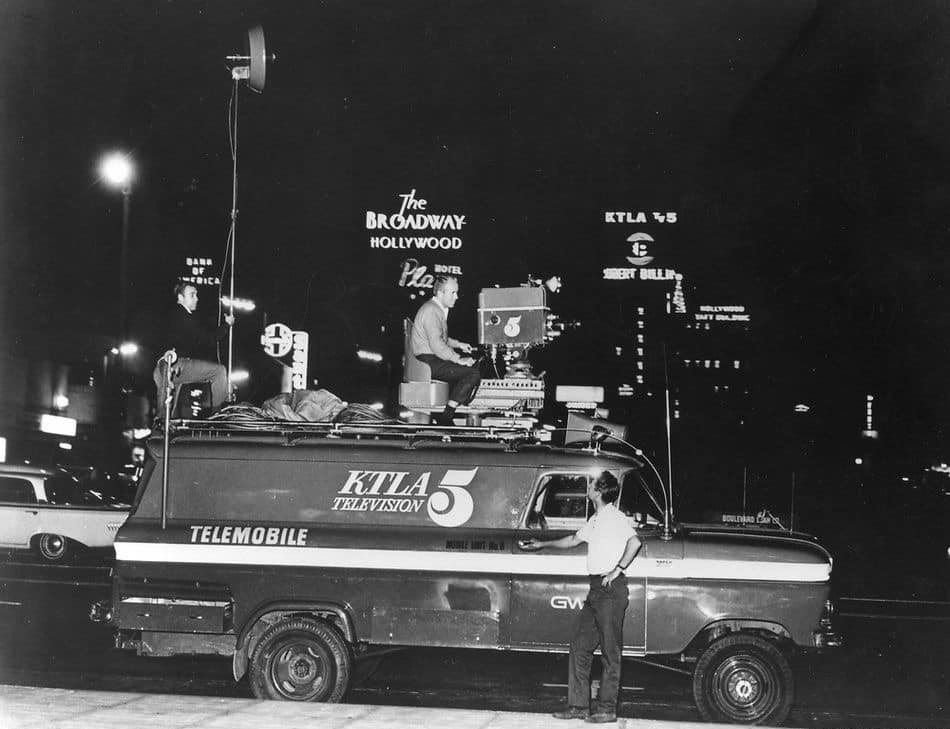 |
|
| (1965)* - KTLA Telemobile at Sunset and Vine. |
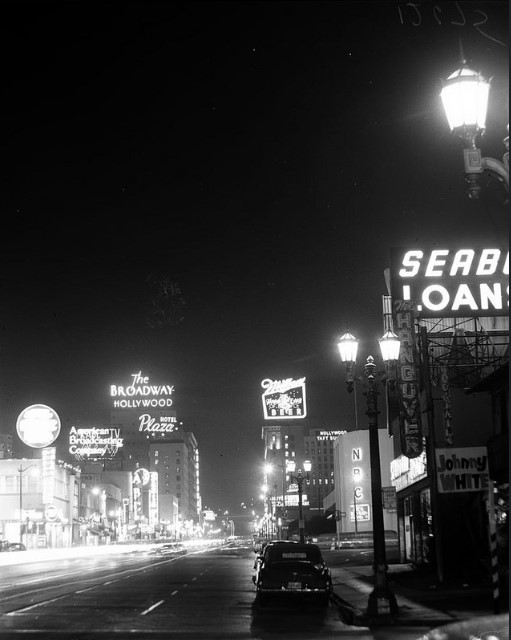 |
|
| (1957)^##* - View of Vine Street looking north, ilumminated by both streetlights and neon signs. The Hangover Nightclub featuring Johnny White can be seen at right. |
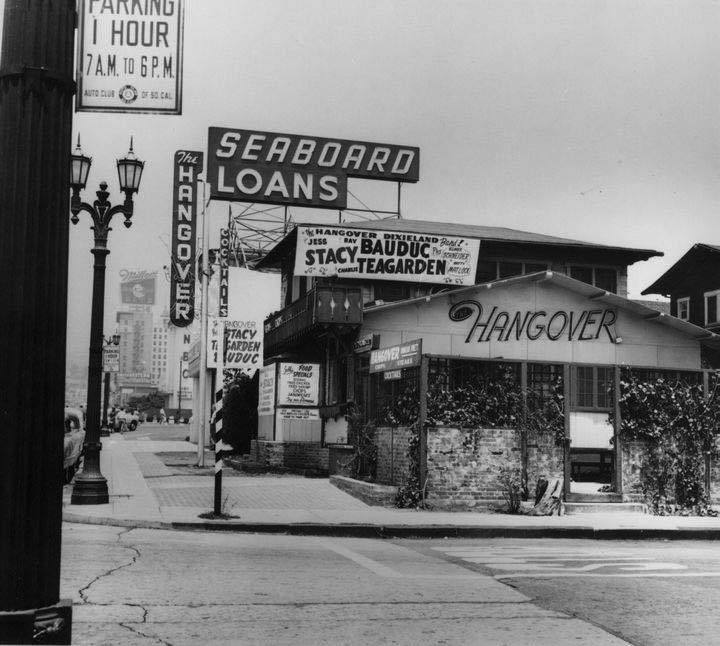 |
|
| (ca. 1960)##^* – Daytime view showing the Hangover Nightclub located on the northeast corner of Vine Street and Leland Avenue. A large rooftop sign reading 'Seaboard Loans' stands tall in the background. Click HERE to see contemporary view of the same corner. |
Hollywood Hotel
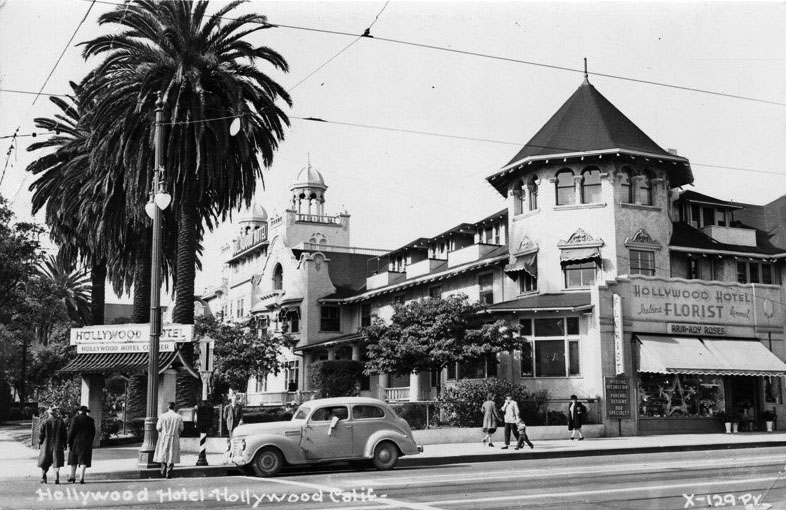 |
|
| (1940s)^^^ - Postcard view of the Hollywood Hotel on the northwest corner of Hollywood and Highland. The hotel’s florist shop fronts Highland and can be seen in the lower right. |
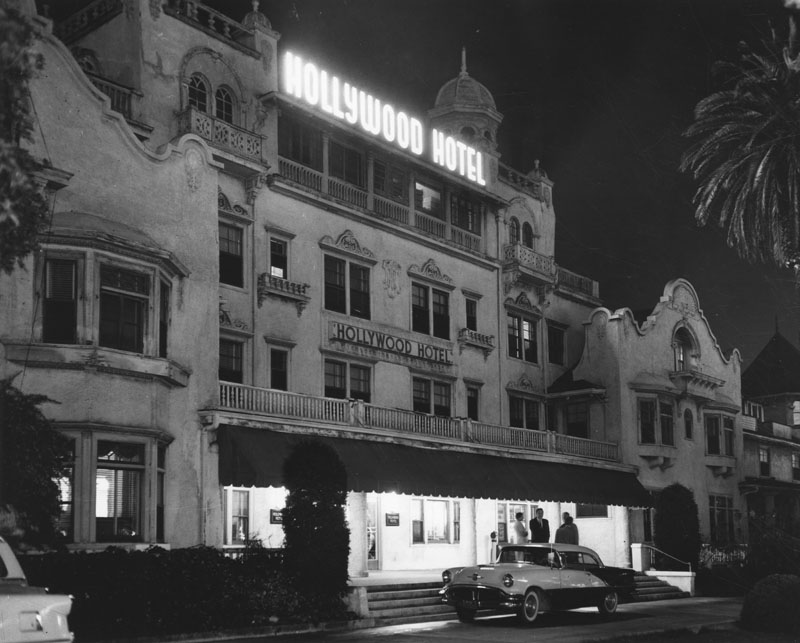 |
|
| (ca. 1956)**# - Night view of the Hollywood Hotel shortly before it would be razed to make room for a new 12-story First Federal Savings and Loan building. |
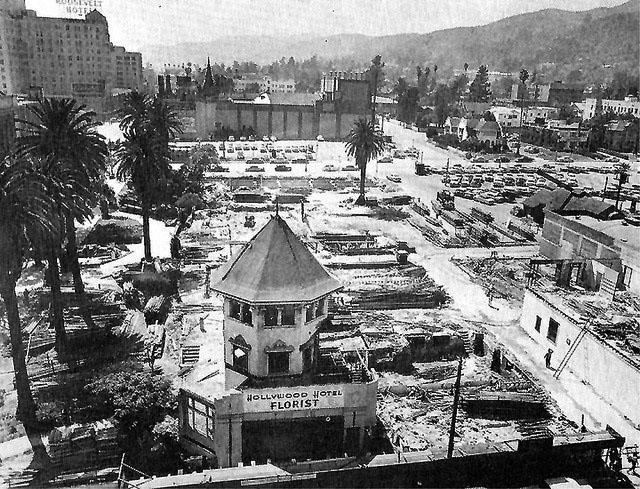 |
|
| (1956)^#^* – View showing the demolition of the Hollywood Hotel, N/W corner of Highland and Hollywood, with only its florist shop left standing. Both the Chinese Theatre and the Roosevelt Hotel are seen in the background. |
Historical Notes Though the Hollywood Hotel housed many of the great stars in its day, it was razed in August 1956 to make way for a $10 million development, with a twelve story office building for the First Federal Savings & Loan Association of Hollywood, a shopping center and parking lots.*^ |
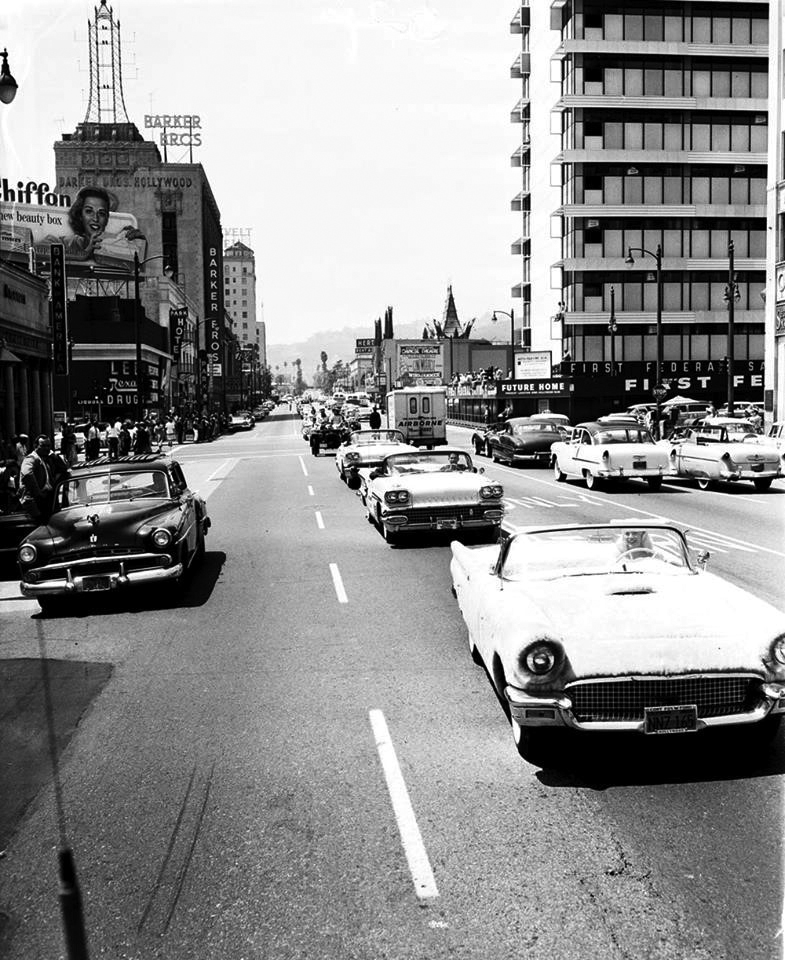 |
|
| (ca. 1959)##^* - View looking west on Hollywood Boulevard showing what appears to be a 1957 Thunderbird convertible heading towards the camera. In the background can be seen the 12-story First Federal Savings and Loan Building on the northwest corner of Hollywood and Highland, where the Hollywood Hotel once stood. |
First Federal Savings and Loan Building
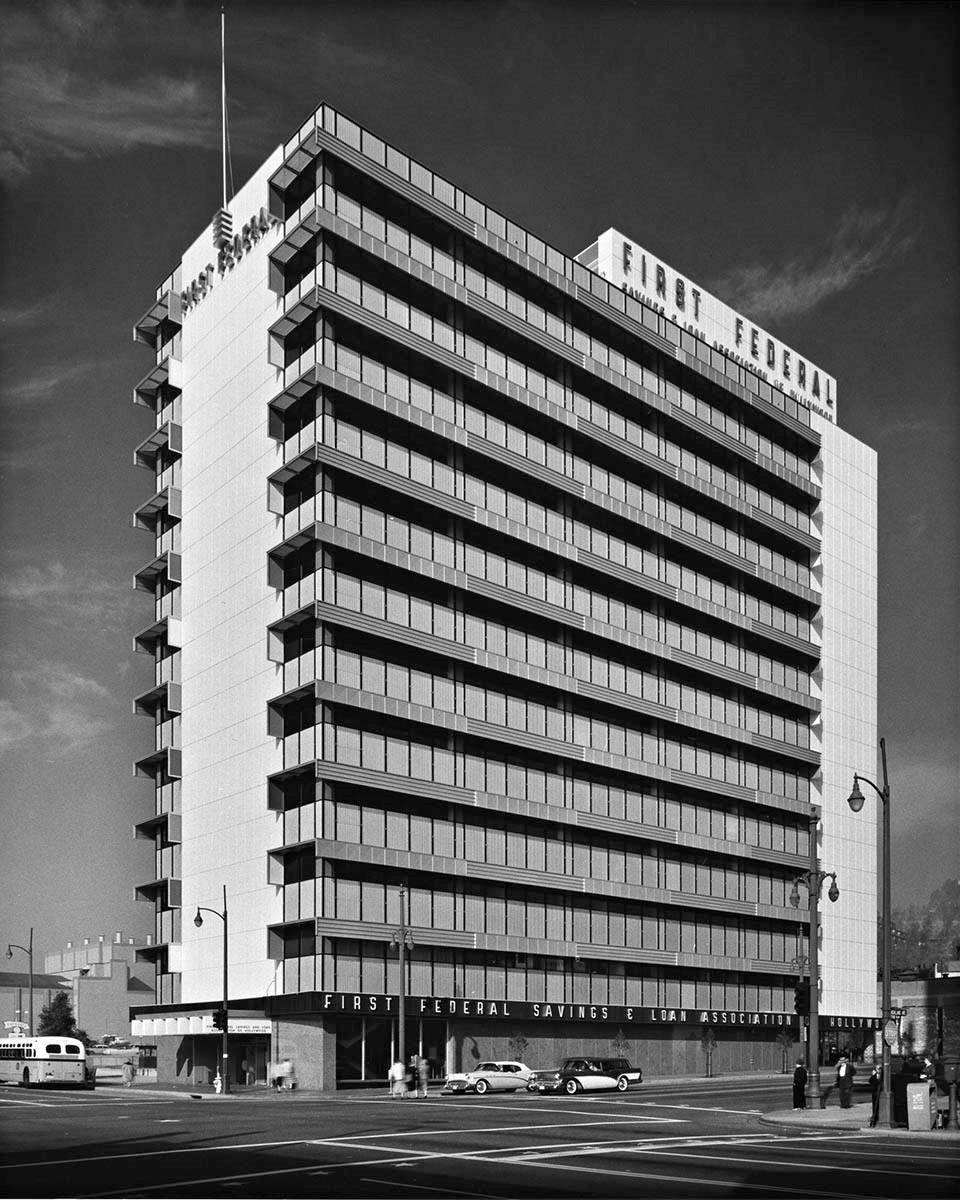 |
|
| (ca. 1959)#+#+ – View looking toward the old location of the Hollywood Hotel (N/W corner of Hollywood and HIghland) showing the newly constructed 12-story First Federal Savings and Loan Building. |
Historical Notes In 1955, the southeast portion of the old Hollywood Hotel property was sold to First Federal Savings and Loan of Hollywood, and in August, 1956, the hotel was razed and the 12-story First Federal building was erected on the northwest corner of Hollywood Blvd. and Highland where it stood from 1959 until 1998.*^ |
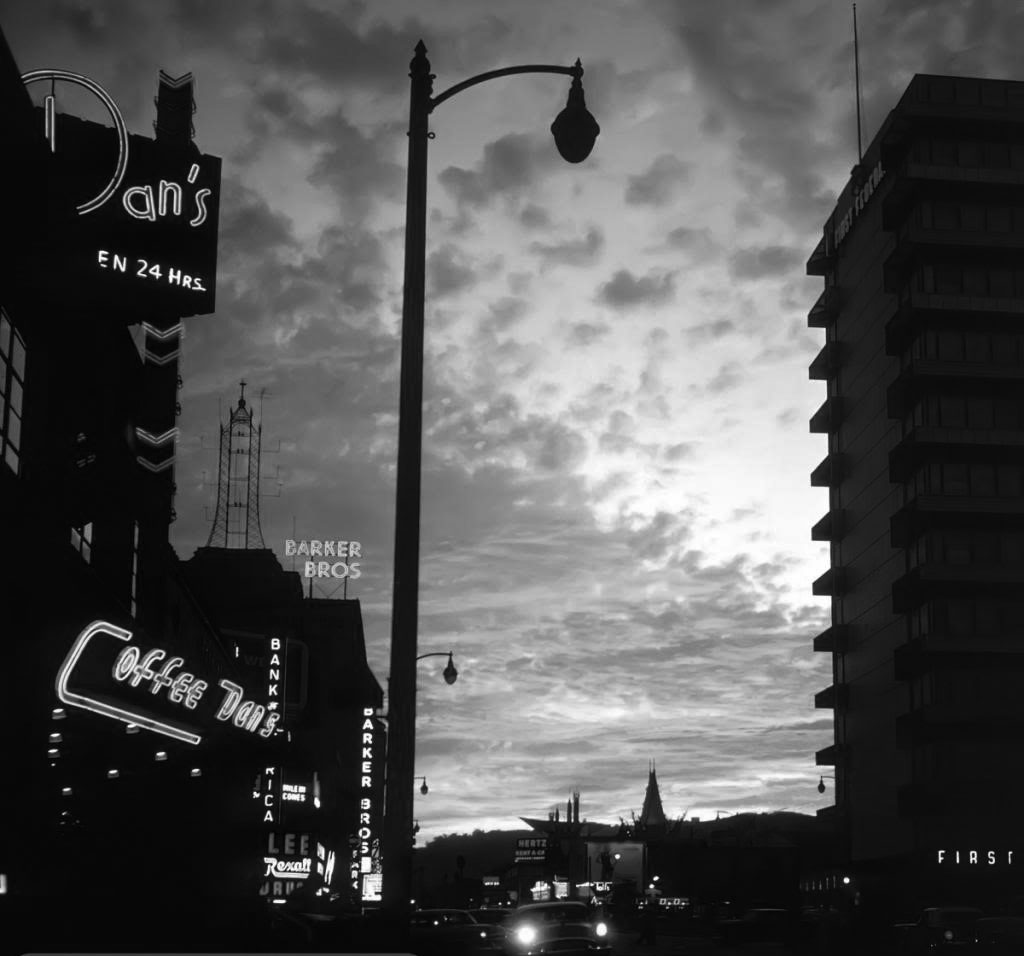 |
|
| (1959)*++– View looking west on Hollywood Boulevard at Highland Avenue showing the First Federal Savings and Loan Building at right (N/W corner) and the Grauman’s Chinese Theatre in the distance. Coffee Dan's, on the left, was a familiar landmark in Hollywood for decades. |
Historical Notes In 1998, the 12-story First Federal Savings and Loan Building was torn down to make way for a new entertainment center. The Hollywood and Highland Center, the current home of the Academy Awards, was constructed on the site in 2001. Click HERE for contemporary view. |
* * * * * |
Hollywood Boulevard
.jpg) |
|
| (1953)*^* - View of Hollywood Blvd. looking east from the roof of the Roosevelt Hotel. The Hollywood Hotel and the Security First National Bank Building can be seen at the intersection of Highland Ave and Hollywood Blvd. |
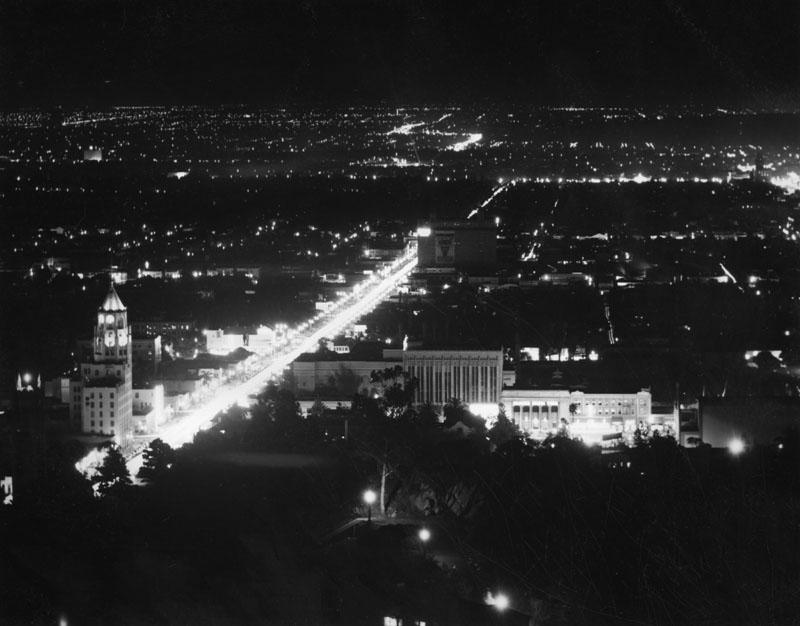 |
|
| (ca. 1957)* - Aerial nighttime view of the Hollywood skyline, with klieg light beacons for movie premieres. View is looking east on Hollywood Boulevard from Highland Avenue. Building on left: First National Bank Building with tower. Right: Paramount Theatre. |
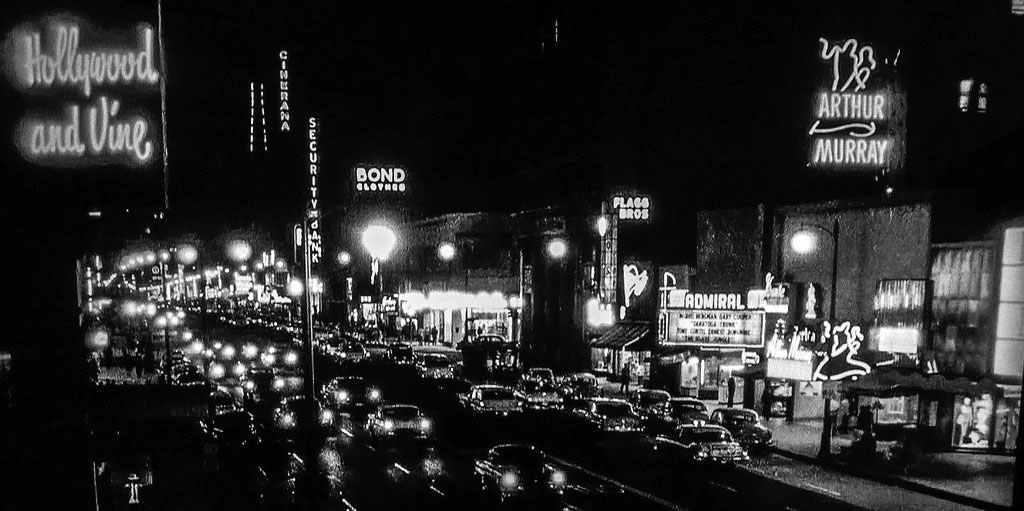 |
|
| (1958)**## – Night shot of Hollywood Boulevard looking west from the Hollywood and Vine corner. The Admiral Theatre we can see on the right opened in 1940, then later became the Vine Theater. Arthur Murray Dance Studio is next door. This is a couple of years before the city of Hollywood initiated it’s Hollywood Walk of Fame with the stars on the sidewalk, sealing the city of Hollywood’s fate as a tourist destination more than a local residential area which it had been for the previous 100 years. |
Sunset Boulevard
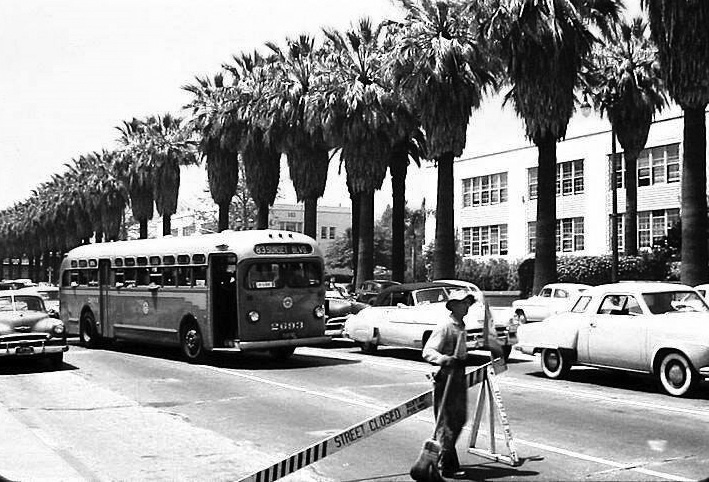 |
|
| (ca. 1951)##^* – View looking west on Sunset Boulevard from near Highland Avenue. Hollywood High School is seen in the background fronted by a row of palm trees. In the foreground a construction worker stands in front of a baricade with a broom in hand. |
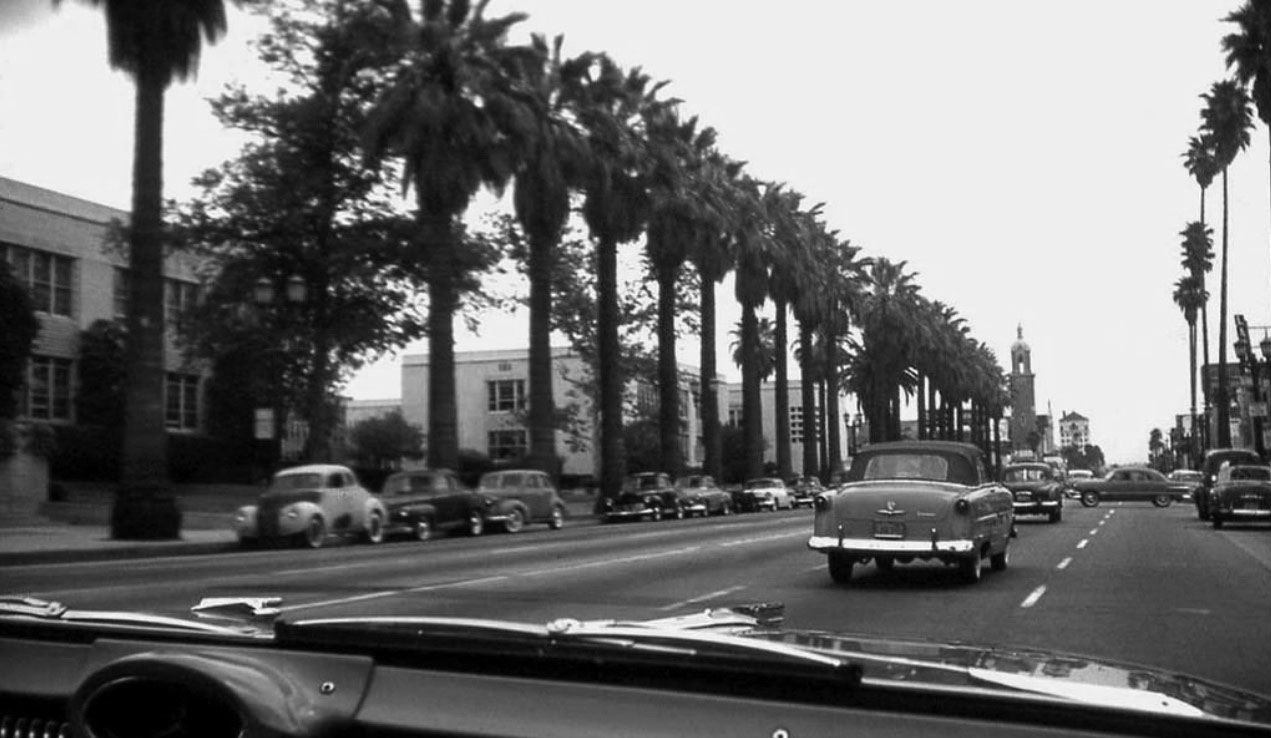 |
|
| (1956)^##*– Dashboard view looking east on Sunset Boulevard toward Highland Avenue with Hollywood High School at left. It appears we’re riding in a new Oldsmobile (‘56 or ‘57). |
Sunset and Highland
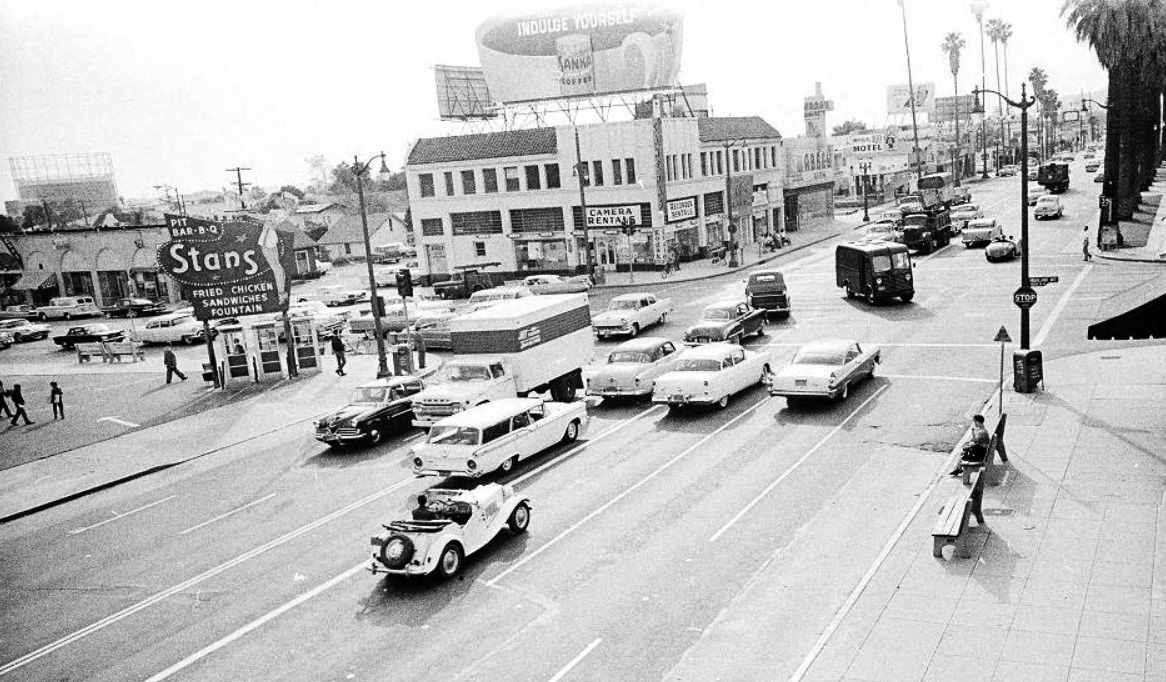 |
|
| (1961)^^ – View looking west on Sunset at Highland showing Stan’s Drive in on the left (SE corner). Hollywood High School (out of view) is behind the palm trees at upper-right. |
Stan's Drive-in (Sunset and Highland, SE Corner)
 |
|
| (1958)^^ - View showing Stan’s Drive-in Coffee Shop on the SE corner of Sunset and Highland, 6760 Sunset Blvd, across from Hollywood High School and Currie’s ice cream. |
Historical Notes Previously, the southeast corner of Sunset and Highland was the site of Simon’s Drive-in…one of two Simon’s on Sunset for a few years (since 1938). As of December 1951, Simon’s became a Stan’s drive-in. Since Stan’s took over the Carpenter’s at Vine that same year, there were now 2 Stan’s on Sunset. |
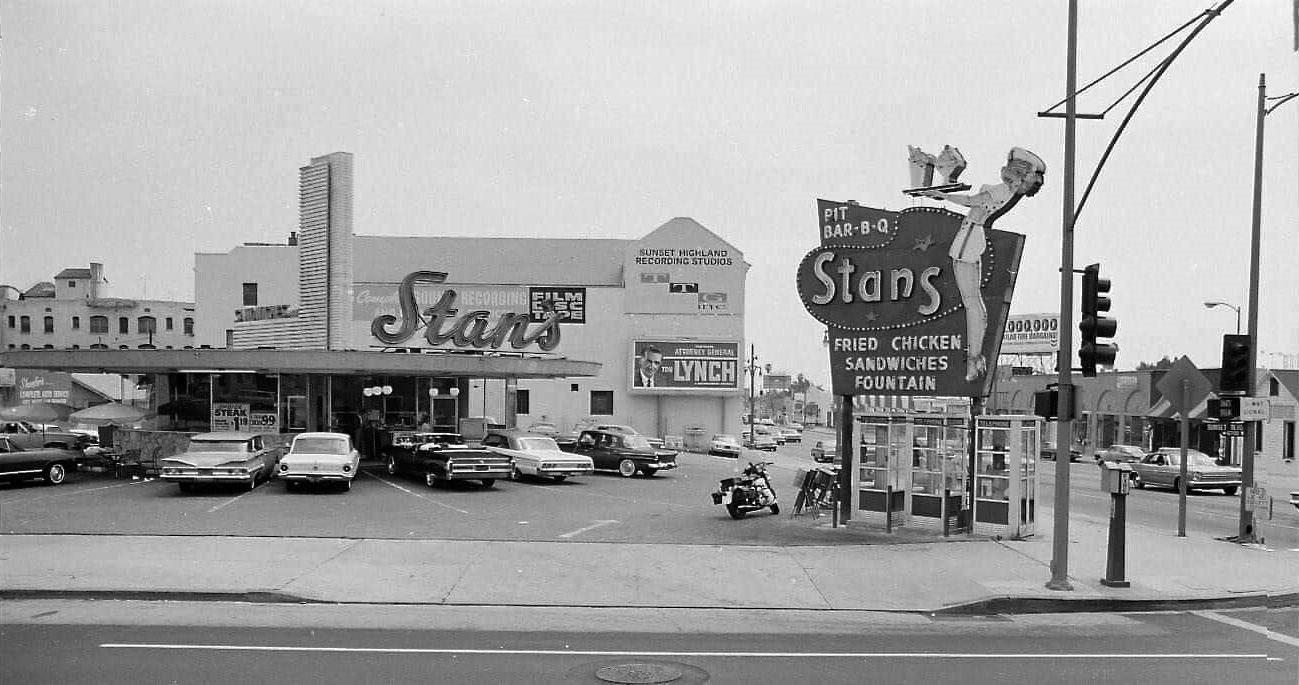 |
|
| (ca. 1966)^.^ - Stan’s Drive-in on the SE corner of Sunset & Highland, kitty-corner to Hollywood High School. Sunset-Highland Recording Studios is seen in the background. |
Historical Notes Stan’s stood on the SE corner as seen above until 1971 when it was demolished. Today, a Chick-fil-A is at the corner. Click HERE to see contemporary view. |
* * * * * |
Stan's Drive-in (East Hollywood)
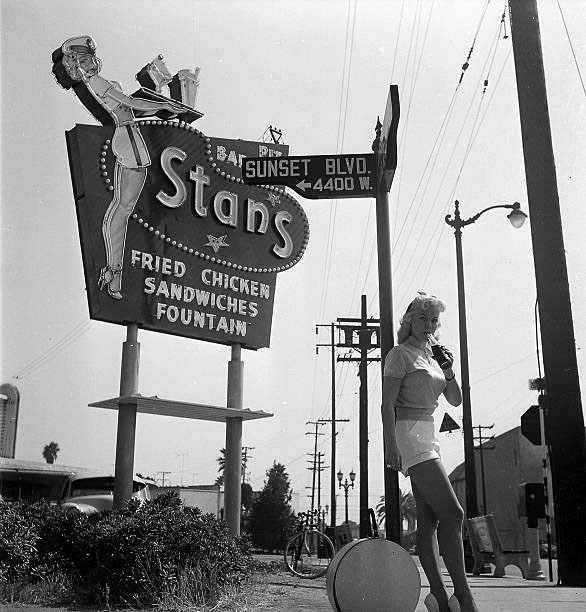 |
|
| (1950s)##^* – View showing a woman drinking a soda while leaning on a street sign post with a Stan’s Drive-in seen in the background on the 4400 block of Sunset Blvd (SE corner of Sunset and Virgil Ave, across the street from the Vista Theatre). Click HERE for contemporary view. |
Historical Notes Stan's was a chain of drive-in's with at least a dozen LA locations built in the late 1950's and 60's. Click HERE to see more in Early Views of LA Drive-in Restaurants. |
* * * * * |
Sunset Boulevard (between Argyle and El Centro Avenues)
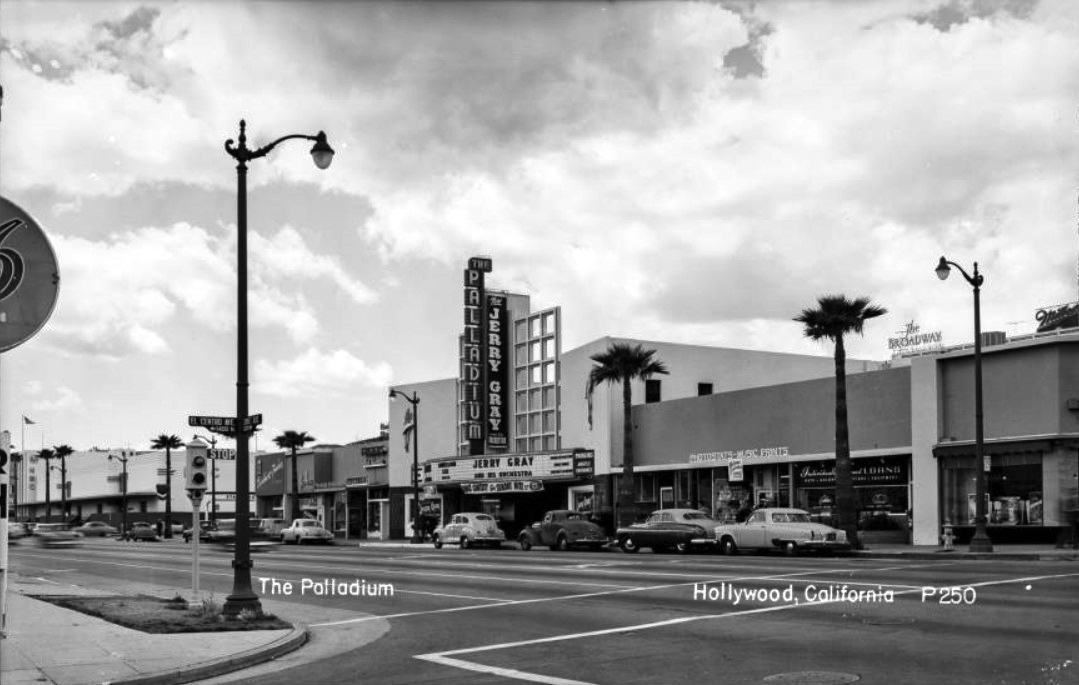 |
|
| (ca. 1950)^** – Postcard view looking NW towards Sunset Boulevard from the intersection of El Centro Avenue, with the Hollywood Palladium at center, Radio City NBC Studios at far left and the Broadway Building Sign in the distance at right. The Palladium marquee reads "Jerry Gray and his Orchestra" next to a storefront with a sign for Photostats - Music Prints" |
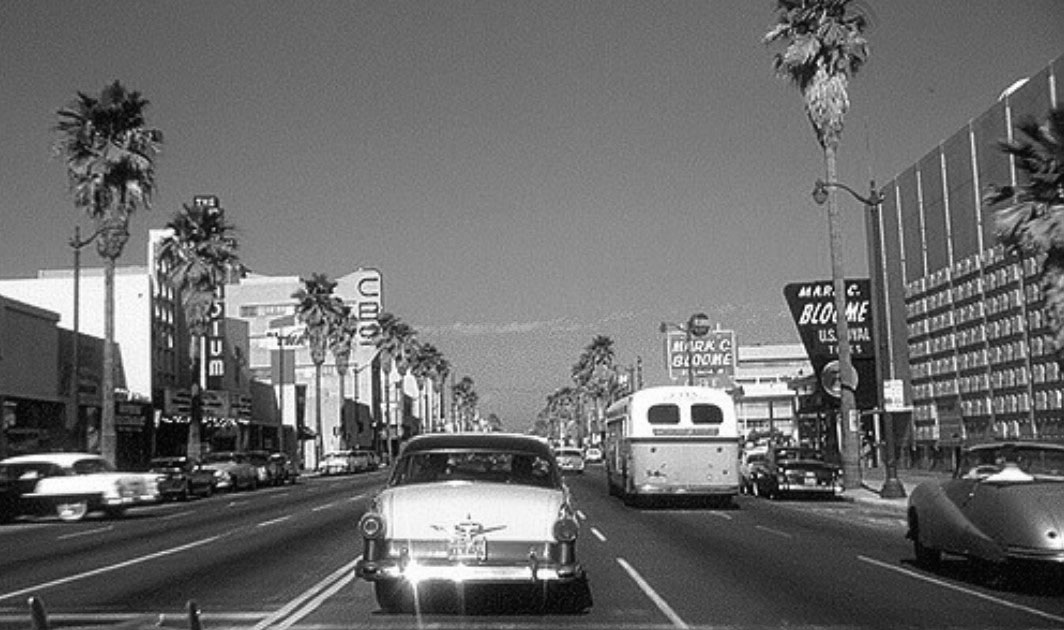 |
|
| (1959)+#+# – View looking east on a plam tree-lined Sunset Boulevard at Argyle Avenue. From left to right can be seen: Hollywood Palladium, CBS Columbia Square, Mark C. Bloome, and the Earl Carroll Theatre. |
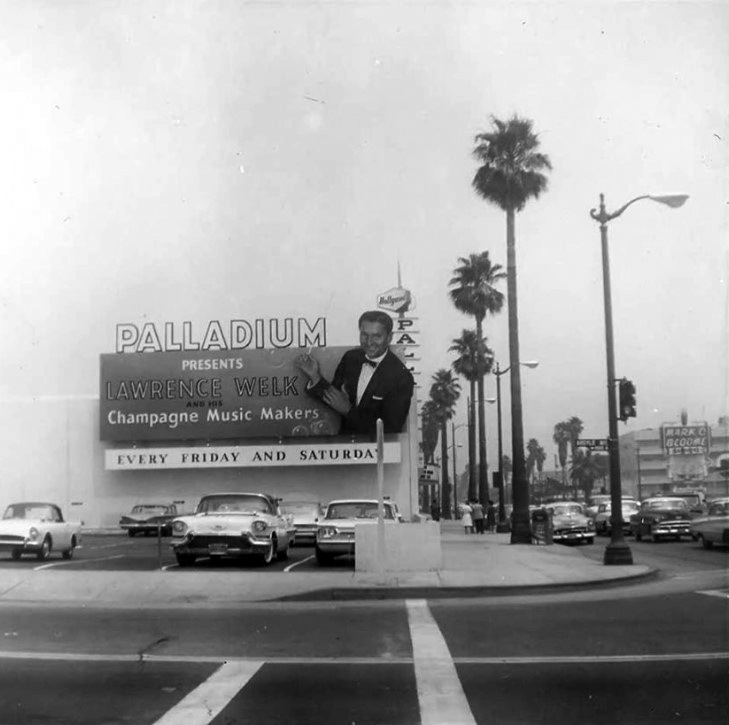 |
|
| (ca. 1959)^.^ – View looking east across Argyle Avenue towards the Palladium showing an oversized bilboard for Lawrence Welk and his Champagne Music Makers on the west face of the building. Mark C. Bloome can be seen across the street (south side of Sunset). Click HERE to see contemporary view. |
Hody's Coffee Shop
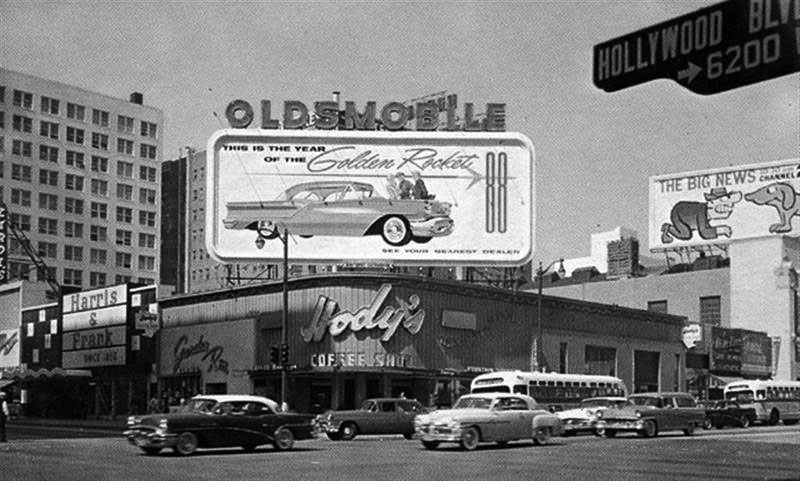 |
|
| (1957)* – View looking at the northwest corner of Hollywood and Vine showing Hody’s Restaurant (previously Melody Lane Cafe). Signboard on top of building shows a 1957 Oldsmobile Rocket 88. |
Historical Notes In 1940, restaurateur Sidney Hoedemaker of the Pig 'N Whistle - Melody Lane chain, leased the northwest corner Hollywood and Vine transformed it into a Melody Lane Restaurant. In 1949, Hoedemaker founded Hody's Restaurant Inc. Hoedemaker's restaurants were all about service, efficiency, cheerfully and courtesy. One was always greeted with a smile. And in 1955, Hody's restaurant group signed a 20 year lease for the property on the northwest corner of Hollywood Blvd and Vine Street. Hoedemaker had it remodeled extensively. |
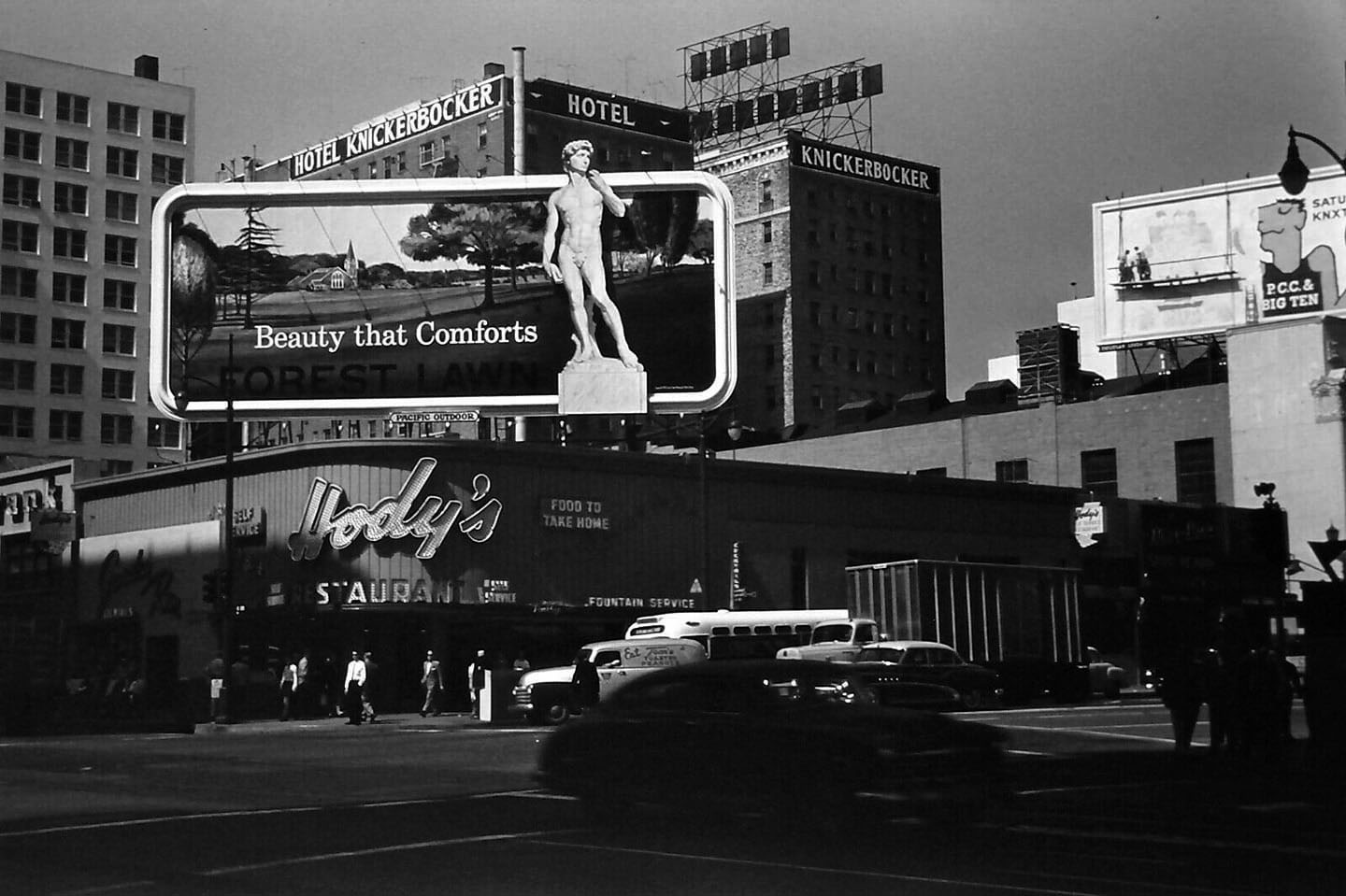 |
|
| (1950s)^ - View showing Hody’s Coffee Shop with a Forest Lawn advertisement on it’s large roof-mounted signboard. The Hotel Knickerbocker is seen in the background. |
 |
|
| (1959)^ – Nighttime view showing Hody's Coffee Shop located on the N/W Corner of Hollywood and Vine (previously Melody Lane Cafe). |
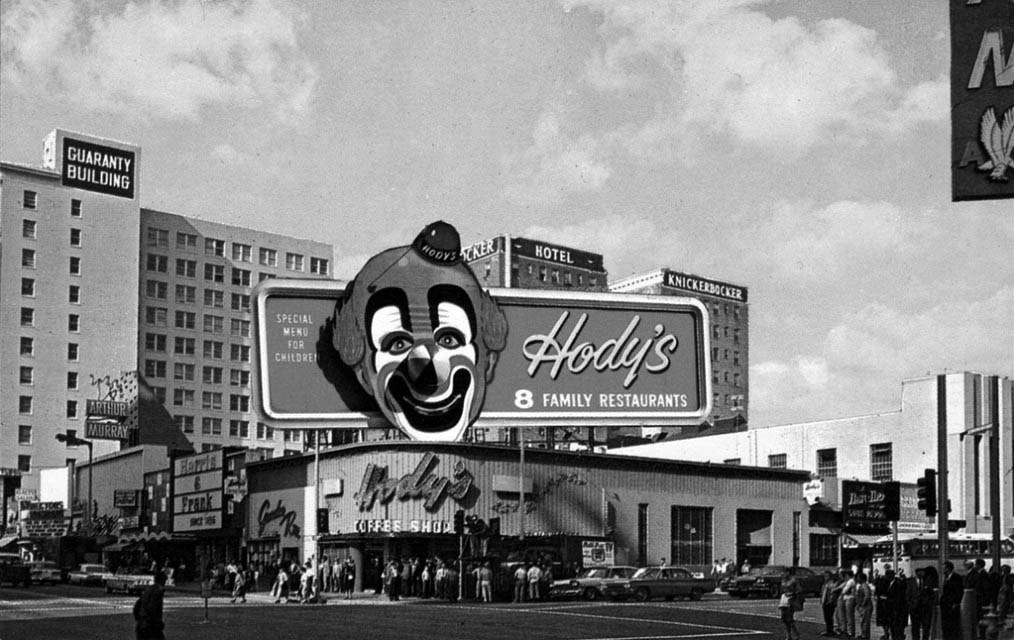 |
|
| (ca. 1961)^ – Daytime view of Hody’s Coffee Shop, N/W Corner of Hollywood and Vine, with the Guaranty Building and Hotel Knickerbocker seen in the background. Next door to Hody's to the west was a Harris & Frank Clothiers and an Arthur Murray School of Dance studio. |
Historical Notes Hody's was a family restaurant. Kid's would get a kid's clown menu that could be worn on their face. By 1969 there were 8 Hody's restaurants in Southern California. |
* * * * * |
Hollywood Ranch Market (Originally Mandarin Market)
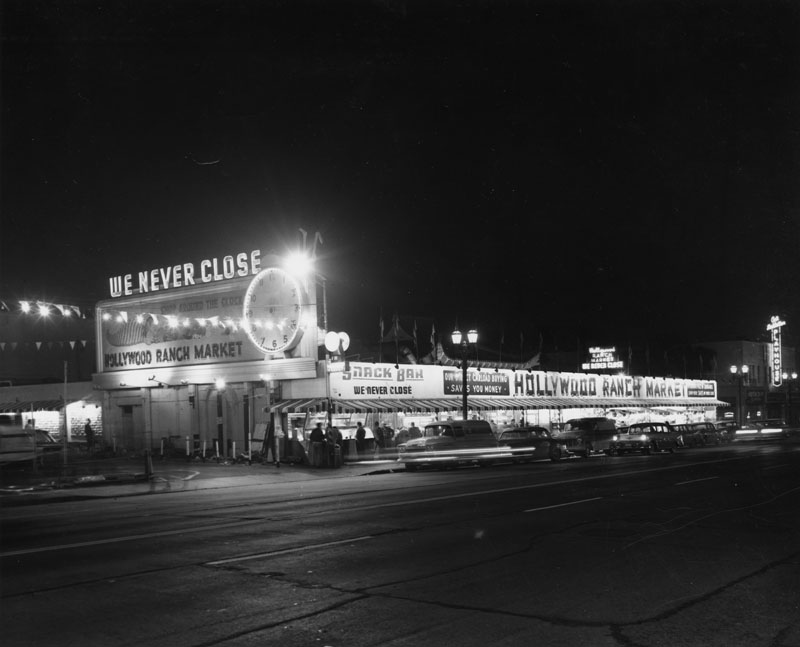 |
|
| (1961)* - Exterior view of the Hollywood Ranch Market, located at 1234-1248 Vine Street. The market with its large neon sign and the neighboring Art Linkletter Playhouse are clearly visible. Remnants of the original Chinese influenced architecture from when the building served as the Mandarin Market are visible above the roof line in the center of the photograph. |
Historical Notes The Hollywood Ranch Market started out as The Mandarin Market. Built in 1929, it was touted as being one of the first drive-in markets of its kind in Los Angeles. The architect was Henry L. Gogerty, who later designed "gliding acoustical walls" for classrooms, and assembly line buildings for Howard Hughes' Spruce Goose project.^*^# Click HERE to see the original Mandarin Market. |
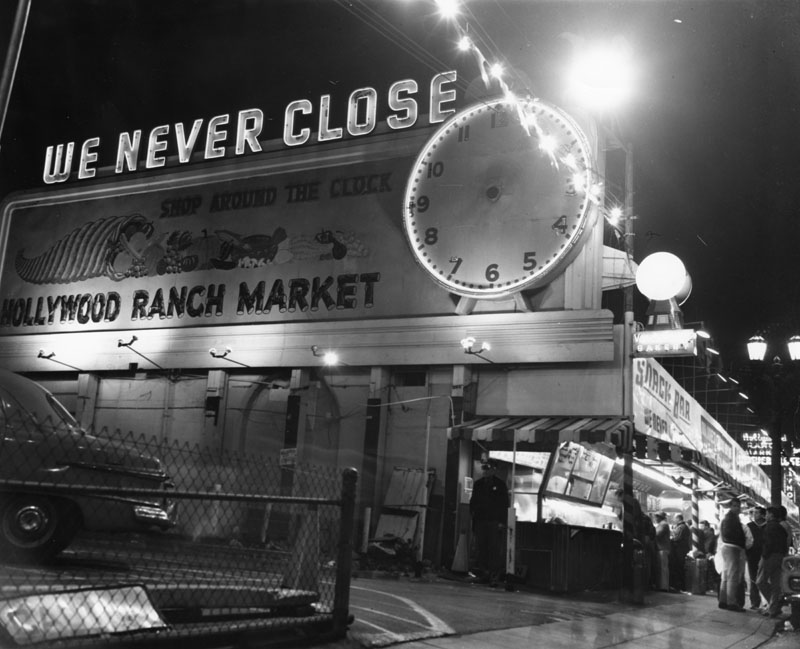 |
|
| (1961)* - Closer view of the Hollywood Ranch Market. The market's neon sign with a clock reads, "We never close" and "Shop around the clock." This side view only allows one of the market's vendors, the snack bar, to be visible. |
Historical Notes It wasn’t unusual to see such personalities as Frank Sinatra, Ava Gardner or Red Skelton or at the Hollywood Ranch Market’s snack bar. Steve Allen used to broadcast his shows from his studio close by. ^#^^ |
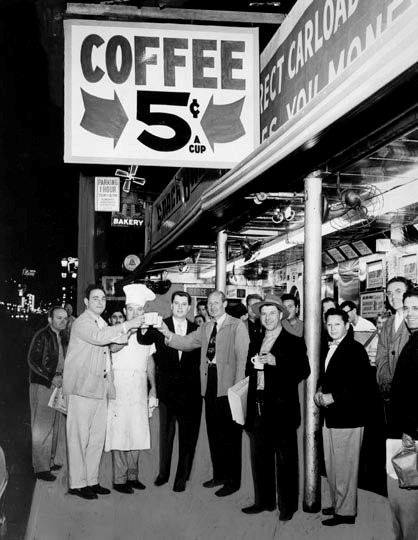 |
(1954)* - Herald Examiner photo showing several men toasting with a cup of coffee in front of Hollywood Ranch Market.
|
Historical Notes Examiner article reads: "The all-night Hollywood Ranch Market sidewalk lunch counter on Vine Street is one of many places revolting against the hike in coffee prices. This place reduced its price from 10 cents to 5 cents per cup. Celebrating with steaming mugs beneath the sign are, left to right: Richard Wilson, jazz musician-composer; night manager Roy McCully; co-owner Larry Frederick; writer Roger Fair; and newsboy Eddie Levin, on February 2, 1954." * |
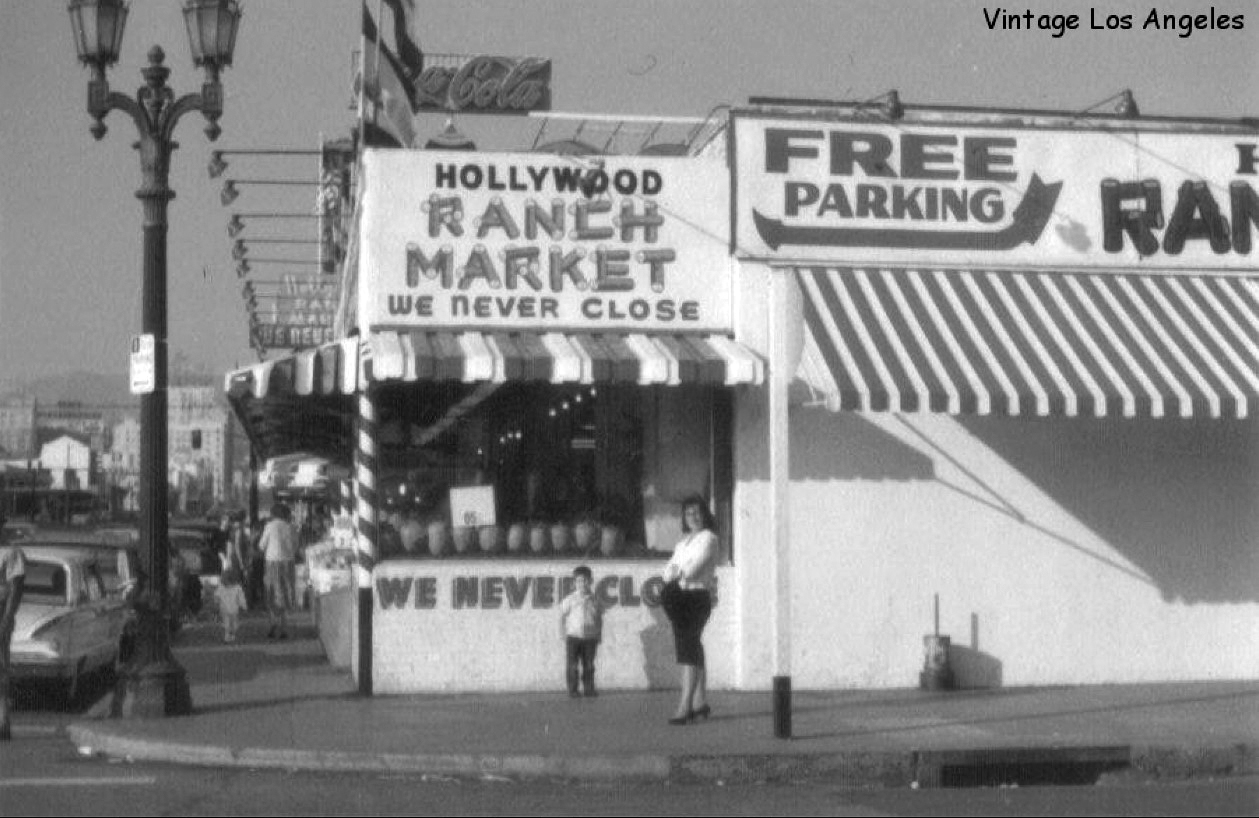 |
|
| (ca. 1960s)^#^^ – View looking north showing a woman and young child standing in front of the Hollywood Ranch Market on the northeast corner of Vine Street and La Mirada Avenue. |
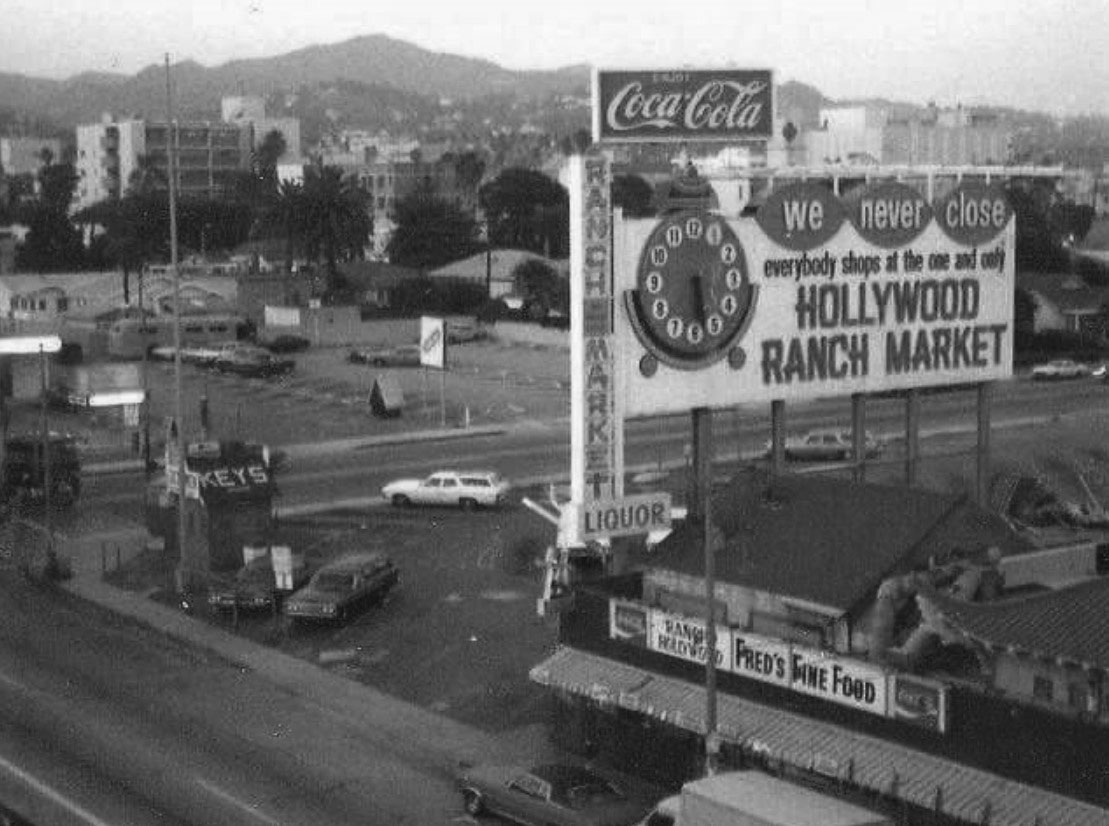 |
|
| (1970s)##^* – View looking northeast toward the Hollywood Hills and Mt. Lee with the Hollywood Ranch Market at lower right. The large sign reads: We Never Close – Everyone Shops at the One and Only HOLLYWOOD RANCH MARKET. |
Historical Notes The Hollywood Ranch Market (originally Mandarin Market) burned down in the early 80s and is now a strip mall that includes an Office Depot and an El Pollo Loco.#^* Click HERE to see contemporary view. |
* * * * * |
Please Support Our CauseWater and Power Associates, Inc. is a non-profit, public service organization dedicated to preserving historical records and photos. Your generosity allows us to continue to disseminate knowledge of the rich and diverse multicultural history of the greater Los Angeles area; to serve as a resource of historical information; and to assist in the preservation of the city's historic records.
|
More Historical Early Views
Newest Additions
Early LA Buildings and City Views
History of Water and Electricity in Los Angeles
* * * * * |
References and Credits
* LA Public Library Image Archive
^*California Historic Landmark Listing (Los Angeles)
^ California Historical Society Digital Archive
** Retronaut - Hollywoodland Sign
#* Pinterest - California and DailyBreeze.com; Mid Century Hollywood; Been There: Hollywod Sign; "HOLLYWEED" Sign
*^#LosAngelesPast.com: Cahuenga Pass
^^#LA Times: 'Swing in, pig out, drive off'; Hollywood Bond Cavalcade; Sunset Vine Tower; Taft Building; Pickwick Bookshop
***The Story of Hollywood by Gregory Paul Williams
**^Table Magazine: LA Observatory
**+Hollywood Renegades Archive: "The Lot"
**#Beguiling Hollywood: The Hollywood Hotel
^**Huntington Digital Library Archive
*^*MTA Transportation and Research Library Archives
^^*Cinema Treasures:Ricardo Montabaln Theater
^^^California State Library Image Archive
^+^Cool Culinaria: Restaurateur Mike Lyman
+^*Jewish Museum of the American West: Restaurateur Al Levy
+^^Don Lee Mutual Broadcasting Building
+^+GoGoNotes.blogspot.com: Hollywood and Cherokee
++#Facebook.com: Photos of Los Angeles
*^^*Photos of Vintage Los Angeles: Facebook.com; Palladium; Capitol Records; Cruising Hollywood Blvd; Masonic Temple; Hody's Coffee Shop
^^^^Water and Power Associates
*^#*Calisphere: University of California Image Archive
*^*#Pinterest.com: Favorite Places and Spaces
**^*LA Daily News: Hollywood Sign Celebrates its 90th Birthday
***#Art Deco Architecture: LA Radio City
**##MartinTurnbull: Cross Roads of the World; Biff's Coffee Shop
^^##Alison Martino's Vintage Los Angeles: Wallichs Music City
++##Grauman's Chinese.org: Academy Awards
*#^^Flickr.com - Daniel Pouliot
*##*Squidoo.com: Lawrence Welk
*##^The Daily Meal: Formosa Cafe
^##*Flickr.com: Michael Ryerson; Baytram366; Melody Lane
^###Uncanny.net: Hollywood Pacific Electric Line
^#*#Bellaonline.com: Mickey Rooney and Judy Garland
+#+#Flickr,com
^#^*Flickr.com: Los Angeles - Back in the Day
^#^^Facebook.com - Vintage LA: Hollywood Palladium; Hollywood and Gower; Hollywood and Vine; Sunset & Vine; Capitol Records Building; United Methodist Church; Hollywood Ranch Market; Wallichs Music City; Tiny Naylors
^^#^History of the Samuel Goldwyn Studio
^^^#KCET's First Hollywood Home: The Historic Mutual-Don Lee Studios
#^**The Go Go's: Local Coffee Shops and Diners
^*#*Pinterest - Memories in the SFV 50's, 60's, & 70's
^*##Vintage Inspired California - marinachetner.com
^*^^Pomona Public Library Poscard Collection
^*^#Facebook.com - Bizarre Los Angeles
#**^Starlinetours.com: TLC Chinese Theatre
#**#Facebook.com: Garden of Allah Novels, Martin Turnbull
#*^#Historic Hollywood Theatres: Warner Bros. Hollywood Theatre
#^*#TheHollywoodMuseum.com: Max Factor Building
#^**The Go Go's: N/W Corner of Hollywood and Vine
#^^^Once Upon a Screen: Hollywood Canteen
#^#^Groceteria.com: A&P History
##**The Story of the Hollywood Sign: allanellenberger.com
##*^The Hollywood Sign: hollywoodsign.org
##*#Flickr.com: Paul Bajerczak
#*##Electric Railway Historic Association: Hollywood PE Line
##^*Facebook.com: Classic Hollywood-Los Angeles-SFV
##^^halfcoastal.com: The Hollywood Sign
***^Pinterest: Travel The World: 'HOLLYWEED'; Los Angeles and Hollywood
*^^ Nuestra Señora la Reina de los Ángeles: Vogue Theater; Hollywood Blvd Night 1930s; Hollywood and Vine ca.56
*^*^#Facebook.com: West San Fernando Valley Then And Now
^^***Pinterest: Diners
^^*^*Los Angeles Magazine: Capitol Records Building Christmas
^^*^^sittininthehills64.blogspot.com: Hollywood Views
*^^**Blogspot.com: Hollywood HoJo
*^#^*Vintage Everyday
^#^#^LA Curbed: Al Levy's Tavern
^###^Flickr.com: timetravelnow
*# Skyscraperage.com. - Griffith Observatory; CBS West Coast Headquarters; LA Fun Map; NBC Hollywood Radio City; Cross Roads of the World; Hollywood and Vine; Orchid Ave and Hollywood Blvd; Max Factor Building; Cahuenga and Yucca St.; Vine and Sunset; PE on Fairfax and Santa Monica; Sunset and Vine 1960
*^ Wikipedia: Hollywood; Hollywood Athletic Club; Hollywood Bowl; Grauman's Chinese Theatre; Grauman's Egyptian Theatre; Pantages Theatre (Hollywood); John Hanson Ford Theatre; 20th Century Fox; Samuel Goldwyn.Studio; Barnsdall Art Park; Greek Theatre; Griffith Observatory; Cinerama Dome; Ralphs; Hollywood Palladium; Hollywood and Vine; Hollywood Masonic Temple; Hollywood Pacific Theatre; Max Factor; West Hollywood; Brown Derby; Hollywood Christmas Parade; Tom Breneman; Schwab's Pharmacy; Capitol Records Building; CBS Columbia Square; West Coast Radio City - Los Angeles; Crossroads of the World; Hollywood Sign; Lawrence Welk; Du-Par's Restaurant; Formosa Cafe; Hollywood Walk of Fame; Marilyn Monroe; John C. Austin; KFWB; The Beatles at the Hollywood Bowl; 2005 Hollywood Sign; Rexall - Owl Drug Store; Hollywood Canteen; KABC; Wallichs Music City; Thrifty Drug Stores; Lasky-DeMille Barn; Mt. Lee; The Wizard of Oz ; Hollywood Roosevelt Hotel; Eddie Cochran; Guarantee Building; Hollywood United Methodist Church; Carolina Pines, Jr.; Vista Theatre
< Back
Menu
- Home
- Mission
- Museum
- Major Efforts
- Recent Newsletters
- Historical Op Ed Pieces
- Board Officers and Directors
- Mulholland/McCarthy Service Awards
- Positions on Owens Valley and the City of Los Angeles Issues
- Legislative Positions on
Water Issues
- Legislative Positions on
Energy Issues
- Membership
- Contact Us
- Search Index